Paul van Yperen's Blog, page 196
May 24, 2020
Der Schatz am Silbersee (1963)
Der Schatz im Silbersee/Treasure of Silver Lake (Harald Reinl, 1963) was the most successful German film of the 1962/1963 season. Surprisingly, it even beat the first James Bond film, Dr. No (Terence Young, 1962), at the German box offices. Der Schatz im Silbersee starred Lex Barker, for the first time in the role of Old Shatterhand, and French actor Pierre Brice as his friend, the Apache-chief Winnetou. For many people born in the 1950s or 1960s, Winnetou became one of our favourite heroes.
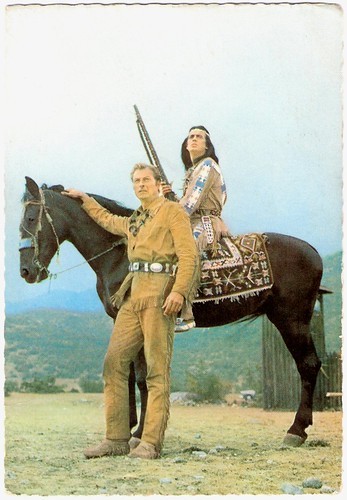
Lex Barker and Pierre Brice . German postcard, no. E 51. Photo: Constantin. Caption: Winnetou and Old Shatterhand discover a crime. Brinkley, known as Cornel, and his gang of criminals attacked the stagecoach and murdered Erik Engel, who had a secret plan with him on his way to the legendary "Treasure in Silver Lake".
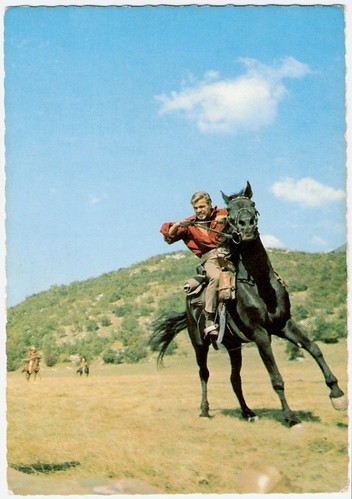
Götz George . German postcard, no. E 52. Photo: Constantin. Caption: When Angel's son Fred, who works on Butler's farm, learns of his father's murder, he immediately sets off to find the perpetrator.
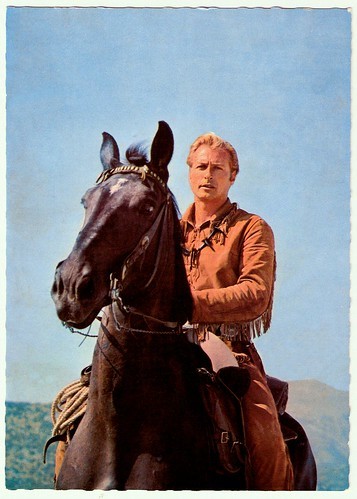
Lex Barker . German postcard, no. E 53. Photo: Constantin. Caption: Fred meets Old Shatterhand, who promises to help him find the Cornel. Winnetou, however, wants to keep an eye on the gang of criminals.

Pierre Brice . German postcard, no. E 54. Photo: Constantin. Caption:
Winnetou discovers the bandits' hiding place, overhears their advice and learns that the sketch is incomplete. The other half of the plan is in the hands of Patterson, who is on Butler's farm with his daughter Ellen.
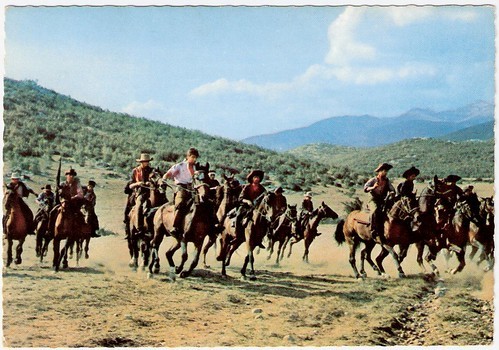
German postcard, no. E 55. Photo: Constantin. Caption: As soon as Old Shatterhand and Fred arrive at Butler's farm, the gang rushes to besiege the farm.
Old Shatterhand
Although it was a Western, Der Schatz im Silbersee was a truly European film, a co-production of Germany, Yugoslavia, and France. The film starred Hollywood star Lex Barker in the role of Old Shatterhand.
Barker was best known as a former Tarzan, who played the King of the Jungle in films like Tarzan's Magic Fountain (Lee Sholem, 1949) and Tarzan's Peril (Byron Haskin, 1951). He had also appeared in Westerns like the film adaptation of James Fennimore Cooper's The Deerslayer (Kurt Neumann, 1957), which had been very successful in Germany.
When his Hollywood career dried up, Lex Barker moved to Italy. There he appeared as a Hollywood movie star in La Dolce Vita/The Sweet Life (Federico Fellini, 1960) starring Marcello Mastroianni .
German producer Artur Brauner invited him to work in Germany, where he starred in such crime films as Das Stahlnetz des dr. Mabuse/The Return of Dr. Mabuse (Harald Reinl, 1961) opposite Gert Fröbe. Then the role of Old Shatterhand made him a cult star.
At his side, Pierre Brice played Apache-chief Winnetou. It made the till then unknown French actor an icon of the 1960s. The supporting cast was also an international mix. British Herbert Lom was cast as the bad Colonel Brinkley.
From Germany, there were the young lovers Karin Dor and Götz George . Grand Old lady Marianne Hoppe had her first international film role and for the laughs, Eddi Arent (Lord Castlepool) and Ralf Wolter (Trapper Sam Hawkins) can be seen.
There were also many Yugoslavian actors in the cast, including Mirko Boman (Gunstick Uncle), Sima Janicijevic a.k.a. Jan Sid (Patterson) and Jozo Kovacevic (Grosser Wolf).
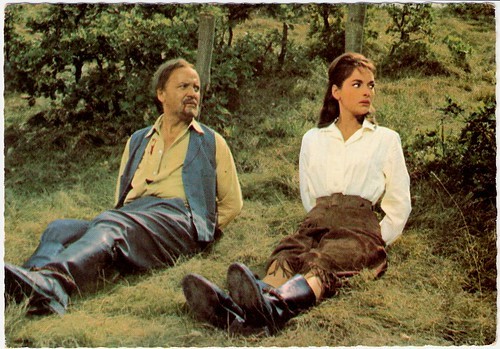
Karin Dor and Jan Sid . German postcard, no. E 56. Photo: Constantin. Caption: Patterson and his daughter Ellen, who had ridden out, fall into the hands of the bandits. The Cornel demands the second half of the plan as a ransom.
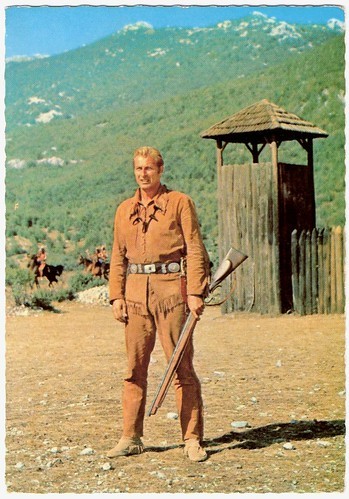
Lex Barker . German postcard, no. E 57. Photo: Constantin. Caption: Old Shatterhand and Fred manage to free Patterson and his daughter Ellen and to get them to the farm through a secret passage.
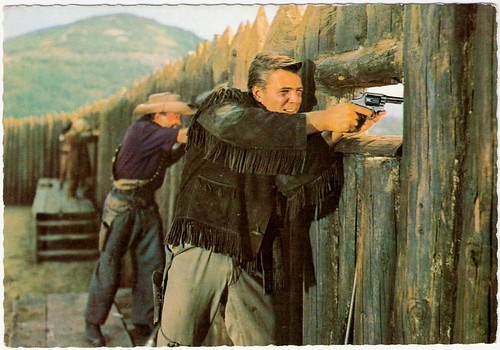
Götz George . German postcard, no. E 58. Photo: Constantin. Caption: The Cornel now runs furiously against the walls of the farm with his gang, and there is a hot fight for life and death.
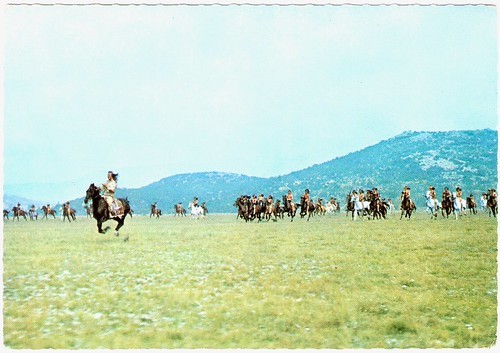
German postcard, no. E 59. Photo: Constantin. Caption: Winnetou arrives at the last minute. Together with the friend of the Osage tribe, he hurries to help the afflicted on Butler's farm.
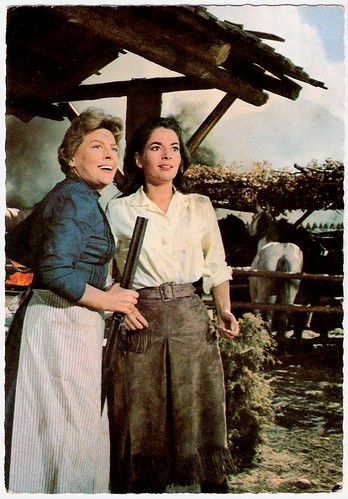
Marianne Hoppe and Karin Dor . German postcard, no. E 60. Photo: Constantin. Caption: Mrs. Butler and Ellen watch the beaten criminal gang pulling away with joy and satisfaction.
Non-stop action
Der Schatz im Silbersee/Treasure of Silver Lake (Harald Reinl, 1962) was the first film adaptation of a novel by Karl May set in the American West.
Karl May (1842-1912) was one of the best-read authors of Germany, and many kids played Cowboys and Indians, inspired by May's stories.
Earlier films after his exotic adventure novels were all set in the Near East. The first was Die Teufelsanbeter/The Devil Worshippers (Marie Luise Droop, 1920) starring 'the Indiana Jones of the 1910s and 1920s' Carl de Vogt and Béla Lugosi. A later example was Die Sklavenkarawane/The Slave Caravan (Georg Marischka, Ramón Torrado, 1958) with Viktor Staal as Kara Ben Nemsi.
However, the principal shooting took place in national park Paklenica karst river canyon, Yugoslavia (now Croatia). The result was surprising.
John Seal at IMDb : "Treasure of Silver Lake is one of the most entertaining films I've ever seen. Establishing the template for every euro-western that followed, it features non-stop action, beautiful scenery (unfortunately compromised by the pan and scan version recently aired on Encore Westerns), and an amusing and watchable cast. Like most euro-westerns, the film is more sympathetic to Native Americans than a typical Hollywood movie, but the Indians aren't really the focal point of the story".
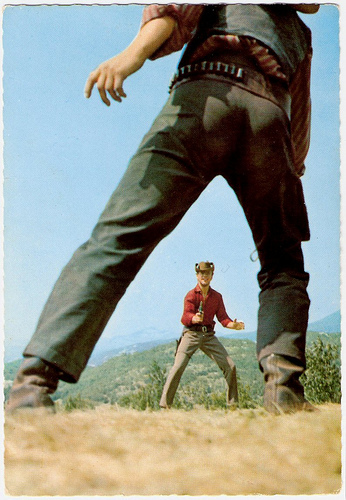
Götz George . German postcard, no. E 61. Photo: Constantin. Caption: Fred pursues the Cornel and he manages to take the first half of the plan from him. However, the killer himself escapes.
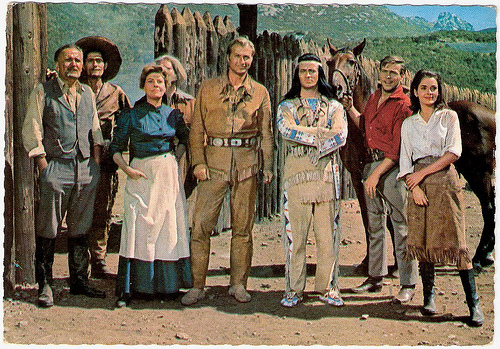
German postcard, no. E 62. Photo: Constantin. Caption: Happy with the liberation, the residents of Butler's Farm say goodbye to their friends, the Osage. At the same time, the search for the "treasure in the silver lake" is decided.
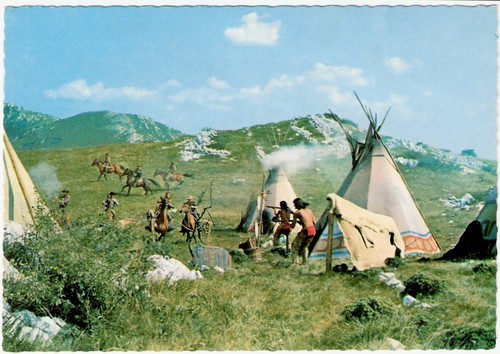
German postcard, no. E 63. Photo: Constantin. Caption: The Cornel, however, wants to prevent the others from advancing. He sets fire to a village of the Utah Indians and, with this diabolical plan, makes the Utahs take revenge on all white people.
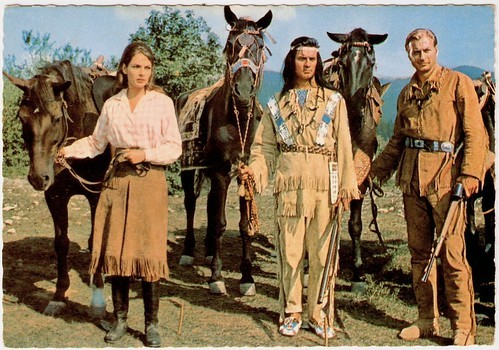
Karin Dor, Pierre Brice and Lex Barker . German postcard, no. E 64. Photo: Constantin. Caption: Winnetou, Old Shatterhand, and their friends are stunned in front of the burned village. Ellen, moving away from the group, is kidnapped by gang observers. Now the Cornel triumphs.
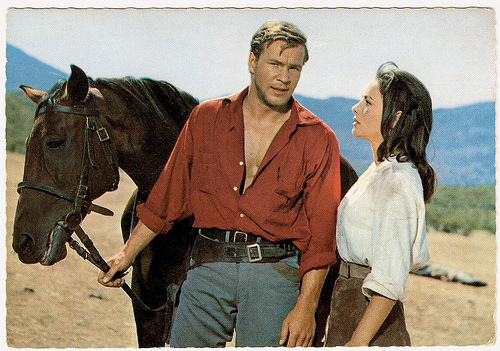
Götz George and Karin Dor . German postcard, no. E 65. Photo: Constantin. Caption: Hurrying to help Ellen, Fred volunteers to join the gang. He promises to lead the bandits to the silver lake in order to sell his and Ellen's freedom.
Successful track
The Old Shatterhand-Melodie, the title melody played on the harmonica by René Giessen and composed by Martin Böttcher was the most successful track in the German hit parade in the 1960s. It stayed there for several months and over 100,000 copies were sold.
At the time that was very unusual, especially for a soundtrack without any singers. The music was played by members of the symphony-orchestra of the Norddeutscher Rundfunk.
The theme was later also recorded as a vocal track by several singers, including a version by Pierre Brice .
Composer Böttcher wrote in 1955 the music for his first film, Der Hauptmann und sein Held/The Captain and His Hero (Max Nosseck, 1955).
Already his next film Die Halbstarken/Teenage Wolfpack (Georg Tressler, 1956) starring Horst Buchholz , was a great artistic success for himself. He became one of the busiest composers for Cinema and TV in Germany.

German postcard, no. E 66. Photo: Constantin. Caption: In the opinion that Old Shatterhand and his friends set fire to the village, the Utahs, led by their chief "Big Wolf", capture the small expedition.
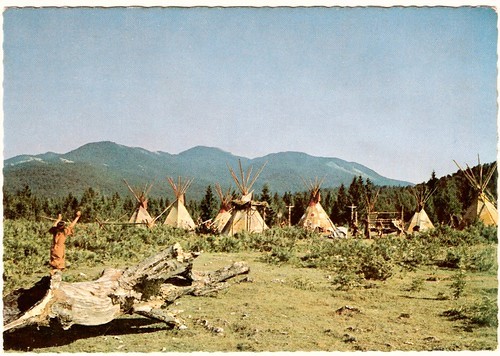
German postcard, no. E 67. Photo: Constantin. Caption: Old Shatterhand and his friends arrive in the Utah village. Nobody knows yet what will happen to the whites.
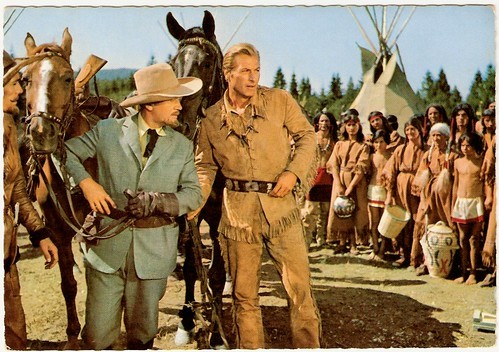
Jan Sid and Lex Barker. German postcard, no. E 68. Photo: Constantin. Caption: Old Shatterhand and Patterson are worried about Ellen and Fred because they wanted to be in front of the gang at Silver Lake.
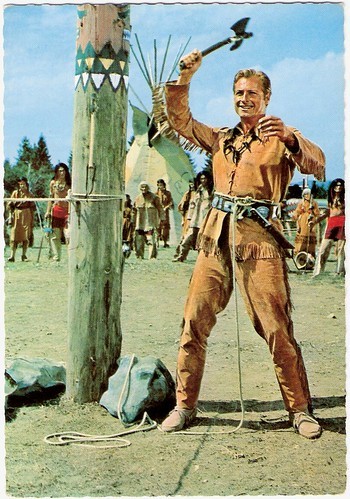
German postcard, no. E 69. Photo: Constantin. Caption: The Utah Council decides the judgment of God: Old Shatterhand is supposed to fight with the Utah chief.
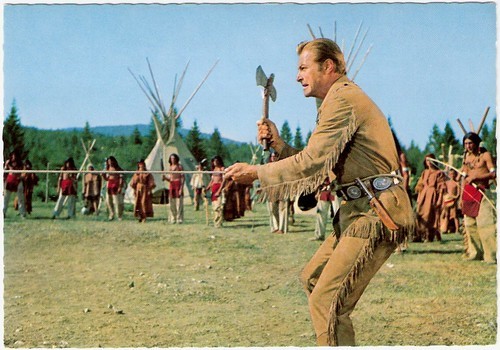
German postcard, no. E 70. Photo: Constantin. Caption: The winner should live, the loser should die.
Bambi
German director Harald Reinl and producer Horst Wendlandt came up with a series of Eurowesterns which didn´t copy the American Western.
The American trade magazine Variety wrote in 1963 that 'See' was obviously better than the average Hollywood Western: "Although there are the inevitable fistfights and shoot-outs, the film does not copy the Hollywood format, but has a more philosophical (European!) Touch. The Western (filmed in Cinemascope) also benefits from the wonderful landscapes."
The European audiences loved it and Der Schatz im Silbersee/Treasure of Silver Lake became a huge success. It was the very first German film to receive the Goldene Leinwand (Golden Screen) for having over 3 million visitors within 12 months.
The film also won the Bambi-award 1963 as best 'box-office-production' and also received a sum of 200,000 DM from the government in 1963 as a film-prize.
Der Schatz im Silbersee was sold to 60 countries - an incredible success for the European film industry.
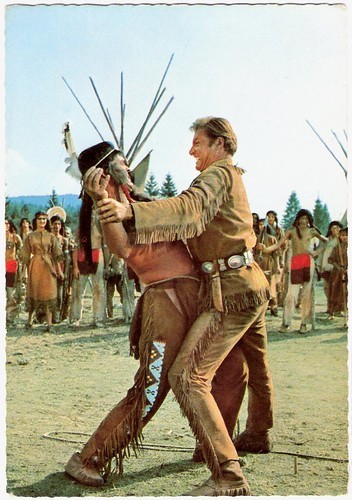
German postcard, no. E 71. Photo: Constantin. Caption: The powerful chief is an equal opponent for Old Shatterhand.
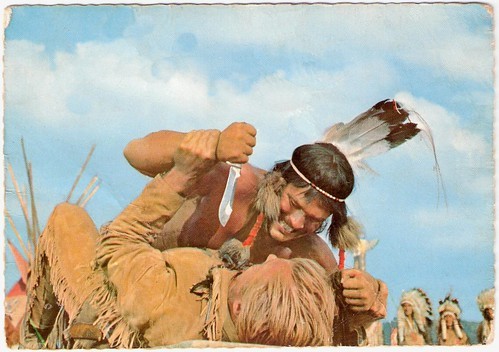
German postcard, no. E 72. Photo: Constantin. Caption: Old Shatterhand falls. He defeats his opponent with his last strength but spares his life.
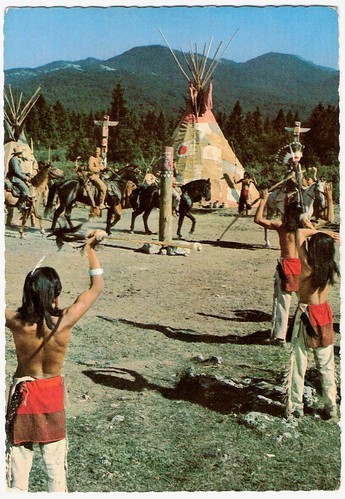
German postcard, no. E 73. Photo: Constantin. Caption: In the general turmoil, the whites manage to pull off unhindered. They have lost a lot of time and hurry to Silver Lake as quickly as possible.

German postcard, no. E 74. Photo: Constantin. Caption: There is a delay again. A Utah headman swears private vengeance and pursues the whites. Winnetou uses a trick.
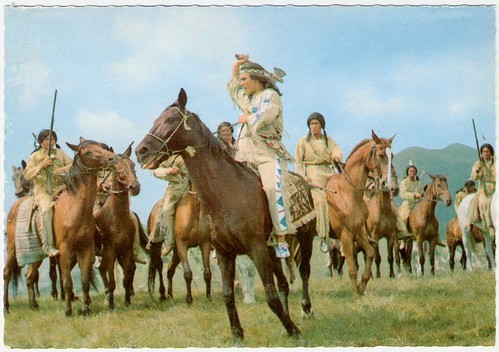
German postcard, no. E 75. Photo: Constantin. Caption: Winnetou lures the Utahs into a canyon. The rushing chief "Big Wolf" can restore peace and joins Old Shatterhand and Winnetou.
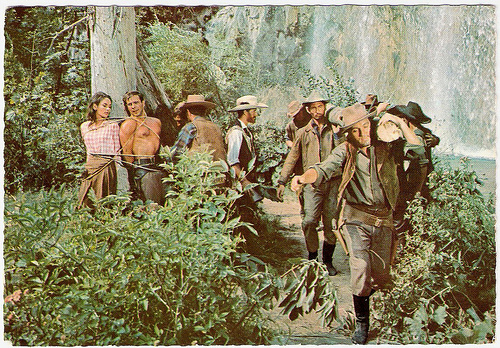
Götz George and Karin Dor . German postcard, no. E 76. Photo: Constantin. Caption: Fred delay tactic fails. The gang reaches the silver lake in front of Old Shatterhand. Tied up, Fred and Ellen have to watch the gang build a raft to reach the cave with the treasure.
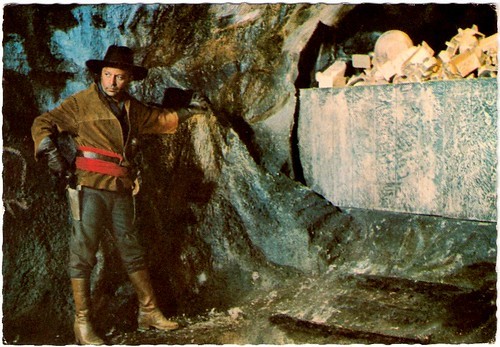
Herbert Lom . German postcard, no. E 77. Photo: Constantin. Caption: The Cornel and four of his cronies reach the cave and overwhelm the guardian of the treasure, an ancient blind Indian.
A popular sub-genre
Although Der Schatz im Silbersee/Treasure of Silver Lake introduced Old-Shatterhand ( Lex Barker ) and Apache-chief Winnetou ( Pierre Brice ), Der Schatz im Silbersee is set in the time after the sequel Winnetou - 1. Teil/Apache Gold (Harald Reinl, 1963).
This would not be the only sequel. Between 1962 and 1968, 11 Eurowesterns were produced based on the novels by Karl May.
The early films preceded also another popular European film sub-genre, the Spaghetti Western.
And Eastern-Germany had its own Indian films, produced by the DEFA studio. Between 1966 and 1979 there were 12 East-German Westerns, often starring Serbian actor Gojko Mitic , who became an equally popular Icon in Eastern Europe as Pierre Brice was in West Europe.

Herbert Lom . German postcard, no. E 78. Photo: Constantin. Caption: Possessed by the gold rush, the criminals kill each other. The Cornel also has his deserved fate. The dying Indian triggers a mechanism and the bandit sinks with the treasure.
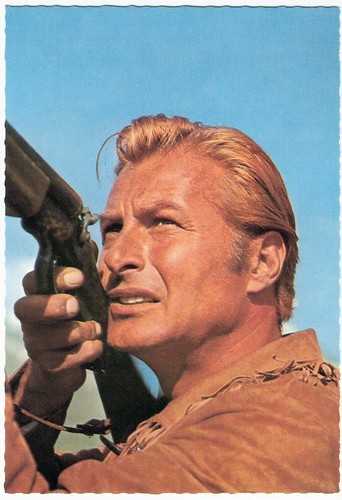
German postcard, no. E 79. Photo: Constantin. Caption: Since the Cornel has not returned, the gang wants to hang Fred. Old Shatterhand who hurried in time shoots the rope and thus saves Fred's life.
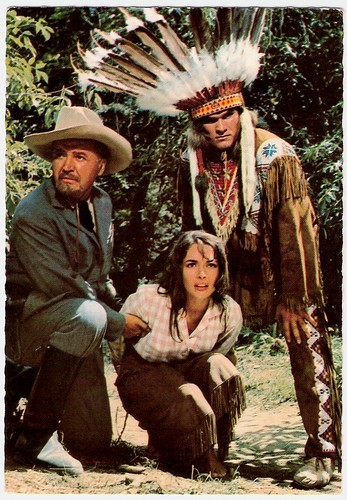
Karin Dor and Jan Sid . German postcard, no. E 80. Photo: Constantin. Caption: At the same time, Patterson and the "Big Wolf" can free Ellen, and the Utah Indians help destroy the rest of the gang.
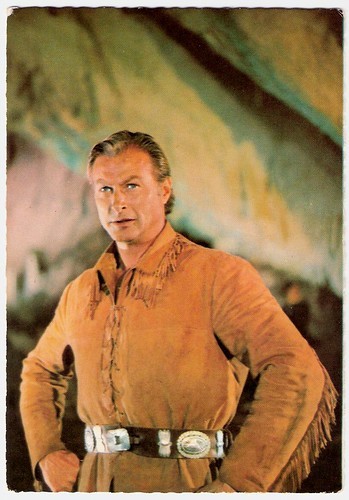
German postcard, no. E 81. Photo: Constantin. Caption: Old Shatterhand and Winnetou enter the cave. They see that the treasure of Silver Lake has sunk forever.
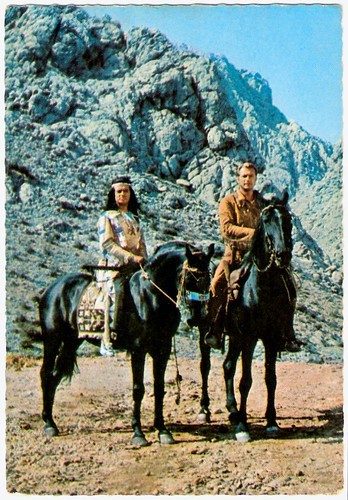
German postcard, no. E 82. Photo: Constantin. Caption: After a friendly farewell to the Utahs and white friends, Winnetou and Old Shatterhand ride towards new adventures.
Sources: Bernd Desinger & Matthias Knop (Der Schatz im Silbersee), IMDb and Wikipedia (German).

Lex Barker and Pierre Brice . German postcard, no. E 51. Photo: Constantin. Caption: Winnetou and Old Shatterhand discover a crime. Brinkley, known as Cornel, and his gang of criminals attacked the stagecoach and murdered Erik Engel, who had a secret plan with him on his way to the legendary "Treasure in Silver Lake".

Götz George . German postcard, no. E 52. Photo: Constantin. Caption: When Angel's son Fred, who works on Butler's farm, learns of his father's murder, he immediately sets off to find the perpetrator.

Lex Barker . German postcard, no. E 53. Photo: Constantin. Caption: Fred meets Old Shatterhand, who promises to help him find the Cornel. Winnetou, however, wants to keep an eye on the gang of criminals.

Pierre Brice . German postcard, no. E 54. Photo: Constantin. Caption:
Winnetou discovers the bandits' hiding place, overhears their advice and learns that the sketch is incomplete. The other half of the plan is in the hands of Patterson, who is on Butler's farm with his daughter Ellen.

German postcard, no. E 55. Photo: Constantin. Caption: As soon as Old Shatterhand and Fred arrive at Butler's farm, the gang rushes to besiege the farm.
Old Shatterhand
Although it was a Western, Der Schatz im Silbersee was a truly European film, a co-production of Germany, Yugoslavia, and France. The film starred Hollywood star Lex Barker in the role of Old Shatterhand.
Barker was best known as a former Tarzan, who played the King of the Jungle in films like Tarzan's Magic Fountain (Lee Sholem, 1949) and Tarzan's Peril (Byron Haskin, 1951). He had also appeared in Westerns like the film adaptation of James Fennimore Cooper's The Deerslayer (Kurt Neumann, 1957), which had been very successful in Germany.
When his Hollywood career dried up, Lex Barker moved to Italy. There he appeared as a Hollywood movie star in La Dolce Vita/The Sweet Life (Federico Fellini, 1960) starring Marcello Mastroianni .
German producer Artur Brauner invited him to work in Germany, where he starred in such crime films as Das Stahlnetz des dr. Mabuse/The Return of Dr. Mabuse (Harald Reinl, 1961) opposite Gert Fröbe. Then the role of Old Shatterhand made him a cult star.
At his side, Pierre Brice played Apache-chief Winnetou. It made the till then unknown French actor an icon of the 1960s. The supporting cast was also an international mix. British Herbert Lom was cast as the bad Colonel Brinkley.
From Germany, there were the young lovers Karin Dor and Götz George . Grand Old lady Marianne Hoppe had her first international film role and for the laughs, Eddi Arent (Lord Castlepool) and Ralf Wolter (Trapper Sam Hawkins) can be seen.
There were also many Yugoslavian actors in the cast, including Mirko Boman (Gunstick Uncle), Sima Janicijevic a.k.a. Jan Sid (Patterson) and Jozo Kovacevic (Grosser Wolf).

Karin Dor and Jan Sid . German postcard, no. E 56. Photo: Constantin. Caption: Patterson and his daughter Ellen, who had ridden out, fall into the hands of the bandits. The Cornel demands the second half of the plan as a ransom.

Lex Barker . German postcard, no. E 57. Photo: Constantin. Caption: Old Shatterhand and Fred manage to free Patterson and his daughter Ellen and to get them to the farm through a secret passage.

Götz George . German postcard, no. E 58. Photo: Constantin. Caption: The Cornel now runs furiously against the walls of the farm with his gang, and there is a hot fight for life and death.

German postcard, no. E 59. Photo: Constantin. Caption: Winnetou arrives at the last minute. Together with the friend of the Osage tribe, he hurries to help the afflicted on Butler's farm.

Marianne Hoppe and Karin Dor . German postcard, no. E 60. Photo: Constantin. Caption: Mrs. Butler and Ellen watch the beaten criminal gang pulling away with joy and satisfaction.
Non-stop action
Der Schatz im Silbersee/Treasure of Silver Lake (Harald Reinl, 1962) was the first film adaptation of a novel by Karl May set in the American West.
Karl May (1842-1912) was one of the best-read authors of Germany, and many kids played Cowboys and Indians, inspired by May's stories.
Earlier films after his exotic adventure novels were all set in the Near East. The first was Die Teufelsanbeter/The Devil Worshippers (Marie Luise Droop, 1920) starring 'the Indiana Jones of the 1910s and 1920s' Carl de Vogt and Béla Lugosi. A later example was Die Sklavenkarawane/The Slave Caravan (Georg Marischka, Ramón Torrado, 1958) with Viktor Staal as Kara Ben Nemsi.
However, the principal shooting took place in national park Paklenica karst river canyon, Yugoslavia (now Croatia). The result was surprising.
John Seal at IMDb : "Treasure of Silver Lake is one of the most entertaining films I've ever seen. Establishing the template for every euro-western that followed, it features non-stop action, beautiful scenery (unfortunately compromised by the pan and scan version recently aired on Encore Westerns), and an amusing and watchable cast. Like most euro-westerns, the film is more sympathetic to Native Americans than a typical Hollywood movie, but the Indians aren't really the focal point of the story".

Götz George . German postcard, no. E 61. Photo: Constantin. Caption: Fred pursues the Cornel and he manages to take the first half of the plan from him. However, the killer himself escapes.

German postcard, no. E 62. Photo: Constantin. Caption: Happy with the liberation, the residents of Butler's Farm say goodbye to their friends, the Osage. At the same time, the search for the "treasure in the silver lake" is decided.

German postcard, no. E 63. Photo: Constantin. Caption: The Cornel, however, wants to prevent the others from advancing. He sets fire to a village of the Utah Indians and, with this diabolical plan, makes the Utahs take revenge on all white people.

Karin Dor, Pierre Brice and Lex Barker . German postcard, no. E 64. Photo: Constantin. Caption: Winnetou, Old Shatterhand, and their friends are stunned in front of the burned village. Ellen, moving away from the group, is kidnapped by gang observers. Now the Cornel triumphs.

Götz George and Karin Dor . German postcard, no. E 65. Photo: Constantin. Caption: Hurrying to help Ellen, Fred volunteers to join the gang. He promises to lead the bandits to the silver lake in order to sell his and Ellen's freedom.
Successful track
The Old Shatterhand-Melodie, the title melody played on the harmonica by René Giessen and composed by Martin Böttcher was the most successful track in the German hit parade in the 1960s. It stayed there for several months and over 100,000 copies were sold.
At the time that was very unusual, especially for a soundtrack without any singers. The music was played by members of the symphony-orchestra of the Norddeutscher Rundfunk.
The theme was later also recorded as a vocal track by several singers, including a version by Pierre Brice .
Composer Böttcher wrote in 1955 the music for his first film, Der Hauptmann und sein Held/The Captain and His Hero (Max Nosseck, 1955).
Already his next film Die Halbstarken/Teenage Wolfpack (Georg Tressler, 1956) starring Horst Buchholz , was a great artistic success for himself. He became one of the busiest composers for Cinema and TV in Germany.

German postcard, no. E 66. Photo: Constantin. Caption: In the opinion that Old Shatterhand and his friends set fire to the village, the Utahs, led by their chief "Big Wolf", capture the small expedition.

German postcard, no. E 67. Photo: Constantin. Caption: Old Shatterhand and his friends arrive in the Utah village. Nobody knows yet what will happen to the whites.

Jan Sid and Lex Barker. German postcard, no. E 68. Photo: Constantin. Caption: Old Shatterhand and Patterson are worried about Ellen and Fred because they wanted to be in front of the gang at Silver Lake.

German postcard, no. E 69. Photo: Constantin. Caption: The Utah Council decides the judgment of God: Old Shatterhand is supposed to fight with the Utah chief.

German postcard, no. E 70. Photo: Constantin. Caption: The winner should live, the loser should die.
Bambi
German director Harald Reinl and producer Horst Wendlandt came up with a series of Eurowesterns which didn´t copy the American Western.
The American trade magazine Variety wrote in 1963 that 'See' was obviously better than the average Hollywood Western: "Although there are the inevitable fistfights and shoot-outs, the film does not copy the Hollywood format, but has a more philosophical (European!) Touch. The Western (filmed in Cinemascope) also benefits from the wonderful landscapes."
The European audiences loved it and Der Schatz im Silbersee/Treasure of Silver Lake became a huge success. It was the very first German film to receive the Goldene Leinwand (Golden Screen) for having over 3 million visitors within 12 months.
The film also won the Bambi-award 1963 as best 'box-office-production' and also received a sum of 200,000 DM from the government in 1963 as a film-prize.
Der Schatz im Silbersee was sold to 60 countries - an incredible success for the European film industry.

German postcard, no. E 71. Photo: Constantin. Caption: The powerful chief is an equal opponent for Old Shatterhand.

German postcard, no. E 72. Photo: Constantin. Caption: Old Shatterhand falls. He defeats his opponent with his last strength but spares his life.

German postcard, no. E 73. Photo: Constantin. Caption: In the general turmoil, the whites manage to pull off unhindered. They have lost a lot of time and hurry to Silver Lake as quickly as possible.

German postcard, no. E 74. Photo: Constantin. Caption: There is a delay again. A Utah headman swears private vengeance and pursues the whites. Winnetou uses a trick.

German postcard, no. E 75. Photo: Constantin. Caption: Winnetou lures the Utahs into a canyon. The rushing chief "Big Wolf" can restore peace and joins Old Shatterhand and Winnetou.

Götz George and Karin Dor . German postcard, no. E 76. Photo: Constantin. Caption: Fred delay tactic fails. The gang reaches the silver lake in front of Old Shatterhand. Tied up, Fred and Ellen have to watch the gang build a raft to reach the cave with the treasure.

Herbert Lom . German postcard, no. E 77. Photo: Constantin. Caption: The Cornel and four of his cronies reach the cave and overwhelm the guardian of the treasure, an ancient blind Indian.
A popular sub-genre
Although Der Schatz im Silbersee/Treasure of Silver Lake introduced Old-Shatterhand ( Lex Barker ) and Apache-chief Winnetou ( Pierre Brice ), Der Schatz im Silbersee is set in the time after the sequel Winnetou - 1. Teil/Apache Gold (Harald Reinl, 1963).
This would not be the only sequel. Between 1962 and 1968, 11 Eurowesterns were produced based on the novels by Karl May.
The early films preceded also another popular European film sub-genre, the Spaghetti Western.
And Eastern-Germany had its own Indian films, produced by the DEFA studio. Between 1966 and 1979 there were 12 East-German Westerns, often starring Serbian actor Gojko Mitic , who became an equally popular Icon in Eastern Europe as Pierre Brice was in West Europe.

Herbert Lom . German postcard, no. E 78. Photo: Constantin. Caption: Possessed by the gold rush, the criminals kill each other. The Cornel also has his deserved fate. The dying Indian triggers a mechanism and the bandit sinks with the treasure.

German postcard, no. E 79. Photo: Constantin. Caption: Since the Cornel has not returned, the gang wants to hang Fred. Old Shatterhand who hurried in time shoots the rope and thus saves Fred's life.

Karin Dor and Jan Sid . German postcard, no. E 80. Photo: Constantin. Caption: At the same time, Patterson and the "Big Wolf" can free Ellen, and the Utah Indians help destroy the rest of the gang.

German postcard, no. E 81. Photo: Constantin. Caption: Old Shatterhand and Winnetou enter the cave. They see that the treasure of Silver Lake has sunk forever.

German postcard, no. E 82. Photo: Constantin. Caption: After a friendly farewell to the Utahs and white friends, Winnetou and Old Shatterhand ride towards new adventures.
Sources: Bernd Desinger & Matthias Knop (Der Schatz im Silbersee), IMDb and Wikipedia (German).
Published on May 24, 2020 22:00
May 23, 2020
Wallace Beery
American actor Wallace Beery (1885-1949) is best known for his portrayal of Bill in Min and Bill opposite Marie Dressler, as Long John Silver in Treasure Island, as Pancho Villa in Viva Villa!, and his titular role in The Champ, for which he won the Academy Award for Best Actor. Beery appeared in some 250 films in a 36-year career. He was the brother of actor Noah Beery, Sr. and uncle of actor Noah Beery, Jr.
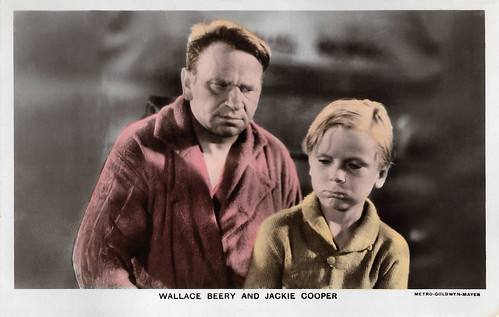
British postcard in the Film Partners Series, London, no. PC 71. Photo: Metro-Goldwyn-Mayer (MGM). Wallace Beery and Jackie Cooper in The Champ (King Vidor, 1931).
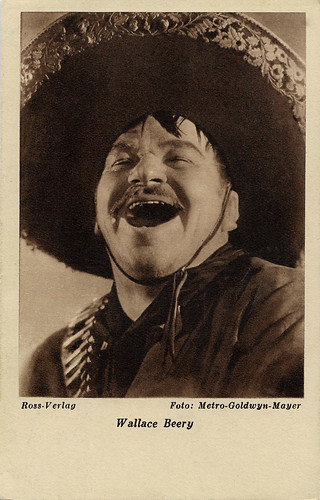
German postcard by Ross Verlag for Das Programm von Heute, Berlin. Photo: Metro Goldwyn Mayer. Wallace Beery in Viva Villa! (Jack Conway, 1934).
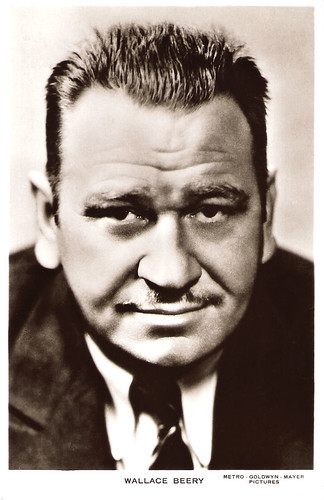
British Real Photograph postcard. Photo: Metro-Goldwyn-Mayer Pictures.
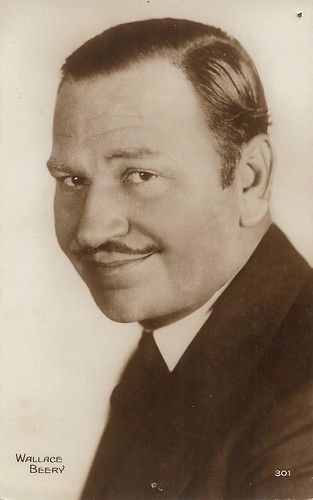
French postcard by Editions Cinémagazine, no. 301.
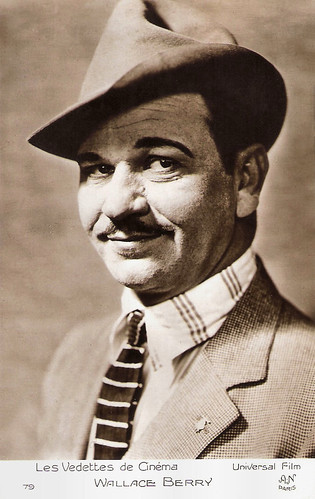
French postcard in the Les Vedettes de Cinéma Series by A.N., Paris, no. 79. Photo: Universal Film. Beery's name is misspelled as Berry.
Sweedie, The Swedish Maid
Wallace Fitzgerald Beery was born in Clay County, US, in 1885. He was the youngest son of Noah Webster Beery and Frances Margaret Fitzgerald and he and his brothers William C. Beery and Noah Beery became Hollywood actors.
Wallace attended the Chase School in Kansas City and took piano lessons as well, but showed little love for academic matters. Beery ran away from home at age 16 and joined the Ringling Brothers Circus as an assistant elephant trainer. He left two years later, after being clawed by a leopard.
In 1904, Wallace joined his brother Noah in New York City, finding work in comic opera as a baritone and began to appear on Broadway as well as Summer stock theatre. His most notable early role came in 1907 when he starred in The Yankee Tourist to good reviews.
In 1913, he moved to Chicago to work for Essanay Studios, cast as Sweedie, The Swedish Maid, a masculine character in drag. Later, he worked for the Essanay Studios location in Niles, California. In 1915, Beery starred with Ben Turpin and his wife Gloria Swanson in Sweedie Goes to College (Richard Foster Baker, 1915). This marriage did not survive his drinking and abuse.
Beery began playing villains, and in 1917 portrayed Pancho Villa in Patria (Jacques Jaccard, Leopold Wharton, Theodore Wharton, 1917) at a time when Villa was still active in Mexico. Beery reprised the role seventeen years later in one of MGM's biggest hits.
Beery's notable silent films include The Last of the Mohicans (Maurice Tourneur, 1920), Robin Hood (Allan Dwan, 1922) with Douglas Fairbanks (Beery played King Richard the Lionheart in this film and a sequel the following year called Richard the Lion-Hearted), Arthur Conan Doyle's dinosaur epic The Lost World (Harry Hoyt, 1925), and Beggars of Life (William A. Wellman, 1928) with Louise Brooks .
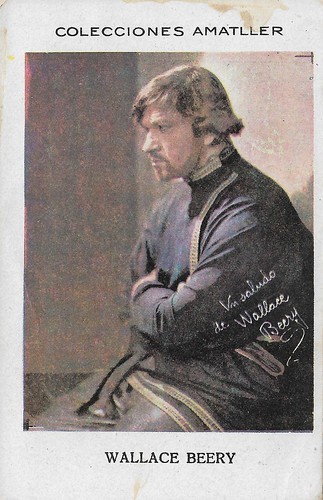
Spanish collectors card by Chocolate Amatller, Series J, artist 13, no. 39. Photo: Wallace Beery in Bavu (Stuart Paton, 1923).

Italian postcard by G.B. Falci. Photo: Paramount. Wallace Beery and Raymond Hatton in the American comedy We're in the Navy Now (Edward Sutherland, 1926).
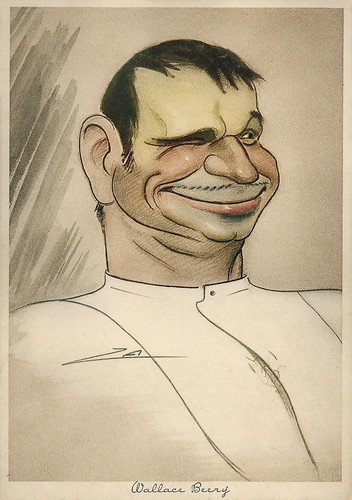
Italian postcard by ZMC (Eliocromia Zacchelli e C., Milano), no. A. 62. Caricature: Nino ZA.
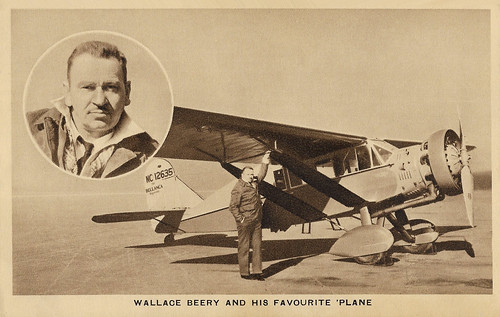
British postcard. Caption: Wallace Beery and his favourite plane.
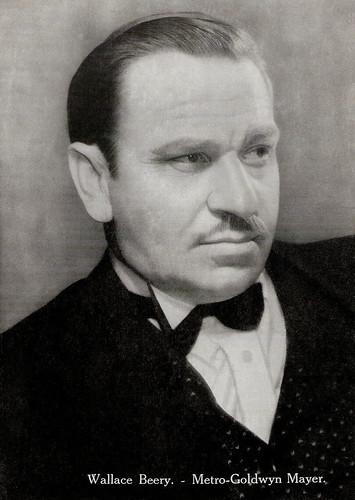
Dutch postcard by Smeets & Schippers, Amsterdam. Photo: Metro-Goldwyn-Mayer.
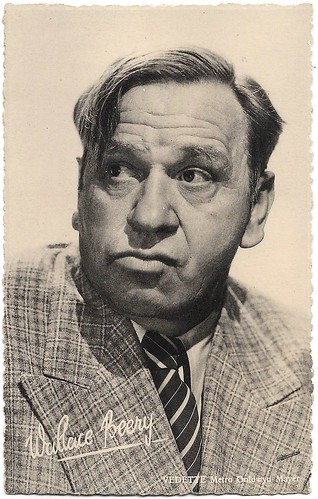
Belgian postcard by Kwatta. Bilingual text on the back, praising Kwatta chocolate.
The highest-paid actor in the world
Wallace Beery's powerful basso voice and gruff, deliberate drawl soon became assets when Irving Thalberg hired him under contract to Metro-Goldwyn-Mayer as a character actor during the dawn of the sound film era.
Beery played the savage convict 'Butch', a role originally intended for Lon Chaney, Sr. , in the highly successful prison film The Big House (George W. Hill, 1930), for which he was nominated for the Oscar for Best Actor.
The same year, he made Min and Bill (George W. Hill, 1930) opposite Marie Dressler. This film vaulted him into the box office first rank.
He followed with The Champ (King Vidor, 1931), this time winning the Best Actor Oscar, and the role of Long John Silver in Treasure Island (Victor Fleming, 1934).
He received a gold medal from the Venice Film Festival for his performance as Pancho Villa in Viva Villa! (Jack Conway, 1934) with Fay Wray.
Other Beery films include Grand Hotel (Edmund Goulding, 1932) with Joan Crawford , Tugboat Annie (Mervyn Leroy, 1933) with Marie Dressler, Dinner at Eight (George Cukor, 1933) opposite Jean Harlow , and China Seas (Tay Garnett, 1935) with Gable and Harlow.
During the 1930s Beery was one of Hollywood's Top 10 box office stars, and at one point his contract with MGM stipulated that he be paid $1 more than any other contract player at the studio, making him the highest-paid actor in the world.

British postcard in the Film Partners Series, London, no. P 71. Photo: Metro-Goldwyn-Mayer (MGM). Wallace Beery and Jackie Cooper in The Champ (King Vidor, 1931).
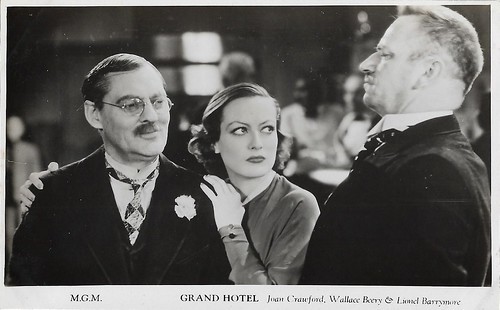
British postcard in the Filmshots series by Film Weekly. Photo: M.G.M. Joan Crawford , Wallace Beery, and Lionel Barrymore in Grand Hotel (Edmund Goulding, 1932).
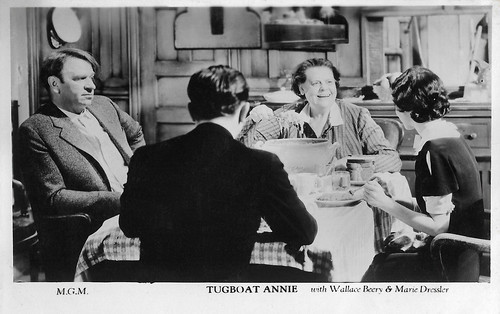
British postcard in the Filmshots series by Film Weekly. Photo: M.G.M. Wallace Beery and Marie Dressler in Tugboat Annie (Mervyn LeRoy, 1933).
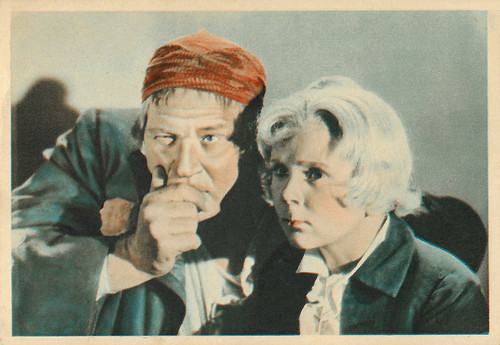
British postcard by De Reszke Cigarettes, no. 46. Photo: Metro-Goldwyn-Mayer (MGM). Wallace Beery and Jackie Cooper in Treasure Island (Victor Fleming, 1934).
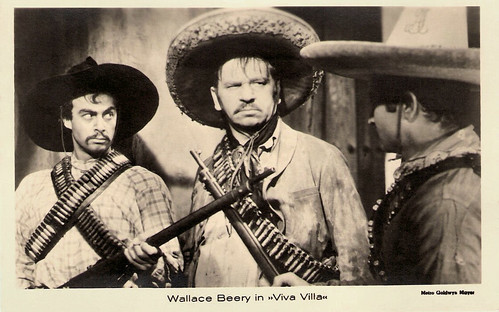
Dutch postcard by M.B. & Z., no. 5737. Photo: Metro-Goldwyn-Mayer (MGM). Wallace Beery in Viva Villa! (Jack Conway, 1934).
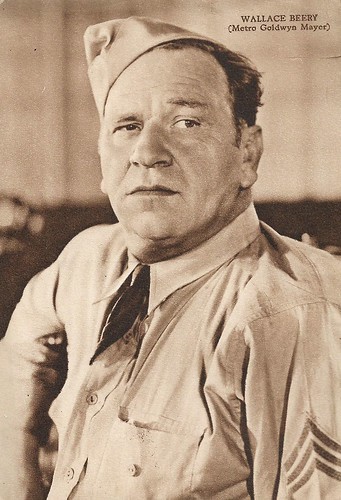
Italian postcard by Rizzoli, 1936. Photo: Metro-Goldwyn-Mayer. Wallace Beery in Westpoint of the Air (Richard Rosson, 1935).
Popular in the South
Wallace Beery starred in several films with Marjorie Main, but his career began to decline in his last decade.
In 1943 his brother Noah Beery, Sr. appeared with him in the war-time propaganda film Salute to the Marines (S. Sylvan Simon, 1943).
He remained top-billed and none of Beery's films during the sound era lost money at the box office; his films were particularly popular in the Southern regions of the United States, especially small towns and cities.
Beery's first wife was actress Gloria Swanson ; the two performed onscreen together. Although Beery had enjoyed popularity with his Sweedie shorts, his career had taken a dip, and during the marriage to Swanson, he relied on her as a breadwinner.
According to Swanson's autobiography, Beery raped her on their wedding night and later tricked her into swallowing an abortifacient when she was pregnant, which caused her to lose their child.
Beery's second wife was Rita Gilman. They adopted Carol Ann, daughter of Rita Beery's cousin. Both marriages ended in divorce.
In December 1939, the unmarried Beery adopted a seven-month-old infant girl Phyllis Ann. Phyllis appeared in MGM publicity photos when adopted, but was never mentioned again. Beery told the press he had taken the girl in from a single mother, recently divorced, but filed no official adoption papers. No further information on the child appears to exist, and she is not mentioned in Beery's obituary.
Wallace Beery died at his Beverly Hills, California home of a heart attack in 1949.
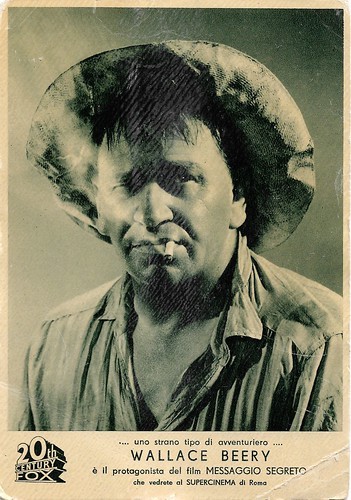
Italian postcard. Photo: 20th Century Fox. Wallace Beery in Messaggio Segreto, Italian release title for the American adventure spy film A Message to Garcia (George Marshall, 1936). The film was released at the Supercinema in Rome. The building of the former Supercinema still exists and is now the Teatro Nazionale.
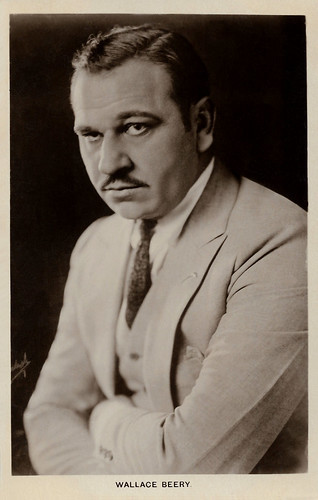
British postcard in the Picturegoer Series, London, no. 151. Photo: Roman Freulich.

British postcard in the Picturegoer Series, London, no. 151b.
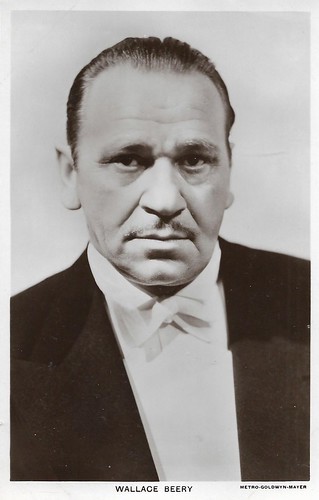
British postcard in the Picturegoer Series, London, no. 151c.
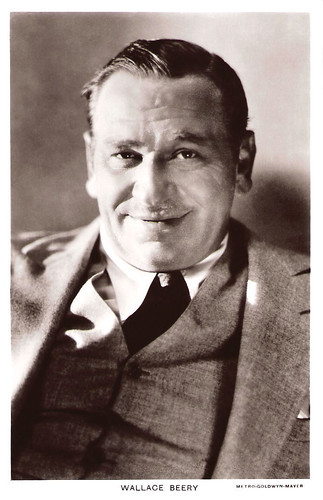
British postcard in the Picturegoer Series, London, no. 151d. Photo: Metro-Goldwyn-Mayer.
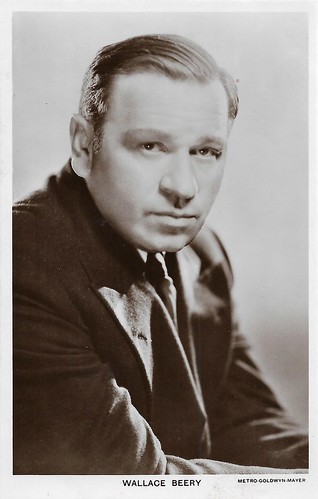
British postcard by Picturegoer. Photo: Metro-Goldwyn-Mayer.
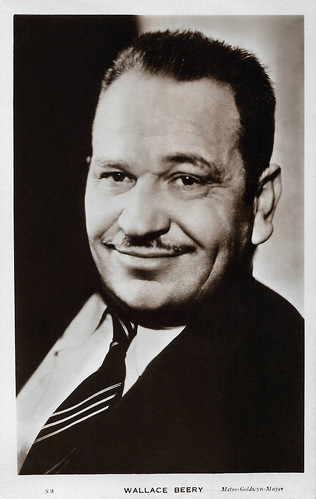
British postcard by W & G, Ltd, no. S 9. Photo: Metro-Goldwyn-Mayer.
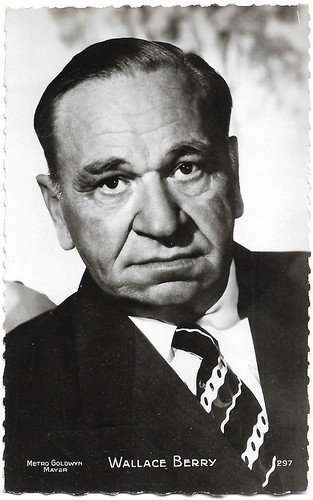
French postcard by Editions P.I., Paris, no. 297. Photo: Metro-Goldwyn-Mayer, 1946.
Sources: Wikipedia and .

British postcard in the Film Partners Series, London, no. PC 71. Photo: Metro-Goldwyn-Mayer (MGM). Wallace Beery and Jackie Cooper in The Champ (King Vidor, 1931).

German postcard by Ross Verlag for Das Programm von Heute, Berlin. Photo: Metro Goldwyn Mayer. Wallace Beery in Viva Villa! (Jack Conway, 1934).

British Real Photograph postcard. Photo: Metro-Goldwyn-Mayer Pictures.

French postcard by Editions Cinémagazine, no. 301.

French postcard in the Les Vedettes de Cinéma Series by A.N., Paris, no. 79. Photo: Universal Film. Beery's name is misspelled as Berry.
Sweedie, The Swedish Maid
Wallace Fitzgerald Beery was born in Clay County, US, in 1885. He was the youngest son of Noah Webster Beery and Frances Margaret Fitzgerald and he and his brothers William C. Beery and Noah Beery became Hollywood actors.
Wallace attended the Chase School in Kansas City and took piano lessons as well, but showed little love for academic matters. Beery ran away from home at age 16 and joined the Ringling Brothers Circus as an assistant elephant trainer. He left two years later, after being clawed by a leopard.
In 1904, Wallace joined his brother Noah in New York City, finding work in comic opera as a baritone and began to appear on Broadway as well as Summer stock theatre. His most notable early role came in 1907 when he starred in The Yankee Tourist to good reviews.
In 1913, he moved to Chicago to work for Essanay Studios, cast as Sweedie, The Swedish Maid, a masculine character in drag. Later, he worked for the Essanay Studios location in Niles, California. In 1915, Beery starred with Ben Turpin and his wife Gloria Swanson in Sweedie Goes to College (Richard Foster Baker, 1915). This marriage did not survive his drinking and abuse.
Beery began playing villains, and in 1917 portrayed Pancho Villa in Patria (Jacques Jaccard, Leopold Wharton, Theodore Wharton, 1917) at a time when Villa was still active in Mexico. Beery reprised the role seventeen years later in one of MGM's biggest hits.
Beery's notable silent films include The Last of the Mohicans (Maurice Tourneur, 1920), Robin Hood (Allan Dwan, 1922) with Douglas Fairbanks (Beery played King Richard the Lionheart in this film and a sequel the following year called Richard the Lion-Hearted), Arthur Conan Doyle's dinosaur epic The Lost World (Harry Hoyt, 1925), and Beggars of Life (William A. Wellman, 1928) with Louise Brooks .

Spanish collectors card by Chocolate Amatller, Series J, artist 13, no. 39. Photo: Wallace Beery in Bavu (Stuart Paton, 1923).

Italian postcard by G.B. Falci. Photo: Paramount. Wallace Beery and Raymond Hatton in the American comedy We're in the Navy Now (Edward Sutherland, 1926).

Italian postcard by ZMC (Eliocromia Zacchelli e C., Milano), no. A. 62. Caricature: Nino ZA.

British postcard. Caption: Wallace Beery and his favourite plane.

Dutch postcard by Smeets & Schippers, Amsterdam. Photo: Metro-Goldwyn-Mayer.

Belgian postcard by Kwatta. Bilingual text on the back, praising Kwatta chocolate.
The highest-paid actor in the world
Wallace Beery's powerful basso voice and gruff, deliberate drawl soon became assets when Irving Thalberg hired him under contract to Metro-Goldwyn-Mayer as a character actor during the dawn of the sound film era.
Beery played the savage convict 'Butch', a role originally intended for Lon Chaney, Sr. , in the highly successful prison film The Big House (George W. Hill, 1930), for which he was nominated for the Oscar for Best Actor.
The same year, he made Min and Bill (George W. Hill, 1930) opposite Marie Dressler. This film vaulted him into the box office first rank.
He followed with The Champ (King Vidor, 1931), this time winning the Best Actor Oscar, and the role of Long John Silver in Treasure Island (Victor Fleming, 1934).
He received a gold medal from the Venice Film Festival for his performance as Pancho Villa in Viva Villa! (Jack Conway, 1934) with Fay Wray.
Other Beery films include Grand Hotel (Edmund Goulding, 1932) with Joan Crawford , Tugboat Annie (Mervyn Leroy, 1933) with Marie Dressler, Dinner at Eight (George Cukor, 1933) opposite Jean Harlow , and China Seas (Tay Garnett, 1935) with Gable and Harlow.
During the 1930s Beery was one of Hollywood's Top 10 box office stars, and at one point his contract with MGM stipulated that he be paid $1 more than any other contract player at the studio, making him the highest-paid actor in the world.

British postcard in the Film Partners Series, London, no. P 71. Photo: Metro-Goldwyn-Mayer (MGM). Wallace Beery and Jackie Cooper in The Champ (King Vidor, 1931).

British postcard in the Filmshots series by Film Weekly. Photo: M.G.M. Joan Crawford , Wallace Beery, and Lionel Barrymore in Grand Hotel (Edmund Goulding, 1932).

British postcard in the Filmshots series by Film Weekly. Photo: M.G.M. Wallace Beery and Marie Dressler in Tugboat Annie (Mervyn LeRoy, 1933).

British postcard by De Reszke Cigarettes, no. 46. Photo: Metro-Goldwyn-Mayer (MGM). Wallace Beery and Jackie Cooper in Treasure Island (Victor Fleming, 1934).

Dutch postcard by M.B. & Z., no. 5737. Photo: Metro-Goldwyn-Mayer (MGM). Wallace Beery in Viva Villa! (Jack Conway, 1934).

Italian postcard by Rizzoli, 1936. Photo: Metro-Goldwyn-Mayer. Wallace Beery in Westpoint of the Air (Richard Rosson, 1935).
Popular in the South
Wallace Beery starred in several films with Marjorie Main, but his career began to decline in his last decade.
In 1943 his brother Noah Beery, Sr. appeared with him in the war-time propaganda film Salute to the Marines (S. Sylvan Simon, 1943).
He remained top-billed and none of Beery's films during the sound era lost money at the box office; his films were particularly popular in the Southern regions of the United States, especially small towns and cities.
Beery's first wife was actress Gloria Swanson ; the two performed onscreen together. Although Beery had enjoyed popularity with his Sweedie shorts, his career had taken a dip, and during the marriage to Swanson, he relied on her as a breadwinner.
According to Swanson's autobiography, Beery raped her on their wedding night and later tricked her into swallowing an abortifacient when she was pregnant, which caused her to lose their child.
Beery's second wife was Rita Gilman. They adopted Carol Ann, daughter of Rita Beery's cousin. Both marriages ended in divorce.
In December 1939, the unmarried Beery adopted a seven-month-old infant girl Phyllis Ann. Phyllis appeared in MGM publicity photos when adopted, but was never mentioned again. Beery told the press he had taken the girl in from a single mother, recently divorced, but filed no official adoption papers. No further information on the child appears to exist, and she is not mentioned in Beery's obituary.
Wallace Beery died at his Beverly Hills, California home of a heart attack in 1949.

Italian postcard. Photo: 20th Century Fox. Wallace Beery in Messaggio Segreto, Italian release title for the American adventure spy film A Message to Garcia (George Marshall, 1936). The film was released at the Supercinema in Rome. The building of the former Supercinema still exists and is now the Teatro Nazionale.

British postcard in the Picturegoer Series, London, no. 151. Photo: Roman Freulich.

British postcard in the Picturegoer Series, London, no. 151b.

British postcard in the Picturegoer Series, London, no. 151c.

British postcard in the Picturegoer Series, London, no. 151d. Photo: Metro-Goldwyn-Mayer.

British postcard by Picturegoer. Photo: Metro-Goldwyn-Mayer.

British postcard by W & G, Ltd, no. S 9. Photo: Metro-Goldwyn-Mayer.

French postcard by Editions P.I., Paris, no. 297. Photo: Metro-Goldwyn-Mayer, 1946.
Sources: Wikipedia and .
Published on May 23, 2020 22:00
May 22, 2020
New in the GDR Cinemas in 1968
Around 1980, I went to Berlin with my three best friends. We were 20, New Wave fans and did a lot of unforgettable things. One was visiting Communist East-Berlin. We were controlled at Station Friedrichstrasse and my friend Peer and I were picked out of the line, probably because of our Punk-style outfits. We got the special control treatment and were photographed in front of coloured walls. In my pocket, the patrol found a cultural magazine from West-Berlin with on the front a picture of an Isabelle Adjani film with a couple in bed, fully dressed. This kind of 'porn' was not allowed to take into the GDR! I always wondered afterward what filmgoers did see in the East-Berlin cinemas. Lately, I found this little pocket with small collectors cards published by Progress: 'Neu im Kino'(New in the cinema). The nine cards (one is lost) offer a glimpse of what was shown in an East-Berlin cinema in 1968.
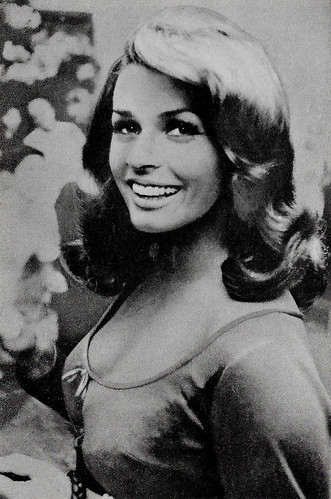
East-German collectors card in the 'Neu im Kino' series by VEB Progress Film-Vertrieb, Berlin, no. 500/6/68. Photo: G.B. Poletto and Peter Basch. Senta Berger in the crime comedy Operazione San Gennaro/The Treasure of San Gennaro (Dino Risi, 1966). In this Italian-French-West-German co-production, an American gangster in Italy enlists a local gang to help him steal the treasure of Naples' patron saint
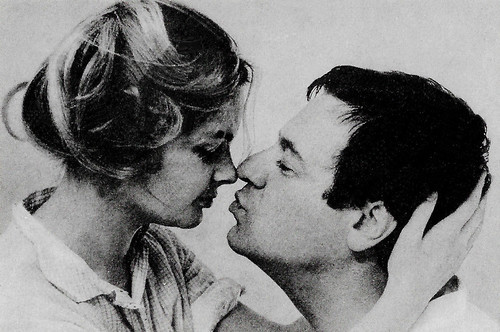
East-German collectors card in the 'Neu im Kino' series by VEB Progress Film-Vertrieb, Berlin, no. 500/6/68. Sabine Sinjen and Hans-Dieter Schwarze in the West-German drama Alle Jahre wieder/Next Year, Same Time (Ulrich Schamoni, 1967). The advertising editor Hannes Lücke spends the Christmas holiday every year with his family in Münster. He has his new girlfriend, Inge, in a hotel waiting.
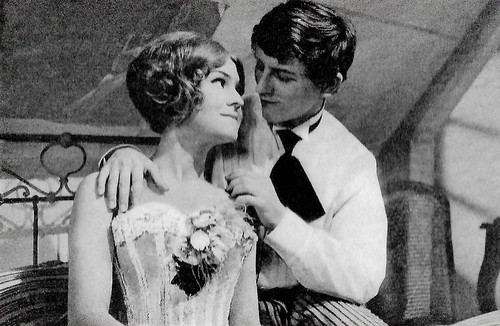
East-German collectors card in the 'Neu im Kino' series by VEB Progress Film-Vertrieb, Berlin, no. 500/6/68. Pavlina Filipovská and Václav Neckár in the Czech musical comedy Ta nase písnicka ceská/Melodies from Old Prague (Zdenek Podskalský, 1967). In old Prague, a girl has to choose between three guys.
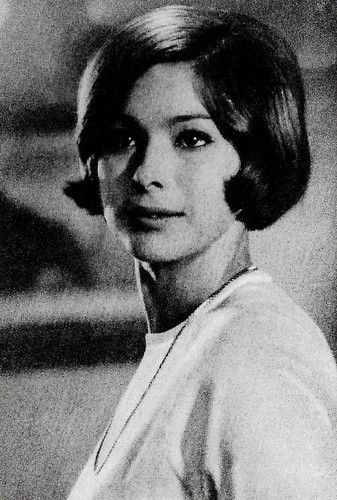
East-German collectors card in the 'Neu im Kino' series by VEB Progress Film-Vertrieb, Berlin, no. 500/6/68. Monika Gabriel in Wir lassen uns scheiden/We Are Getting Divorced (Ingrid Reschke, 1968). In Berlin, Monika and Johannes decide to separate and agree that both should have their 10-years-old son for four weeks each.
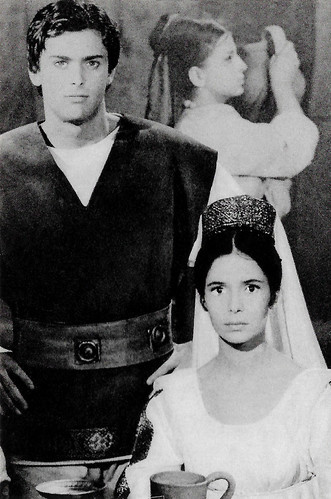
East-German collectors card in the 'Neu im Kino' series by VEB Progress Film-Vertrieb, Berlin, no. 500/6/68. Marie-José Nat and Alexandru Herescu in the Romanian-French historical drama Dacii/The Dacians (Sergiu Nicolaescu, 1966). The Dacian kingdom lies at the eastern border of the Roman Empire. Only the Danube separates the two mortal enemies. The Dacian king Decebalus knows that soon the vastly superior Roman legions will cross the river and attack Dacia.
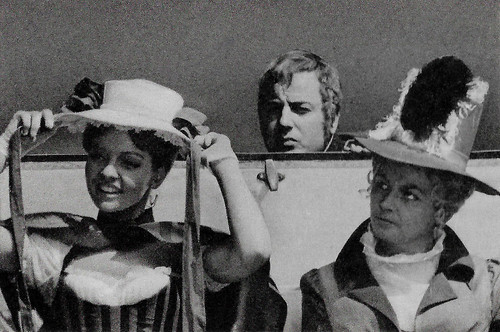
East-German collectors card in the 'Neu im Kino' series by VEB Progress Film-Vertrieb, Berlin, no. 500/6/68. Manfred Krug in the East-German comedy Hauptmann Florian von der Mühle/Captain Florian of the Mill (Werner W. Wallroth, 1968). This story of the miller Florian, who gave all his money to the war against Napoleon, is loosely based on a true story.
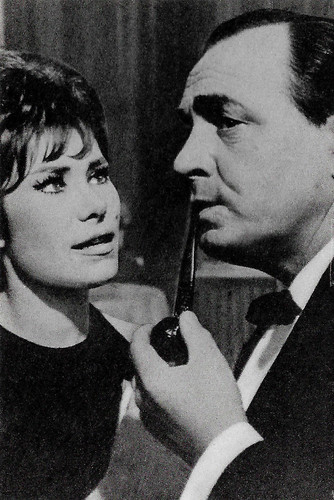
East-German collectors card in the 'Neu im Kino' series by VEB Progress Film-Vertrieb, Berlin, no. 500/6/68. Kai Fischer and Paul Klinger in the West-German thriller Das Wirtshaus von Dartmoor/The Inn on Dartmoor (Rudolf Zehetgruber, 1964). A private detective tries to find out how and why some convicts have mysteriously disappeared from the prison of Dartmoor.
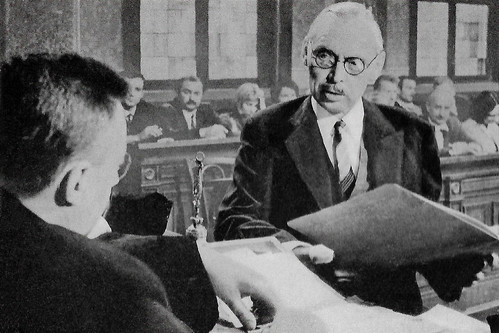
East-German collectors card in the 'Neu im Kino' series by VEB Progress Film-Vertrieb, Berlin, no. 500/6/68. Publicity still for the East-German crime drama Der Mord, der nie verjährt/The Murder That Was Never Recognized (Wolfgang Luderer, 1968). A historical court case in 1929 against the editor of the magazine Das Tage-Buch, who is accused of insult and slander. In an article in the magazine, Jörn's suitability for the office of the Reich Attorney was questioned, since, in 1919, he favored the murderers of Rosa Luxemburg and Karl Liebknecht.
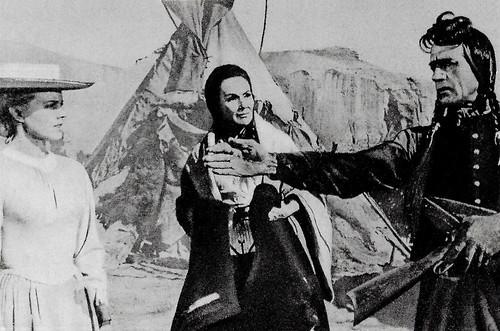
East-German collectors card in the 'Neu im Kino' series by VEB Progress Film-Vertrieb, Berlin, no. 500/6/68. Carroll Baker , Dolores del Río, and Ricardo Montalban in the American Western Cheyenne Autumn (John Ford, 1964). The Cheyenne, tired of broken U.S. government promises, head for their ancestral lands but a sympathetic cavalry officer is tasked to bring them back to their reservation.
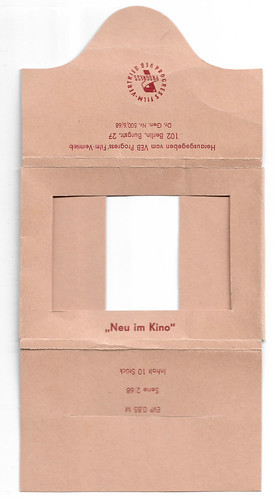
Pocket for East-German collectors cards in the 'Neu im Kino' series by VEB Progress Film-Vertrieb, Berlin, no. 500/6/68.
Sources: Wikipedia (German) and IMDb.

East-German collectors card in the 'Neu im Kino' series by VEB Progress Film-Vertrieb, Berlin, no. 500/6/68. Photo: G.B. Poletto and Peter Basch. Senta Berger in the crime comedy Operazione San Gennaro/The Treasure of San Gennaro (Dino Risi, 1966). In this Italian-French-West-German co-production, an American gangster in Italy enlists a local gang to help him steal the treasure of Naples' patron saint

East-German collectors card in the 'Neu im Kino' series by VEB Progress Film-Vertrieb, Berlin, no. 500/6/68. Sabine Sinjen and Hans-Dieter Schwarze in the West-German drama Alle Jahre wieder/Next Year, Same Time (Ulrich Schamoni, 1967). The advertising editor Hannes Lücke spends the Christmas holiday every year with his family in Münster. He has his new girlfriend, Inge, in a hotel waiting.

East-German collectors card in the 'Neu im Kino' series by VEB Progress Film-Vertrieb, Berlin, no. 500/6/68. Pavlina Filipovská and Václav Neckár in the Czech musical comedy Ta nase písnicka ceská/Melodies from Old Prague (Zdenek Podskalský, 1967). In old Prague, a girl has to choose between three guys.

East-German collectors card in the 'Neu im Kino' series by VEB Progress Film-Vertrieb, Berlin, no. 500/6/68. Monika Gabriel in Wir lassen uns scheiden/We Are Getting Divorced (Ingrid Reschke, 1968). In Berlin, Monika and Johannes decide to separate and agree that both should have their 10-years-old son for four weeks each.

East-German collectors card in the 'Neu im Kino' series by VEB Progress Film-Vertrieb, Berlin, no. 500/6/68. Marie-José Nat and Alexandru Herescu in the Romanian-French historical drama Dacii/The Dacians (Sergiu Nicolaescu, 1966). The Dacian kingdom lies at the eastern border of the Roman Empire. Only the Danube separates the two mortal enemies. The Dacian king Decebalus knows that soon the vastly superior Roman legions will cross the river and attack Dacia.

East-German collectors card in the 'Neu im Kino' series by VEB Progress Film-Vertrieb, Berlin, no. 500/6/68. Manfred Krug in the East-German comedy Hauptmann Florian von der Mühle/Captain Florian of the Mill (Werner W. Wallroth, 1968). This story of the miller Florian, who gave all his money to the war against Napoleon, is loosely based on a true story.

East-German collectors card in the 'Neu im Kino' series by VEB Progress Film-Vertrieb, Berlin, no. 500/6/68. Kai Fischer and Paul Klinger in the West-German thriller Das Wirtshaus von Dartmoor/The Inn on Dartmoor (Rudolf Zehetgruber, 1964). A private detective tries to find out how and why some convicts have mysteriously disappeared from the prison of Dartmoor.

East-German collectors card in the 'Neu im Kino' series by VEB Progress Film-Vertrieb, Berlin, no. 500/6/68. Publicity still for the East-German crime drama Der Mord, der nie verjährt/The Murder That Was Never Recognized (Wolfgang Luderer, 1968). A historical court case in 1929 against the editor of the magazine Das Tage-Buch, who is accused of insult and slander. In an article in the magazine, Jörn's suitability for the office of the Reich Attorney was questioned, since, in 1919, he favored the murderers of Rosa Luxemburg and Karl Liebknecht.

East-German collectors card in the 'Neu im Kino' series by VEB Progress Film-Vertrieb, Berlin, no. 500/6/68. Carroll Baker , Dolores del Río, and Ricardo Montalban in the American Western Cheyenne Autumn (John Ford, 1964). The Cheyenne, tired of broken U.S. government promises, head for their ancestral lands but a sympathetic cavalry officer is tasked to bring them back to their reservation.

Pocket for East-German collectors cards in the 'Neu im Kino' series by VEB Progress Film-Vertrieb, Berlin, no. 500/6/68.
Sources: Wikipedia (German) and IMDb.
Published on May 22, 2020 22:00
May 21, 2020
Carl Raddatz
German actor Carl Raddatz (1912-2004) was much in demand by film producers in the 1940s and especially in the 1950s. He appeared in several Nazi Propaganda films, and he also gave Joseph Stalin a German voice. Through the years he would become one of the leading character actors of the German theatre.
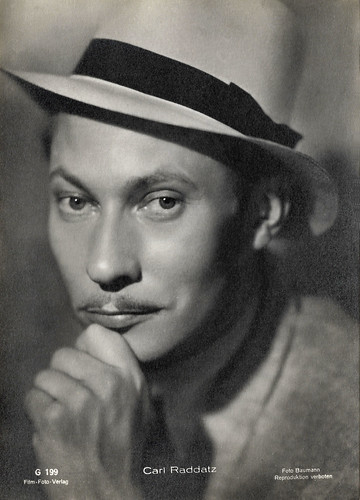
Big German card by Film-Foto-Verlag, no. G 199, 1941-1944. Photo: Baumann.
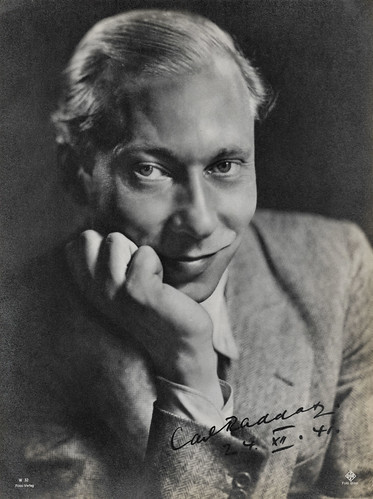
Big German card by Ross Verlag, no. W 32, 1941-1944. Photo: Binz / Ufa. Signed on 24 XII 1941.

Big German card by Film-Foto-Verlag, no. W 63, 1941-1944. Photo: Quick / Ufa. Signed on 24 December 1942.
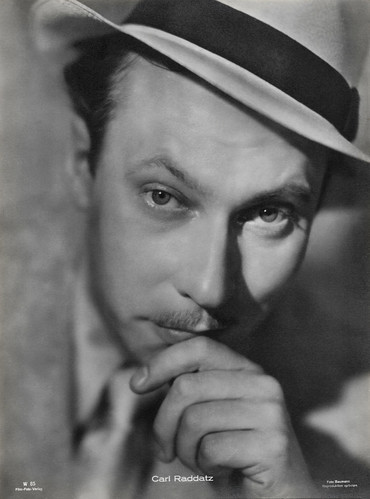
Big German card by Film-Foto-Verlag, no. W 85, 1941-1944. Photo: Baumann.
Nazi Propaganda films
Carl Raddatz was born as Karl Werner Fitz in Mannheim, Germany in 1912. His parents were insurance agent Karl Hermann Raddatz and Luisa Elisabetha Nußbickel.
He took acting lessons from Willy Birgel , who engaged him for the Mannheimer Nationaltheater. Engagements in Aachen, Darmstadt, Bremen and finally Berlin followed.
In Berlin he would have his greatest successes. In the Ufa studios in Babelsberg, he made his film debut in the Propaganda film Urlaub auf Ehrenwort/Furlough on Word of Honor (Karl Ritter, 1938). Soon followed more Ufa productions like Liebelei und Liebe/Flirtation and Love (Arthur Maria Rabenalt, 1938) with Paul Hörbiger as well as Verklungene Melodie/Dead Melody (Viktor Tourjansky, 1938) with Brigitte Horney .
In the next years, Raddatz became established as a star and appeared in well-known productions like Befreite Hände/Freed Hands (Hans Schweikart, 1939) opposite Olga Tschechova , Zwielicht/Twilight (Rudolph von der Noss, 1940) with Viktor Staal , Der 5. Juni/June the 5th (Fritz Kirchhoff, 1942), opposite Kristina Söderbaum in Immensee (Veit Harlan, 1943), and Opfergang/The Great Sacrifice (Veit Harlan, 1944).
He also starred in the poetic love-triangle Unter den Brücken/Under the Bridges (Helmut Käutner, 1945) with Hannelore Schroth and Gustav Knuth. Of his own films, director Helmut Käutner who was one of the major figures of post-War German cinema, considered this to be his best work.
He also played in Nazi Propaganda films like Wunschkonzert/Request Concert (Eduard von Borsody, 1940), Stukas (Karl Ritter, 1941), and Heimkehr/Homecoming (Gustav Ucicky, 1941), a justification of the German invasion of Poland.
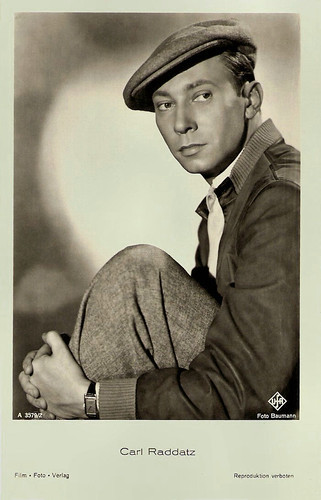
German postcard by Film-Foto-Verlag, no. A 3579/2, 1941-1944. Photo: Baumann / Ufa.
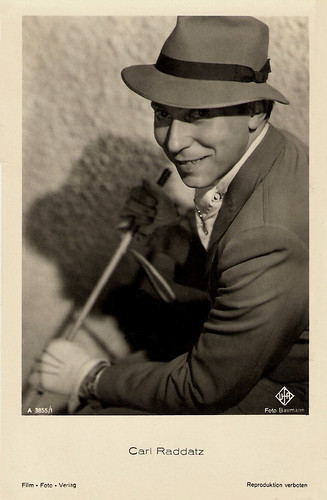
German postcard by Film-Foto-Verlag, no. A 3855/1, 1941-1944. Photo: Baumann / Ufa.
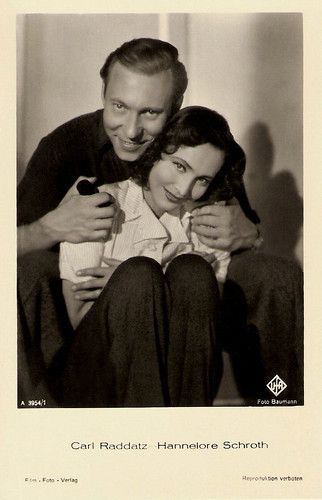
German postcard by Film-Foto-Verlag, no. A 3954/1, 1941-1944. Photo: Baumann / Ufa. Carl Raddatz and Hannelore Schroth .
A darling of the public
After the war, Carl Raddatz rather smoothly continued his career with films like the episode film In jenen Tagen/In Those Days (Helmut Käutner, 1946-1947), and Epilog/Epilogue (Helmut Käutner, 1950).
Next to these films, he worked mainly in the theatre. In the mid-1950s, he became a darling of the public with the films Rosen im Herbst/Roses in Autumn (Rudolf Jugert, 1955) with Ruth Leuwerik , Nacht der Entscheidung/Night of Decision (Falk Harnack, 1956) with Hilde Krahl , and Made in Germany (Wolfgang Schleiff, 1957) with Winnie Markus .
He also starred in the musical drama Gabriela (Géza von Cziffra, 1950) opposite Zarah Leander . It was Leander's comeback film after a seven-year absence from filmmaking and became the third highest-grossing film at the West German box office in 1950.
Other popular films were the dramas Regina Amstetten (Kurt Neumann, 1953) also starring Luise Ullrich , and Carl Esmond, and Das Mädchen Rosemarie/Rosemary (Rolf Thiele, 1958) with Nadja Tiller . The film portrays the scandal that surrounded the prostitute Rosemarie Nitribitt.
Giulietta Masina was his partner in the German-Italian co-production Jons und Erdme/La donna dell'altro/Jons and Erdma (Victor Vicas, 1959). It was an adaptation of Hermann Sudermann's story 'Jons and Erdma' from the collection 'The Excursion to Tilsit', about the troubled relationship between the strong-willed Erdma and her irascible husband Jons in the Lithuanian moors.
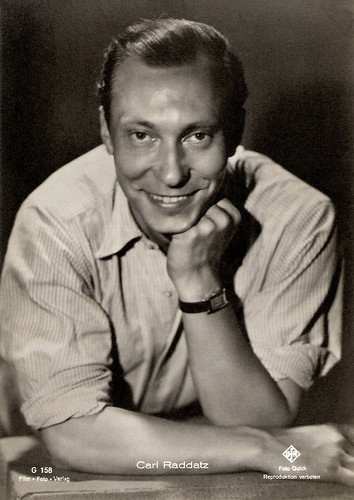
German postcard by Film-Foto-Verlag, no. 158. Photo: Foto Quick / Ufa.
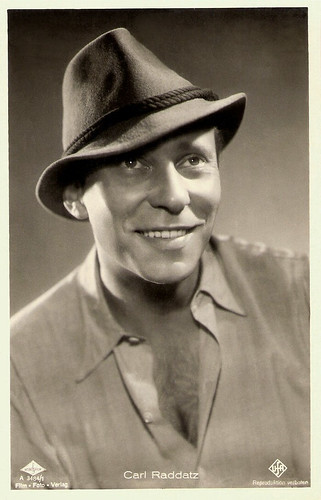
German postcard by Film-Foto-Verlag, no. A 3484/1, 1941-1944. Photo: Wien-Film / Ufa.
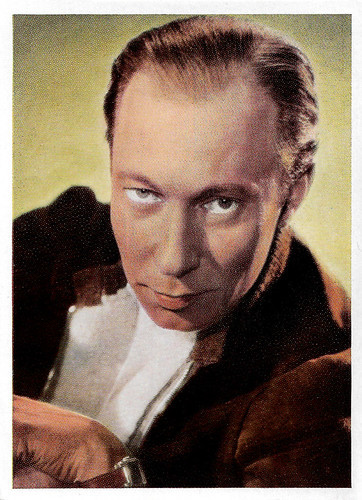
German collectors card in the "Deutsche Film-Lieblinge", series I.
Guild of Leading Character Actors
Carl Raddatz's film career ended slowly with The Counterfeit Traitor (George Seaton, 1962) starring William Holden, and finally, the Hans Fallada adaptation Jeder stirbt für sich allein/Everyone Dies Alone (Alfred Vohrer, 1975) with Hildegard Knef .
For TV, he appeared opposite Ruth Leuwerik in the series Die Buddenbrooks/The Buddenbrooks (1979) based on the classic novel by Thomas Mann, and in an episode of the popular crime series Derrick (1990).
He always remained true to the theatre. For years, he was a member of the ensemble of the Staatlichen Schauspielbühnen Berlin and played many interesting roles that heaved him to the guild of leading character actors.
In the 1950s, he had also dubbed stars like Humphrey Bogart, Robert Taylor, and Lee Marvin, and after WW II, he gave Joseph Stalin his voice on German TV. In 1972, he was awarded the Bundesverdienstkreuz (Order of Merit of the Federal Republic of Germany) and in 1979 the Filmband in Gold (German Film Award).
Carl Raddatz died in 2004 in Berlin. He was 92. Raddatz was married three times. His first wife was actress Hannelore Schroth , his partner in Unter den Brücken/Under the Bridges (1945).
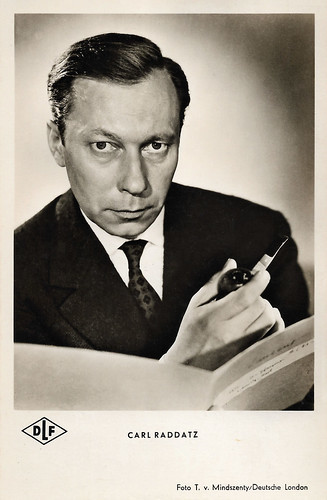
German postcard by Kunst und Bild, no. A 1189. Photo: T. v. Mindszenty / Deutsche London (TLF). Carl Raddatz in Geständnis unter vier Augen/Confession Under Four Eyes (André Michel, 1954).
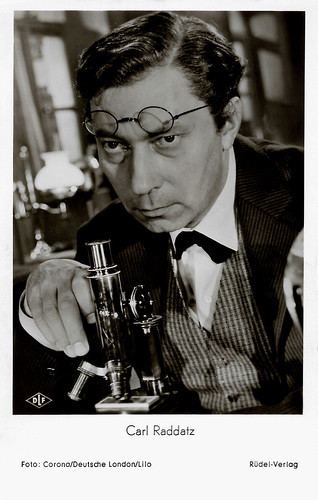
German postcard by Rüdel-Verlag, Hamburg-Bergedorf, no. 1923. Photo: Corona / Deutsche London (TLF) / Lilo. Carl Raddatz in Made in Germany (Wolfgang Schleif, 1957).
'Einmal wirst du wieder bei mir sein sein' (Once You Will Be With Me Again) performed by Carl Raddatz in Wir tanzen um die Welt/We Dance Around the World (Karl Anton, 1939). Source: Various Artists - Topic (YouTube).
Sources: Hans-Michael Bock (Filmportal.de - German), Thomas Staedeli (Cyranos), Wikipedia (German), and .

Big German card by Film-Foto-Verlag, no. G 199, 1941-1944. Photo: Baumann.

Big German card by Ross Verlag, no. W 32, 1941-1944. Photo: Binz / Ufa. Signed on 24 XII 1941.

Big German card by Film-Foto-Verlag, no. W 63, 1941-1944. Photo: Quick / Ufa. Signed on 24 December 1942.

Big German card by Film-Foto-Verlag, no. W 85, 1941-1944. Photo: Baumann.
Nazi Propaganda films
Carl Raddatz was born as Karl Werner Fitz in Mannheim, Germany in 1912. His parents were insurance agent Karl Hermann Raddatz and Luisa Elisabetha Nußbickel.
He took acting lessons from Willy Birgel , who engaged him for the Mannheimer Nationaltheater. Engagements in Aachen, Darmstadt, Bremen and finally Berlin followed.
In Berlin he would have his greatest successes. In the Ufa studios in Babelsberg, he made his film debut in the Propaganda film Urlaub auf Ehrenwort/Furlough on Word of Honor (Karl Ritter, 1938). Soon followed more Ufa productions like Liebelei und Liebe/Flirtation and Love (Arthur Maria Rabenalt, 1938) with Paul Hörbiger as well as Verklungene Melodie/Dead Melody (Viktor Tourjansky, 1938) with Brigitte Horney .
In the next years, Raddatz became established as a star and appeared in well-known productions like Befreite Hände/Freed Hands (Hans Schweikart, 1939) opposite Olga Tschechova , Zwielicht/Twilight (Rudolph von der Noss, 1940) with Viktor Staal , Der 5. Juni/June the 5th (Fritz Kirchhoff, 1942), opposite Kristina Söderbaum in Immensee (Veit Harlan, 1943), and Opfergang/The Great Sacrifice (Veit Harlan, 1944).
He also starred in the poetic love-triangle Unter den Brücken/Under the Bridges (Helmut Käutner, 1945) with Hannelore Schroth and Gustav Knuth. Of his own films, director Helmut Käutner who was one of the major figures of post-War German cinema, considered this to be his best work.
He also played in Nazi Propaganda films like Wunschkonzert/Request Concert (Eduard von Borsody, 1940), Stukas (Karl Ritter, 1941), and Heimkehr/Homecoming (Gustav Ucicky, 1941), a justification of the German invasion of Poland.

German postcard by Film-Foto-Verlag, no. A 3579/2, 1941-1944. Photo: Baumann / Ufa.

German postcard by Film-Foto-Verlag, no. A 3855/1, 1941-1944. Photo: Baumann / Ufa.

German postcard by Film-Foto-Verlag, no. A 3954/1, 1941-1944. Photo: Baumann / Ufa. Carl Raddatz and Hannelore Schroth .
A darling of the public
After the war, Carl Raddatz rather smoothly continued his career with films like the episode film In jenen Tagen/In Those Days (Helmut Käutner, 1946-1947), and Epilog/Epilogue (Helmut Käutner, 1950).
Next to these films, he worked mainly in the theatre. In the mid-1950s, he became a darling of the public with the films Rosen im Herbst/Roses in Autumn (Rudolf Jugert, 1955) with Ruth Leuwerik , Nacht der Entscheidung/Night of Decision (Falk Harnack, 1956) with Hilde Krahl , and Made in Germany (Wolfgang Schleiff, 1957) with Winnie Markus .
He also starred in the musical drama Gabriela (Géza von Cziffra, 1950) opposite Zarah Leander . It was Leander's comeback film after a seven-year absence from filmmaking and became the third highest-grossing film at the West German box office in 1950.
Other popular films were the dramas Regina Amstetten (Kurt Neumann, 1953) also starring Luise Ullrich , and Carl Esmond, and Das Mädchen Rosemarie/Rosemary (Rolf Thiele, 1958) with Nadja Tiller . The film portrays the scandal that surrounded the prostitute Rosemarie Nitribitt.
Giulietta Masina was his partner in the German-Italian co-production Jons und Erdme/La donna dell'altro/Jons and Erdma (Victor Vicas, 1959). It was an adaptation of Hermann Sudermann's story 'Jons and Erdma' from the collection 'The Excursion to Tilsit', about the troubled relationship between the strong-willed Erdma and her irascible husband Jons in the Lithuanian moors.

German postcard by Film-Foto-Verlag, no. 158. Photo: Foto Quick / Ufa.

German postcard by Film-Foto-Verlag, no. A 3484/1, 1941-1944. Photo: Wien-Film / Ufa.

German collectors card in the "Deutsche Film-Lieblinge", series I.
Guild of Leading Character Actors
Carl Raddatz's film career ended slowly with The Counterfeit Traitor (George Seaton, 1962) starring William Holden, and finally, the Hans Fallada adaptation Jeder stirbt für sich allein/Everyone Dies Alone (Alfred Vohrer, 1975) with Hildegard Knef .
For TV, he appeared opposite Ruth Leuwerik in the series Die Buddenbrooks/The Buddenbrooks (1979) based on the classic novel by Thomas Mann, and in an episode of the popular crime series Derrick (1990).
He always remained true to the theatre. For years, he was a member of the ensemble of the Staatlichen Schauspielbühnen Berlin and played many interesting roles that heaved him to the guild of leading character actors.
In the 1950s, he had also dubbed stars like Humphrey Bogart, Robert Taylor, and Lee Marvin, and after WW II, he gave Joseph Stalin his voice on German TV. In 1972, he was awarded the Bundesverdienstkreuz (Order of Merit of the Federal Republic of Germany) and in 1979 the Filmband in Gold (German Film Award).
Carl Raddatz died in 2004 in Berlin. He was 92. Raddatz was married three times. His first wife was actress Hannelore Schroth , his partner in Unter den Brücken/Under the Bridges (1945).

German postcard by Kunst und Bild, no. A 1189. Photo: T. v. Mindszenty / Deutsche London (TLF). Carl Raddatz in Geständnis unter vier Augen/Confession Under Four Eyes (André Michel, 1954).

German postcard by Rüdel-Verlag, Hamburg-Bergedorf, no. 1923. Photo: Corona / Deutsche London (TLF) / Lilo. Carl Raddatz in Made in Germany (Wolfgang Schleif, 1957).
'Einmal wirst du wieder bei mir sein sein' (Once You Will Be With Me Again) performed by Carl Raddatz in Wir tanzen um die Welt/We Dance Around the World (Karl Anton, 1939). Source: Various Artists - Topic (YouTube).
Sources: Hans-Michael Bock (Filmportal.de - German), Thomas Staedeli (Cyranos), Wikipedia (German), and .
Published on May 21, 2020 22:00
May 20, 2020
Photo by Sartony
Sartony was a French photo studio that existed throughout the 20th century and beautifully portrayed countless French silent film stars. Sartony's studio, 'photographe de luxe', was first located at 16 Rue Duphot near the Boulevard de la Madeleine in Paris. The business prospered so the studio moved on to 45 Rue la Fayette, near the Opera, and was then sometimes credited as 'Sartony, Lafitte'. We chose 15 sepia postcards with Sartony pictures by two publishers: A. Noyer a.k.a. A.N., known for its Les Vedettes de Cinéma series, and Edition Cinémagazine.
A. Noyer, Paris
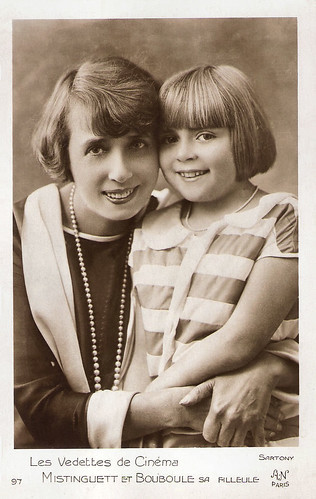
French postcard in the Les Vedettes de Cinéma series by A.N., Paris, no. 97. Photo: Sartony.
French actress and singer Mistinguett (1875-1956) captivated Paris with her risqué routines. She went on to become the most popular French entertainer of her time and the highest-paid female entertainer in the world. She appeared more than 60 times in the cinema. Bouboule was Mistinguett 's goddaughter, an admittedly talented child actress. She was born in 1917 and from 1921 on, she appeared in 13 films.
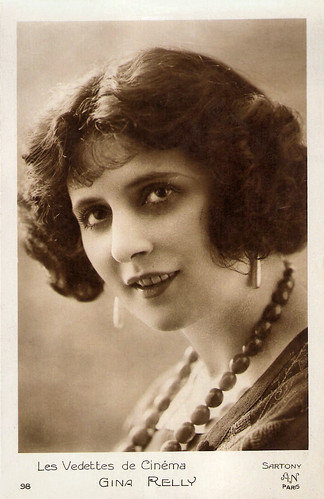
French postcard in the Les Vedettes de Cinéma series by A.N., Paris, no. 98. Photo: Sartony.
Gina Relly (1891-1985) was an actress of the French silent cinema.
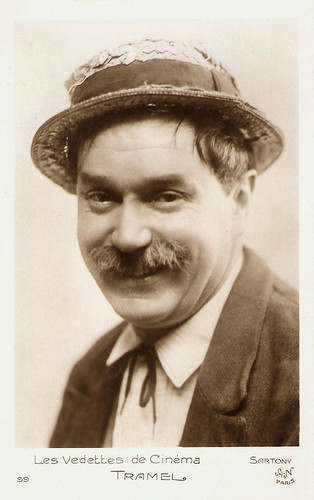
French postcard in the Les Vedettes de Cinéma series by Editions A.N., Paris, no. 99. Photo: Sartony.
Félicien Tramel (1880-1948) was a French singer and actor. He made more than 30 78’s at Odeon with such hits as 'T'en fais pas Bouboule' (Do not worry Bouboule) and 'Y me faut mon patelin' (I miss my hometown). Between 1911 and 1947 he played in dozens of films. In a series of silent and sound comedies, he starred as the character Alfred Bicard or le Bouif.
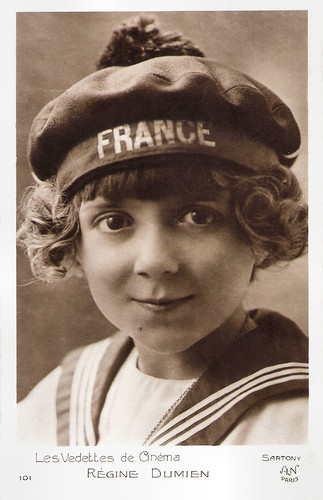
French postcard in the Les Vedettes de Cinéma series by Editions A.N., Paris, no. 101. Photo: Sartony.
Sweet 'little angel' Régine Dumien (1914-1979) was a popular child star of the French silent cinema of the early 1920s.
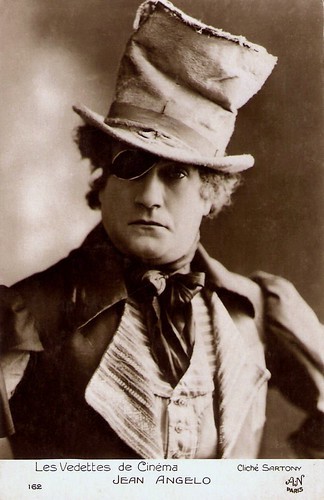
French postcard in the Les Vedettes de Cinéma series by A.N., Paris, no. 162. Photo: Sartony. Jean Angelo as Robert Macaire in Les Aventures de Robert Macaire (Jean Epstein 1925).
Distinguished, attractive, athletic Jean Angelo (1875-1933) was a superstar of the French silent cinema. He was the ultimate leading man of several adventure films of the 1920s. Jean Renoir and Jacques Feyder are among the noted directors that Angelo has worked with.
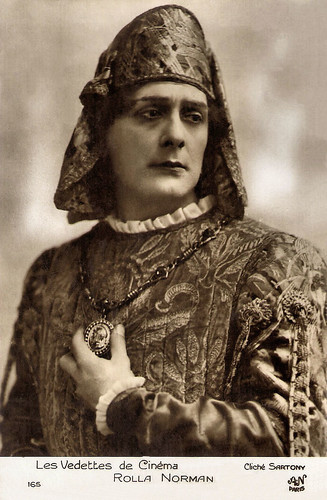
French postcard in the Les Vedettes de Cinéma series by A.N., Paris, no. 165. Photo: Sartony.
Rolla Norman (1889-1971) was a French actor in silent and sound cinema. He was also a war hero.
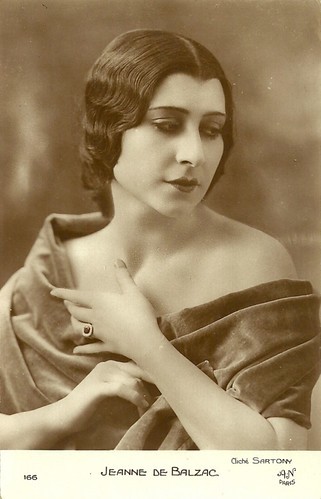
French postcard by A.N., Paris, no. 166. Photo: Sartony.
Jeanne de Balzac (1891-1930), niece of writer Honoré de Balzac, was a French silent film actress.
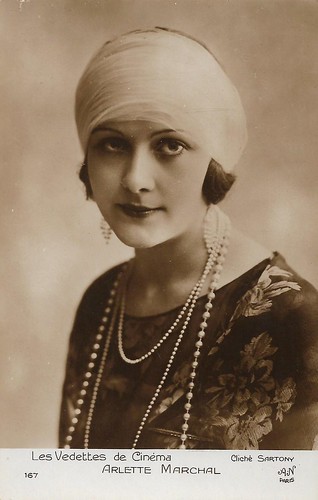
French postcard in the Les Vedettes de Cinéma series by A.N., Paris, no. 167. Photo: Sartony.
Elegant French actress Arlette Marchal (1902-1984) started out as a fashion model. Between 1922 and 1951 she starred in 41 European and American films. From the 1950s onwards, she dedicated herself mostly to her fashion enterprise.
Cinémagazine
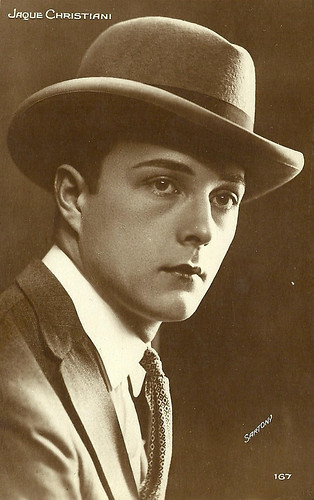
French postcard by Cinémagazine Edition, no. 167. Photo: Sartony. Collection: Didier Hanson.
Jaque Christiani had a brief film career during the 1920s. The handsome and elegant, but unknown actor debuted in a forgotten silent classic of the French avant-garde cinema.
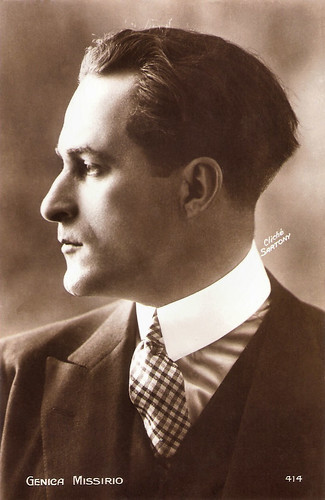
French postcard by Editions Cinémagazine, no. 414. Photo: Sartony.
Genica Missirio (1895-?) was a Romanian actor who starred in the French silent cinema of the 1920s.
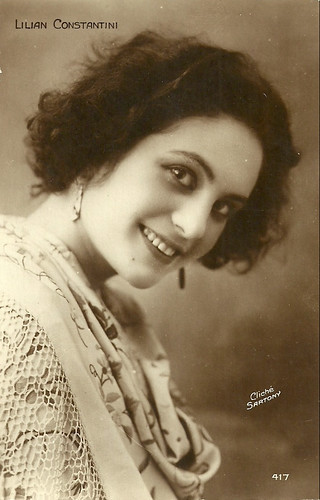
French postcard by Editions Cinémagazine, no. 417. Photo: Sartony.
Lilian Constantini (1902-1982) was a French dancer and actress, before marrying industrialist Charles Schneider.
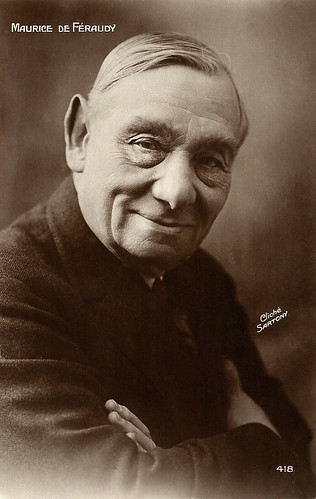
French postcard by Editions Cinémagazine, no. 418. Photo: Sartony.
Maurice de Féraudy (1859-1932) was an actor of the Comédie-Française and a French director. He was also a notable actor and director in the French silent cinema.
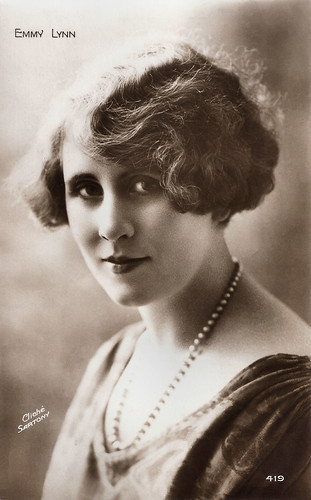
French postcard by Editions Cinémagazine, no. 419. Photo: Sartony.
Emmy Lynn (1889-1978) was a French stage and screen actress, known for her parts in the French silent films by Abel Gance, Henry Roussel, and Marcel L’Herbier.
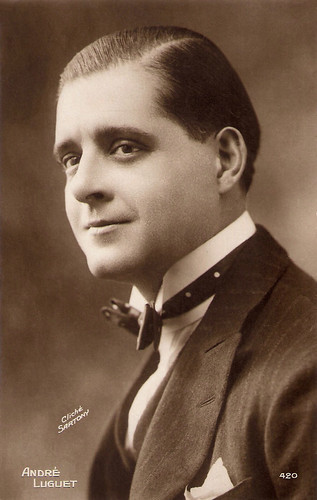
French postcard by Cinémagazine-Édition, no. 420. Photo: Sartony.
André Luguet (1892-1979) was a French stage and film actor. He appeared in over 120 films between 1910 and 1970, both in France and Hollywood.
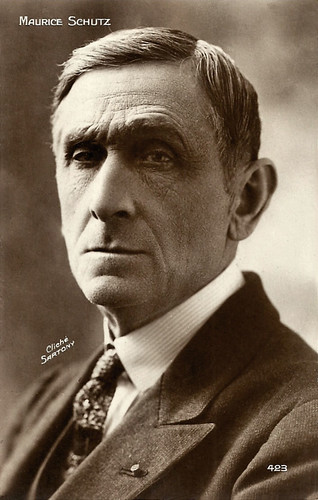
French postcard by Editions Cinémagazine, no. 423. Photo: Sartony.
Maurice Schutz (1866-1955) was a French stage and screen actor, who peaked in French silent cinema of the 1920s, in films by a.o. Dulac, Epstein, Luitz-Morat, Duvivier, Dreyer, and Poirier.
Source: Wikimedia Commons.
A. Noyer, Paris

French postcard in the Les Vedettes de Cinéma series by A.N., Paris, no. 97. Photo: Sartony.
French actress and singer Mistinguett (1875-1956) captivated Paris with her risqué routines. She went on to become the most popular French entertainer of her time and the highest-paid female entertainer in the world. She appeared more than 60 times in the cinema. Bouboule was Mistinguett 's goddaughter, an admittedly talented child actress. She was born in 1917 and from 1921 on, she appeared in 13 films.

French postcard in the Les Vedettes de Cinéma series by A.N., Paris, no. 98. Photo: Sartony.
Gina Relly (1891-1985) was an actress of the French silent cinema.

French postcard in the Les Vedettes de Cinéma series by Editions A.N., Paris, no. 99. Photo: Sartony.
Félicien Tramel (1880-1948) was a French singer and actor. He made more than 30 78’s at Odeon with such hits as 'T'en fais pas Bouboule' (Do not worry Bouboule) and 'Y me faut mon patelin' (I miss my hometown). Between 1911 and 1947 he played in dozens of films. In a series of silent and sound comedies, he starred as the character Alfred Bicard or le Bouif.

French postcard in the Les Vedettes de Cinéma series by Editions A.N., Paris, no. 101. Photo: Sartony.
Sweet 'little angel' Régine Dumien (1914-1979) was a popular child star of the French silent cinema of the early 1920s.

French postcard in the Les Vedettes de Cinéma series by A.N., Paris, no. 162. Photo: Sartony. Jean Angelo as Robert Macaire in Les Aventures de Robert Macaire (Jean Epstein 1925).
Distinguished, attractive, athletic Jean Angelo (1875-1933) was a superstar of the French silent cinema. He was the ultimate leading man of several adventure films of the 1920s. Jean Renoir and Jacques Feyder are among the noted directors that Angelo has worked with.

French postcard in the Les Vedettes de Cinéma series by A.N., Paris, no. 165. Photo: Sartony.
Rolla Norman (1889-1971) was a French actor in silent and sound cinema. He was also a war hero.

French postcard by A.N., Paris, no. 166. Photo: Sartony.
Jeanne de Balzac (1891-1930), niece of writer Honoré de Balzac, was a French silent film actress.

French postcard in the Les Vedettes de Cinéma series by A.N., Paris, no. 167. Photo: Sartony.
Elegant French actress Arlette Marchal (1902-1984) started out as a fashion model. Between 1922 and 1951 she starred in 41 European and American films. From the 1950s onwards, she dedicated herself mostly to her fashion enterprise.
Cinémagazine

French postcard by Cinémagazine Edition, no. 167. Photo: Sartony. Collection: Didier Hanson.
Jaque Christiani had a brief film career during the 1920s. The handsome and elegant, but unknown actor debuted in a forgotten silent classic of the French avant-garde cinema.

French postcard by Editions Cinémagazine, no. 414. Photo: Sartony.
Genica Missirio (1895-?) was a Romanian actor who starred in the French silent cinema of the 1920s.

French postcard by Editions Cinémagazine, no. 417. Photo: Sartony.
Lilian Constantini (1902-1982) was a French dancer and actress, before marrying industrialist Charles Schneider.

French postcard by Editions Cinémagazine, no. 418. Photo: Sartony.
Maurice de Féraudy (1859-1932) was an actor of the Comédie-Française and a French director. He was also a notable actor and director in the French silent cinema.

French postcard by Editions Cinémagazine, no. 419. Photo: Sartony.
Emmy Lynn (1889-1978) was a French stage and screen actress, known for her parts in the French silent films by Abel Gance, Henry Roussel, and Marcel L’Herbier.

French postcard by Cinémagazine-Édition, no. 420. Photo: Sartony.
André Luguet (1892-1979) was a French stage and film actor. He appeared in over 120 films between 1910 and 1970, both in France and Hollywood.

French postcard by Editions Cinémagazine, no. 423. Photo: Sartony.
Maurice Schutz (1866-1955) was a French stage and screen actor, who peaked in French silent cinema of the 1920s, in films by a.o. Dulac, Epstein, Luitz-Morat, Duvivier, Dreyer, and Poirier.
Source: Wikimedia Commons.
Published on May 20, 2020 22:00
May 19, 2020
Wanda Hendrix
Green-eyed and dark-haired American actress Wanda Hendrix (1928-1981) achieved stardom in her teens and played in about 20 films in the late 1940s and 1950s. Her first, brief marriage was to the most decorated soldier of World War II, Audie Murphy.

Dutch postcard, no. 1089. Photo: Universal International.
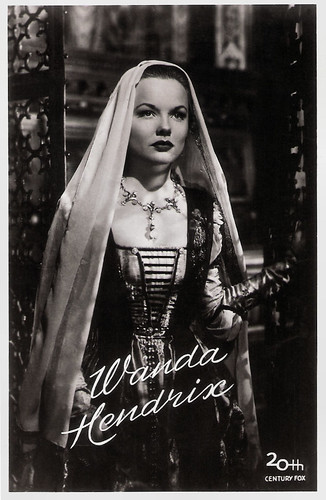
Dutch postcard, no. a.x. 276-134. Photo: 20th Century Fox. Wanda Hendrix in Prince of Foxes (Henry King, 1949).
Else, the char-girl with the thickened brogue
Dixie Wanda Hendrix was born in 1928 in Jacksonville, Florida, to Max Sylvester and Mary Faircloth Hendrix, nee Bailey. Her father was a logging camp boss who later worked for Lockheed Aircraft.
After graduation from junior high school, she joined the Jacksonville Little Theatre, where she was discovered by a Warner Brothers talent scout. The 16-years-old moved to Hollywood. She made her debut as Else, the char-girl with the thickened brogue who develops an ill-fated allegiance with Charles Boyer in Confidential Agent (Herman Shumlin, 1945).
Before she was out of her teens she had starred in several other films, including the Film Noir Nora Prentiss (Vincent Sherman, 1947) with Ann Sheridan, Robert Montgomery’s exemplary 'ultra-Noir' Ride the Pink Horse (1947) and the comedy Welcome Stranger (Elliott Nugent, 1947) with Bing Crosby.
In 1946, WW II hero-turned-actor Audie Murphy saw her on the cover of Coronet magazine and his mentor, actor James Cagney, called the magazine and got her address. Audie asked her to dinner, and they fell in love immediately. They got engaged in 1947 and promised her parents that they would defer marriage for two full years.
Her parents moved to Hollywood, where they bought a ranch. In 1949, the young couple married and the press reported: "Audie Murphy thinks his little Hendrix honey is Wanda-ful!" However, Murphy wanted her to give up filming and move with him to Texas. He had terrible nightmares from his war experiences and always had his gun with him. During 'flashback' episodes he would turn on her, once holding her at gunpoint.
In her later years, Hendrix spoke of Murphy's suffering from post-traumatic stress disorder with sympathy. Murphy had a passion for horse racing and for making big-money bets on long shots. Eventually, he gambled away all of her savings. In 1950, after 13 months of marriage, she received a divorce in 1951 in Los Angeles on the grounds of mental cruelty. The couple had no children but together they produced the Western Sierra (Alfred E. Green, 1950).
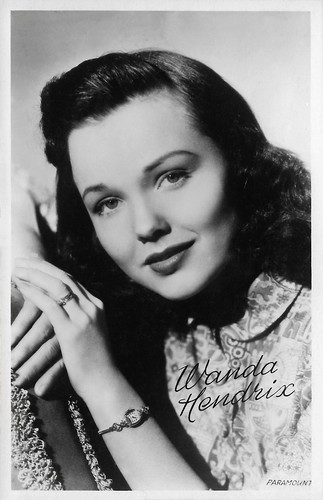
Dutch postcard. Photo: Paramount.

British postcard in the Greetings series. Photo: 20th Century Fox.
She sizzled and showed off her hips
Among Wanda Hendrix's best-known films are the comedy Miss Tatlock's Millions (Richard Haydn, 1948) with Richard Lund, The Prince of Foxes (Henry King, 1949), with Tyrone Power and Orson Welles , the drama Song of Surrender (Mitchell Leisen, 1949), the Western Saddle Tramp (Hugo Fregonese, 1950) starring Joel McCrea, and the adventure film The Highwayman (Lesley Selander, 1951) with Charles Coburn.
Later, she starred with John Derek in the action film in Sea of Lost Ships (Joseph Kane, 1953), and she sizzled and showed off her hips in the Roger Corman–produced crime drama Highway Dragnet (Nathan Juran, 1954) with Richard Conte. In 1954, she married wealthy sportsman James L. Stack, brother of the actor Robert Stack, and she briefly retired.
Her second marriage also made headlines when it came to an end in 1958 with both sides charging "mental cruelty". Hendrix went to work again, on TV mostly. One of her films in this period was the thriller Johnny Cool (William Asher, 1963) with Henry Silva. According to IMDb , she developed a drinking problem in the 1960s due to the few acting roles she was offered.
In 1969, she married Italian financier and oil company executive Steve La Monte in a single-ring ceremony at a plush suite of the Stardust Hotel in Las Vegas, Nevada. He was 34; she listed her age on the marriage license as 33. La Monte divorced her in 1979 or 1980 (the sources differ). Despite breaking up after a year of marriage with Audie Murphy, she had continued to love him and was devastated when he died suddenly in a plane crash in 1971. She considered collaborating with author Douglas Warren on an autobiography of Murphy, but it never came to fruition.
Her last role for the big screen was in the Civil War horror One Minute Before Death (Rogelio A. González, 1972), based on a short story 'The Oval Portrait' by Edgar Allan Poe. The film in which she co-starred with Barry Coe, was never theatrically released. Her final screen appearance was in an episode of the TV series Police Story (1974) with Scott Brady.
In 1981, Wanda Hendrix died of double pneumonia in Burbank, California. She was 52. Hendrix was interred at Forest Lawn Memorial Park, Hollywood Hills.
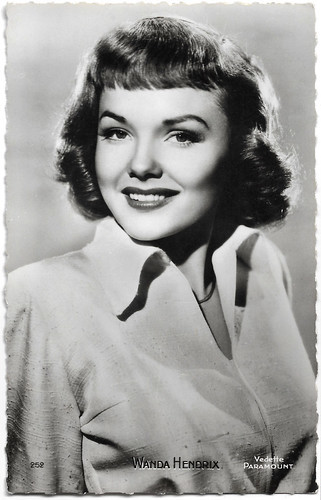
French postcard by Editions P.I., Paris, no. 252. Photo: Paramount, 1950.

Audie Murphy. German postcard by Krüger, no. 902/17.
Sources: Chuck Stephens (Film Comment), New York Times, Glamour Girls of the Silver Screen, Wikipedia and .

Dutch postcard, no. 1089. Photo: Universal International.

Dutch postcard, no. a.x. 276-134. Photo: 20th Century Fox. Wanda Hendrix in Prince of Foxes (Henry King, 1949).
Else, the char-girl with the thickened brogue
Dixie Wanda Hendrix was born in 1928 in Jacksonville, Florida, to Max Sylvester and Mary Faircloth Hendrix, nee Bailey. Her father was a logging camp boss who later worked for Lockheed Aircraft.
After graduation from junior high school, she joined the Jacksonville Little Theatre, where she was discovered by a Warner Brothers talent scout. The 16-years-old moved to Hollywood. She made her debut as Else, the char-girl with the thickened brogue who develops an ill-fated allegiance with Charles Boyer in Confidential Agent (Herman Shumlin, 1945).
Before she was out of her teens she had starred in several other films, including the Film Noir Nora Prentiss (Vincent Sherman, 1947) with Ann Sheridan, Robert Montgomery’s exemplary 'ultra-Noir' Ride the Pink Horse (1947) and the comedy Welcome Stranger (Elliott Nugent, 1947) with Bing Crosby.
In 1946, WW II hero-turned-actor Audie Murphy saw her on the cover of Coronet magazine and his mentor, actor James Cagney, called the magazine and got her address. Audie asked her to dinner, and they fell in love immediately. They got engaged in 1947 and promised her parents that they would defer marriage for two full years.
Her parents moved to Hollywood, where they bought a ranch. In 1949, the young couple married and the press reported: "Audie Murphy thinks his little Hendrix honey is Wanda-ful!" However, Murphy wanted her to give up filming and move with him to Texas. He had terrible nightmares from his war experiences and always had his gun with him. During 'flashback' episodes he would turn on her, once holding her at gunpoint.
In her later years, Hendrix spoke of Murphy's suffering from post-traumatic stress disorder with sympathy. Murphy had a passion for horse racing and for making big-money bets on long shots. Eventually, he gambled away all of her savings. In 1950, after 13 months of marriage, she received a divorce in 1951 in Los Angeles on the grounds of mental cruelty. The couple had no children but together they produced the Western Sierra (Alfred E. Green, 1950).

Dutch postcard. Photo: Paramount.

British postcard in the Greetings series. Photo: 20th Century Fox.
She sizzled and showed off her hips
Among Wanda Hendrix's best-known films are the comedy Miss Tatlock's Millions (Richard Haydn, 1948) with Richard Lund, The Prince of Foxes (Henry King, 1949), with Tyrone Power and Orson Welles , the drama Song of Surrender (Mitchell Leisen, 1949), the Western Saddle Tramp (Hugo Fregonese, 1950) starring Joel McCrea, and the adventure film The Highwayman (Lesley Selander, 1951) with Charles Coburn.
Later, she starred with John Derek in the action film in Sea of Lost Ships (Joseph Kane, 1953), and she sizzled and showed off her hips in the Roger Corman–produced crime drama Highway Dragnet (Nathan Juran, 1954) with Richard Conte. In 1954, she married wealthy sportsman James L. Stack, brother of the actor Robert Stack, and she briefly retired.
Her second marriage also made headlines when it came to an end in 1958 with both sides charging "mental cruelty". Hendrix went to work again, on TV mostly. One of her films in this period was the thriller Johnny Cool (William Asher, 1963) with Henry Silva. According to IMDb , she developed a drinking problem in the 1960s due to the few acting roles she was offered.
In 1969, she married Italian financier and oil company executive Steve La Monte in a single-ring ceremony at a plush suite of the Stardust Hotel in Las Vegas, Nevada. He was 34; she listed her age on the marriage license as 33. La Monte divorced her in 1979 or 1980 (the sources differ). Despite breaking up after a year of marriage with Audie Murphy, she had continued to love him and was devastated when he died suddenly in a plane crash in 1971. She considered collaborating with author Douglas Warren on an autobiography of Murphy, but it never came to fruition.
Her last role for the big screen was in the Civil War horror One Minute Before Death (Rogelio A. González, 1972), based on a short story 'The Oval Portrait' by Edgar Allan Poe. The film in which she co-starred with Barry Coe, was never theatrically released. Her final screen appearance was in an episode of the TV series Police Story (1974) with Scott Brady.
In 1981, Wanda Hendrix died of double pneumonia in Burbank, California. She was 52. Hendrix was interred at Forest Lawn Memorial Park, Hollywood Hills.

French postcard by Editions P.I., Paris, no. 252. Photo: Paramount, 1950.

Audie Murphy. German postcard by Krüger, no. 902/17.
Sources: Chuck Stephens (Film Comment), New York Times, Glamour Girls of the Silver Screen, Wikipedia and .
Published on May 19, 2020 22:00
May 18, 2020
Adieu Michel!
On 12 May, Michel Piccoli (1925-2020), one of the most original and versatile French actors of the last half-century, has died. He appeared in many different roles, from seducer to a cop to a gangster to Pope in more than 200 films and TV films. Among the directors he worked with are Jean Renoir, Jean-Pierre Melville, Jean-Luc Godard, Agnès Varda, Luis Buñuel, and Alfred Hitchcock. Michel Piccoli was 94.
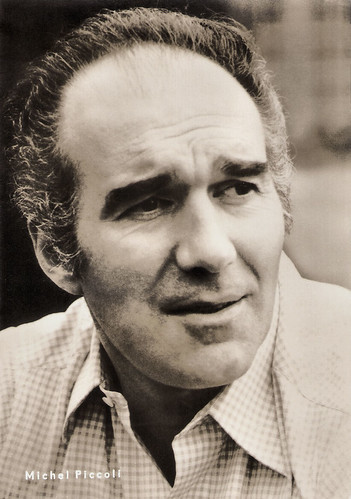
East-German postcard by VEB Progress Filmvertrieb, Berlin, no. 19/73.

Vintage postcard.
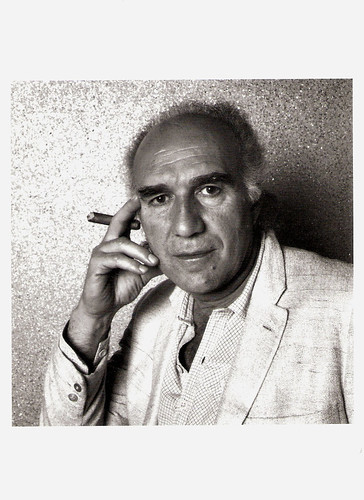
Swiss postcard by Musée de l'Elysée / News Productions, Baulmes, no. 55603. Photo: Laurence Sudre.
Contempt
Michel Piccoli was born Jacques Daniel Michel Piccoli in Paris in 1925 to a musical family. His French mother Marcelle Piccoli was a pianist and his Italian father Henri Piccoli was a violinist.
At boarding school, the introverted teenager Michel developed a profound love for the stage. He later studied drama under Andrée Bauer-Thérond and then trained as an actor at the René Simon drama school in Paris.
In 1945, he began his stage career with the Renaud-Barrault theatre company at the Théâtre de Babylone in Paris. He made his film debut in Sortilèges (Christian-Jaque, 1945), but his first proper film role was in Le Point du jour/The Mark of the Day (Louis Daquin, 1949).
Piccoli subsequently lent his talents to Jean Renoir in French Cancan (1954) starring Jean Gabin , and René Clair in Les Grandes Manoeuvres/The great manoeuvres (1955) with Gérard Philipe .
It took six more years to become ‘box office’ as a film actor with the gangster film Le Doulos/The Finger Man (Jean-Pierre Melville, 1961), starring Jean-Paul Belmondo .
He then had his international breakthrough with his leading role opposite Brigitte Bardot in Jean-Luc Godard's Le Mépris/Contempt (1963). Hal Erickson at AllMovie : “Like Hollywood's Cary Grant , Jimmy Stewart, and Gary Cooper , Piccoli was possessed of that rare gift of being able to adapt himself to virtually any kind of material without altering his essential screen persona. And like those aforementioned actors, Piccoli's talents suited the prerequisites of a wide variety of directors.”
He worked with some of the best international film auteurs: Agnès Varda at Les Créatures/The Creatures (1966) opposite Catherine Deneuve , Alain Resnais at La Guerre est finie/The War Is Over (1966), Jacques Demy at Les Demoiselles de Rochefort/The Young Girls of Rochefort (1967), and Alfred Hitchcock at Topaz (1969).

French postcard by Editions du Globe, Paris, no. 795. Photo: Studio Harcourt.

Belgian collectors card by Best, Antwerp for Victoria, Brussels, album 3, no. 501.

Dutch collectors card in the 'Filmsterren: een portret' Series by Edico-Service, no. D5 024 60-11, 1995. Photo: Collection La Cinémathèque Française. Michel Piccoli in Dillinger é morto (Marco Ferreri, 1968).
A Symbol of Bourgeois Respectability
Michel Piccoli starred in four of the best-known films of French director Claude Sautet, starting with Les Choses de la vie/The Little Things in Life (1969) with Romy Schneider . Invariably he was cast as a symbol of bourgeois respectability whose quest for personal fulfillment appears destined to end in failure.
James Travers at French Films : “Sautet did more to humanise Piccoli than perhaps any other filmmaker, particularly when the actor was cast alongside Romy Schneider (in Les Choses de la vie and Max et les Ferrailleurs), the actress who became one of Piccoli's dearest friends.”
A darker, more disturbing Piccoli can be seen in the films he made for Luis Buñuel, in particular Le Journal d'une femme de chambre/The Diary of a Chambermaid (1964), Belle de jour/Beauty of the Day (1967) and Le Charme discret de la bourgeoisie/The Discreet Charm of the Bourgeoisie (1972).
Throughout the 1970s and 1980s, Piccoli was one of the most visible faces in the European cinema, with films like Les Noces rouges/Wedding in Blood (Claude Chabrol, 1973), Themroc (Claude Faraldo, 1973), La Grande bouffe/The Big Feast (Marco Ferreri, 1973), Atlantic City (Louis Malle, 1980), and Salto nel vuoto/A Leap in the Dark (Marco Bellocchio, 1980), for which he won the Best Actor Award at the 1980 Cannes Film Festival.
In 1982, he won the Silver Bear at the 32nd Berlin International Film Festival for his chilling role in Une étrange affaire/Strange Affair (Pierre Granier-Deferre, 1981).
Both as an actor and as a producer Piccoli supported such young filmmakers as Bertrand Tavernier (Des Enfants gatés/Spoiled Children, 1977), Jacques Doillon (La Fille prodigue/The Prodigal Daughter, 1981) and Leos Carax (Mauvais sang/Bad Blood, 1986).
In 1976, Piccoli recorded his remarkable career on the page when he co-wrote a semi-autobiography, 'Dialogues égoïstes' (Egoist Dialogues). He has been married three times, first to actress Éléonore Hirt (1954-?), then for eleven years to the singer Juliette Gréco (1966-1977) and finally, from 1980 till his death to writer and actress Ludivine Clerc. He had one daughter from his first marriage, Anne-Cordélia.
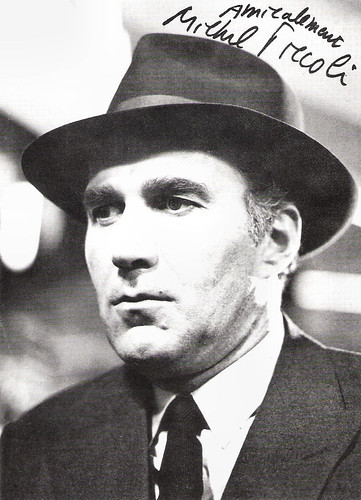
French postcard by La Roue Tourne, Paris.
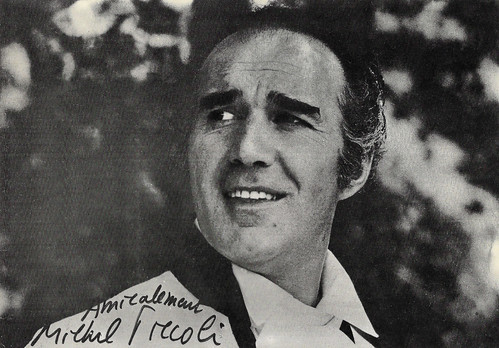
French postcard by La Roue Tourne, Paris, no. 1117.
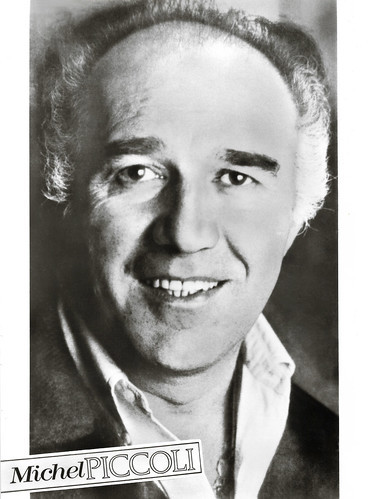
Big East-German collectors card by Progress Film-Verleih, Berlin, no. 31/83, 1983.
Mr. Cinema
In the 1980s, Michel Piccoli resumed his stage career, starring in Peter Brook's acclaimed Paris productions of Anton Chekhov's 'The Cherry Orchard' (1981, 1983) and Patrice Chéreau's staging of Pierre de Marivaux's 'La Fausse Suivante' (1985).
He continued to star in films, such as in Milou en mai/Milou in May (Louis Malle, 1990) for which he was nominated for the César. In 1991, Piccoli again won international acclaim for his portrayal of an artist suffering from a creative block in La belle noiseuse (Jacques Rivette, 1991) with Emmanuelle Béart .
Piccoli turned his hand to film directing, starting with a segment for the Amnesty International film Contre l'oubli (1991). His first feature was Alors voilà/So There (1997), followed by La Plage noire/The Black Beach (2001) with Dominique Blanc, and C'est pas tout à fait la vie dont j'avais rêvé (2005). Not surprisingly, he was chosen to impersonate Mr. Cinema in Agnès Varda's Les cent et une nuits de Simon Cinéma/The One Hundred and One Nights of Simon Cinema (1995).
He subsequently continued to do steady work in pictures of varying quality, with highlights being the psychological thriller Généalogies d'une Crime (Raul Ruiz, 1997) with Piccoli as a doctor caught up in a murder mystery, and Je rentre à la maison/I'm Going Home (Manoel de Oliveira, 2001) with Catherine Deneuve . In 2001 he was the recipient of the Europe Theatre Prize. In 2002, he supported Lionel Jospin's presidential campaign. Piccoli was vocally opposed to the Front National.
James Travers at French Films : “There is something utterly seductive about Piccoli's screen portrayals, which comes from the actor's irresistible personal charm and his ability to project, very subtly, the inner neuroses, desires, and venality of his characters. No wonder he is so well-loved by critics and audiences, and so eagerly sought after by filmmakers. Indefatigable, talented, and generous, Piccoli deserves his reputation as one of the finest actors of his generation.”
In 2012, Piccoli won the David di Donatello (the Italian Oscar) for his role as the runaway pope in the comedy-drama Habemus Papam/We Have a Pope (Nanni Moretti, 2012). Since then he made a few more films. The last one was the short fantasy Notre-Dame des Hormones/Our Lady of Hormones (Bertrand Mandico, 2015), which he narrated.
Michel Piccoli passed away on 12 May 2020 in Saint-Philbert-sur-Risle, France. He was 94.

German autograph card by Kino.
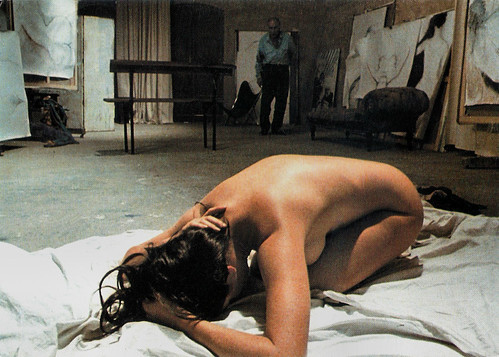
German postcard, 1991. Emmanuelle Béart and Michel Piccoli in La belle noiseuse (Jacques Rivette, 1991).
Trailer for Le Mépris/Contempt (1963). Source: The Cult Box (YouTube).
Trailer for Habemus Papam/We Have a Pope (2012). Source: Movieclips Trailers (YouTube).
Sources: James Travers (French Films), Hal Erickson (AllMovie), Wikipedia, and .

East-German postcard by VEB Progress Filmvertrieb, Berlin, no. 19/73.

Vintage postcard.

Swiss postcard by Musée de l'Elysée / News Productions, Baulmes, no. 55603. Photo: Laurence Sudre.
Contempt
Michel Piccoli was born Jacques Daniel Michel Piccoli in Paris in 1925 to a musical family. His French mother Marcelle Piccoli was a pianist and his Italian father Henri Piccoli was a violinist.
At boarding school, the introverted teenager Michel developed a profound love for the stage. He later studied drama under Andrée Bauer-Thérond and then trained as an actor at the René Simon drama school in Paris.
In 1945, he began his stage career with the Renaud-Barrault theatre company at the Théâtre de Babylone in Paris. He made his film debut in Sortilèges (Christian-Jaque, 1945), but his first proper film role was in Le Point du jour/The Mark of the Day (Louis Daquin, 1949).
Piccoli subsequently lent his talents to Jean Renoir in French Cancan (1954) starring Jean Gabin , and René Clair in Les Grandes Manoeuvres/The great manoeuvres (1955) with Gérard Philipe .
It took six more years to become ‘box office’ as a film actor with the gangster film Le Doulos/The Finger Man (Jean-Pierre Melville, 1961), starring Jean-Paul Belmondo .
He then had his international breakthrough with his leading role opposite Brigitte Bardot in Jean-Luc Godard's Le Mépris/Contempt (1963). Hal Erickson at AllMovie : “Like Hollywood's Cary Grant , Jimmy Stewart, and Gary Cooper , Piccoli was possessed of that rare gift of being able to adapt himself to virtually any kind of material without altering his essential screen persona. And like those aforementioned actors, Piccoli's talents suited the prerequisites of a wide variety of directors.”
He worked with some of the best international film auteurs: Agnès Varda at Les Créatures/The Creatures (1966) opposite Catherine Deneuve , Alain Resnais at La Guerre est finie/The War Is Over (1966), Jacques Demy at Les Demoiselles de Rochefort/The Young Girls of Rochefort (1967), and Alfred Hitchcock at Topaz (1969).

French postcard by Editions du Globe, Paris, no. 795. Photo: Studio Harcourt.

Belgian collectors card by Best, Antwerp for Victoria, Brussels, album 3, no. 501.

Dutch collectors card in the 'Filmsterren: een portret' Series by Edico-Service, no. D5 024 60-11, 1995. Photo: Collection La Cinémathèque Française. Michel Piccoli in Dillinger é morto (Marco Ferreri, 1968).
A Symbol of Bourgeois Respectability
Michel Piccoli starred in four of the best-known films of French director Claude Sautet, starting with Les Choses de la vie/The Little Things in Life (1969) with Romy Schneider . Invariably he was cast as a symbol of bourgeois respectability whose quest for personal fulfillment appears destined to end in failure.
James Travers at French Films : “Sautet did more to humanise Piccoli than perhaps any other filmmaker, particularly when the actor was cast alongside Romy Schneider (in Les Choses de la vie and Max et les Ferrailleurs), the actress who became one of Piccoli's dearest friends.”
A darker, more disturbing Piccoli can be seen in the films he made for Luis Buñuel, in particular Le Journal d'une femme de chambre/The Diary of a Chambermaid (1964), Belle de jour/Beauty of the Day (1967) and Le Charme discret de la bourgeoisie/The Discreet Charm of the Bourgeoisie (1972).
Throughout the 1970s and 1980s, Piccoli was one of the most visible faces in the European cinema, with films like Les Noces rouges/Wedding in Blood (Claude Chabrol, 1973), Themroc (Claude Faraldo, 1973), La Grande bouffe/The Big Feast (Marco Ferreri, 1973), Atlantic City (Louis Malle, 1980), and Salto nel vuoto/A Leap in the Dark (Marco Bellocchio, 1980), for which he won the Best Actor Award at the 1980 Cannes Film Festival.
In 1982, he won the Silver Bear at the 32nd Berlin International Film Festival for his chilling role in Une étrange affaire/Strange Affair (Pierre Granier-Deferre, 1981).
Both as an actor and as a producer Piccoli supported such young filmmakers as Bertrand Tavernier (Des Enfants gatés/Spoiled Children, 1977), Jacques Doillon (La Fille prodigue/The Prodigal Daughter, 1981) and Leos Carax (Mauvais sang/Bad Blood, 1986).
In 1976, Piccoli recorded his remarkable career on the page when he co-wrote a semi-autobiography, 'Dialogues égoïstes' (Egoist Dialogues). He has been married three times, first to actress Éléonore Hirt (1954-?), then for eleven years to the singer Juliette Gréco (1966-1977) and finally, from 1980 till his death to writer and actress Ludivine Clerc. He had one daughter from his first marriage, Anne-Cordélia.

French postcard by La Roue Tourne, Paris.

French postcard by La Roue Tourne, Paris, no. 1117.

Big East-German collectors card by Progress Film-Verleih, Berlin, no. 31/83, 1983.
Mr. Cinema
In the 1980s, Michel Piccoli resumed his stage career, starring in Peter Brook's acclaimed Paris productions of Anton Chekhov's 'The Cherry Orchard' (1981, 1983) and Patrice Chéreau's staging of Pierre de Marivaux's 'La Fausse Suivante' (1985).
He continued to star in films, such as in Milou en mai/Milou in May (Louis Malle, 1990) for which he was nominated for the César. In 1991, Piccoli again won international acclaim for his portrayal of an artist suffering from a creative block in La belle noiseuse (Jacques Rivette, 1991) with Emmanuelle Béart .
Piccoli turned his hand to film directing, starting with a segment for the Amnesty International film Contre l'oubli (1991). His first feature was Alors voilà/So There (1997), followed by La Plage noire/The Black Beach (2001) with Dominique Blanc, and C'est pas tout à fait la vie dont j'avais rêvé (2005). Not surprisingly, he was chosen to impersonate Mr. Cinema in Agnès Varda's Les cent et une nuits de Simon Cinéma/The One Hundred and One Nights of Simon Cinema (1995).
He subsequently continued to do steady work in pictures of varying quality, with highlights being the psychological thriller Généalogies d'une Crime (Raul Ruiz, 1997) with Piccoli as a doctor caught up in a murder mystery, and Je rentre à la maison/I'm Going Home (Manoel de Oliveira, 2001) with Catherine Deneuve . In 2001 he was the recipient of the Europe Theatre Prize. In 2002, he supported Lionel Jospin's presidential campaign. Piccoli was vocally opposed to the Front National.
James Travers at French Films : “There is something utterly seductive about Piccoli's screen portrayals, which comes from the actor's irresistible personal charm and his ability to project, very subtly, the inner neuroses, desires, and venality of his characters. No wonder he is so well-loved by critics and audiences, and so eagerly sought after by filmmakers. Indefatigable, talented, and generous, Piccoli deserves his reputation as one of the finest actors of his generation.”
In 2012, Piccoli won the David di Donatello (the Italian Oscar) for his role as the runaway pope in the comedy-drama Habemus Papam/We Have a Pope (Nanni Moretti, 2012). Since then he made a few more films. The last one was the short fantasy Notre-Dame des Hormones/Our Lady of Hormones (Bertrand Mandico, 2015), which he narrated.
Michel Piccoli passed away on 12 May 2020 in Saint-Philbert-sur-Risle, France. He was 94.

German autograph card by Kino.

German postcard, 1991. Emmanuelle Béart and Michel Piccoli in La belle noiseuse (Jacques Rivette, 1991).
Trailer for Le Mépris/Contempt (1963). Source: The Cult Box (YouTube).
Trailer for Habemus Papam/We Have a Pope (2012). Source: Movieclips Trailers (YouTube).
Sources: James Travers (French Films), Hal Erickson (AllMovie), Wikipedia, and .
Published on May 18, 2020 22:00
May 17, 2020
Olaf Storm
German actor Olaf Storm (1894-1931) appeared in supporting roles in ca. 30 silent films, including three major classics of this period. He worked often with director Franz Hofer. Storm edited a film and also produced a film.
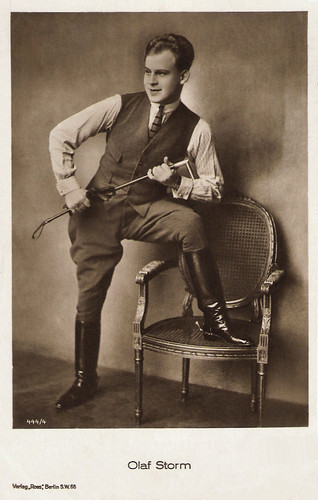
German postcard by Ross Verlag, Berlin, no. 444/4, 1919-1924.
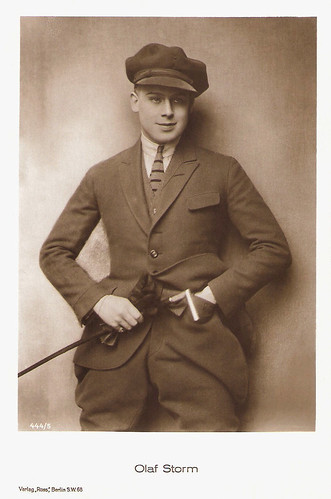
German postcard by Ross Verlag, Berlin, no. 444/5, 1919-1924.
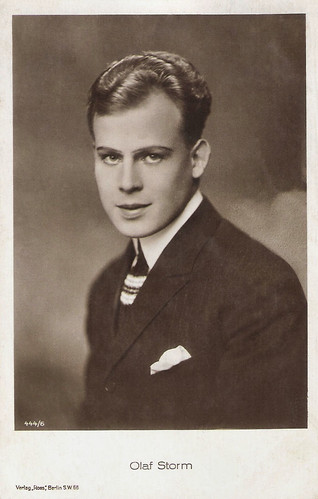
German postcard by Ross Verlag, Berlin, no. 444/6, 1919-1924.
Detective Serial
Olaf Storm was born Theodor Joseph van Kann in Richterich, Germany in 1894, according to Wikipedia . However, the sources differ: IMDb and Steffi-Line claim that he was born in Frederiksberg, Denmark.
He started his film career with a supporting part in the German production Das Erbe vom Lilienhof/The legacy of Lilienhof (Franz Hofer, 1919). Hofer had been one of the true auteurs of the early German cinema.
The Encyclopedia of European Cinema indicates that “Hofer’s work is marked by stunning formal qualities and bizarre twists of plot.” Storm played supporting parts in such Hofer films as Ferréol (Franz Hofer, 1920) with Margit Barnay and Ernst Deutsch, Ein nettes Früchtchen/A nice little fruit (Franz Hofer, 1920), and Der Riesenschmuggel/The giant smuggling (Franz Hofer, 1920) as the fiancée of Erika Glässner .
Then he got the leading role in the detective serial Nat Pinkerton im Kampf/Nat Pinkerton (Wolfgang Neff, 1920). The young Béla Lugosi played a gang leader in this film serial.
In the meanwhile, Storm kept appearing in Hofer productions, including Begierde/Desire (Franz Hofer, 1921) and the comedy Aus den Akten einer anständigen Frau/From the Files of a Respectable Woman (Franz Hofer, 1921), both with Margit Barnay.
Storm produced as well as acted in Die Minderjährige - Zu jung fürs Leben/The minors - Too young for life (Alfred Tostary, 1921) with Hanni Weisse . A year later, he both edited and acted in the drama Das Straßenmädchen von Berlin/Girl of the Berlin Streets (Richard Eichberg, 1922) with Lee Parry .
That year, he also played a supporting part as the husband in the drama Fräulein Julie/Miss Julie (Felix Basch, 1922), an adaptation of the August Strindberg play from 1888, starring Danish diva Asta Nielsen .
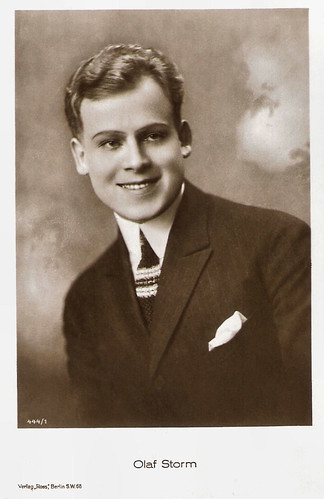
German postcard by Ross Verlag, Berlin, no. 444/1, 1919-1924.
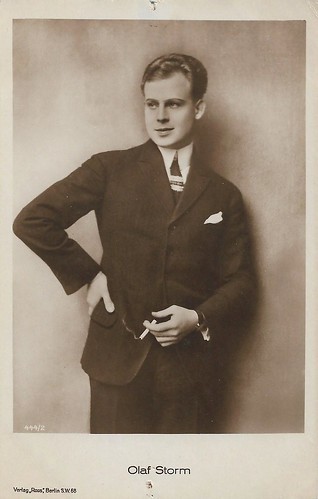
German postcard by Ross Verlag, Berlin, no. 444/2, 1919-1924.
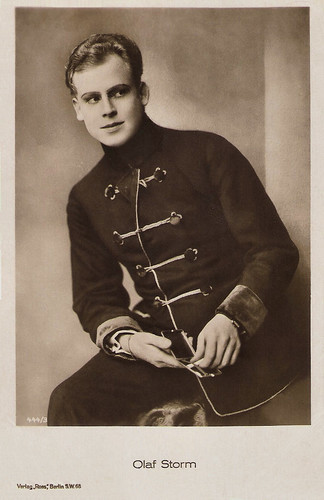
German postcard by Ross Verlag, Berlin, no. 444/3, 1919-1924.
Three Classics
Olaf Storm played small parts in three of the classics of the German silent cinema. He had an uncredited part in Fritz Lang’s Dr. Mabuse, der Spieler - Ein Bild der Zeit/Dr. Mabuse: The Gambler (1922) featuring Rudolf Klein-Rogge as the arch-criminal Dr. Mabuse.
Two years later he played a young hotel guest in Friedrich Wilhelm Murnau’s Der Letzte Mann/The Last Laugh (F.W. Murnau, 1924). Emil Jannings starred in this beautiful film as an aging hotel doorman who is fired from his prestigious position and re-assigned to the lowly position of washroom attendant.
The third classic is the Sci-Fi epic Metropolis (Fritz Lang, 1926), the biggest-budgeted film ever produced at the UFA studio. Storm played the uncredited part of Jan.
During these years he also played bigger parts in less known films. In Die Tochter des Wucherers/The daughter of the moneylender (Fritz Bernhardt, 1922), he co-starred with Lee Parry .
He had also a notable part in Die vom anderen Ufer/Those from the Other Side (Arthur Bergen, 1926) with Bruno Kastner .
His other roles were mostly smaller parts and a year later he made his last two films: the drama Verbotene Liebe/Forbidden Love (Friedrich Feher, 1927) with Magda Sonja , and Wochenendzauber/Weekend Magic (Rudolf Walther-Fein, 1927) starring Harry Liedtke . Apparently, Storm got into financial worries.
Four years later, in 1931, Olaf Storm committed suicide in Berlin at the age of 37.
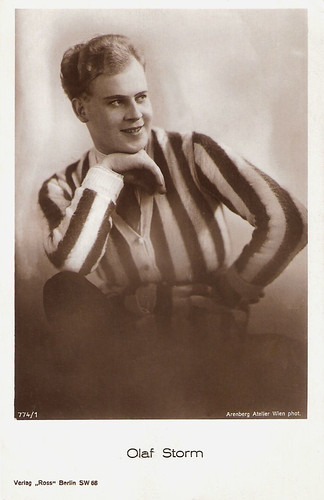
German postcard by Ross Verlag, Berlin, no. 774/1, 1925-1926. Photo: Arenberg Atelier, Wien.
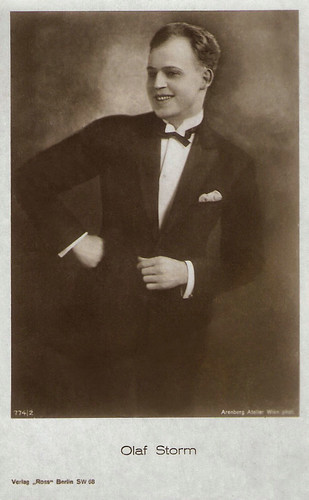
German postcard by Ross Verlag, Berlin, no. 774/2, 1925-1926. Photo: Arenberg Atelier, Wien.
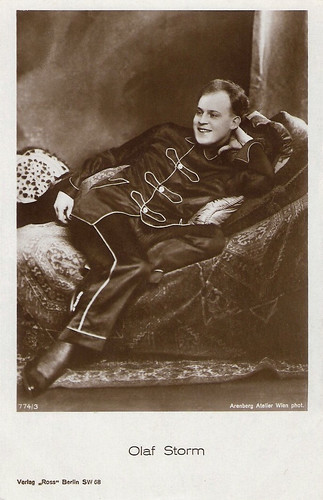
German postcard by Ross Verlag, Berlin, no. 774/3, 1925-1926. Photo: Arenberg Atelier, Wien.
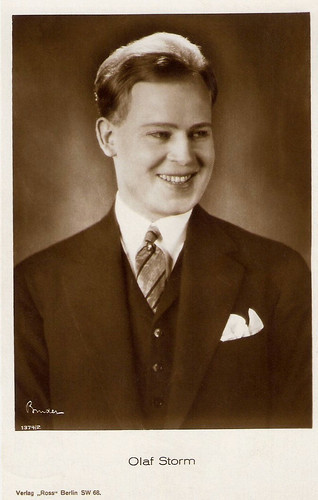
German postcard by Ross Verlag, no. 1374/2, 1927-1928. Photo: Alex Binder.
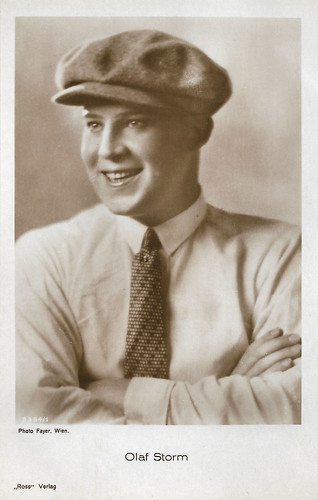
German postcard by Ross Verlag, Berlin, no. 3354/1, 1928-1929. Photo: Fayer, Wien.
Sources: Wikipedia (German and English), Stephanie D'heil (Steffi-Line - German), Thomas Staedeli (Cyranos), The Encyclopedia of European Cinema, Filmportal.de, and .

German postcard by Ross Verlag, Berlin, no. 444/4, 1919-1924.

German postcard by Ross Verlag, Berlin, no. 444/5, 1919-1924.

German postcard by Ross Verlag, Berlin, no. 444/6, 1919-1924.
Detective Serial
Olaf Storm was born Theodor Joseph van Kann in Richterich, Germany in 1894, according to Wikipedia . However, the sources differ: IMDb and Steffi-Line claim that he was born in Frederiksberg, Denmark.
He started his film career with a supporting part in the German production Das Erbe vom Lilienhof/The legacy of Lilienhof (Franz Hofer, 1919). Hofer had been one of the true auteurs of the early German cinema.
The Encyclopedia of European Cinema indicates that “Hofer’s work is marked by stunning formal qualities and bizarre twists of plot.” Storm played supporting parts in such Hofer films as Ferréol (Franz Hofer, 1920) with Margit Barnay and Ernst Deutsch, Ein nettes Früchtchen/A nice little fruit (Franz Hofer, 1920), and Der Riesenschmuggel/The giant smuggling (Franz Hofer, 1920) as the fiancée of Erika Glässner .
Then he got the leading role in the detective serial Nat Pinkerton im Kampf/Nat Pinkerton (Wolfgang Neff, 1920). The young Béla Lugosi played a gang leader in this film serial.
In the meanwhile, Storm kept appearing in Hofer productions, including Begierde/Desire (Franz Hofer, 1921) and the comedy Aus den Akten einer anständigen Frau/From the Files of a Respectable Woman (Franz Hofer, 1921), both with Margit Barnay.
Storm produced as well as acted in Die Minderjährige - Zu jung fürs Leben/The minors - Too young for life (Alfred Tostary, 1921) with Hanni Weisse . A year later, he both edited and acted in the drama Das Straßenmädchen von Berlin/Girl of the Berlin Streets (Richard Eichberg, 1922) with Lee Parry .
That year, he also played a supporting part as the husband in the drama Fräulein Julie/Miss Julie (Felix Basch, 1922), an adaptation of the August Strindberg play from 1888, starring Danish diva Asta Nielsen .

German postcard by Ross Verlag, Berlin, no. 444/1, 1919-1924.

German postcard by Ross Verlag, Berlin, no. 444/2, 1919-1924.

German postcard by Ross Verlag, Berlin, no. 444/3, 1919-1924.
Three Classics
Olaf Storm played small parts in three of the classics of the German silent cinema. He had an uncredited part in Fritz Lang’s Dr. Mabuse, der Spieler - Ein Bild der Zeit/Dr. Mabuse: The Gambler (1922) featuring Rudolf Klein-Rogge as the arch-criminal Dr. Mabuse.
Two years later he played a young hotel guest in Friedrich Wilhelm Murnau’s Der Letzte Mann/The Last Laugh (F.W. Murnau, 1924). Emil Jannings starred in this beautiful film as an aging hotel doorman who is fired from his prestigious position and re-assigned to the lowly position of washroom attendant.
The third classic is the Sci-Fi epic Metropolis (Fritz Lang, 1926), the biggest-budgeted film ever produced at the UFA studio. Storm played the uncredited part of Jan.
During these years he also played bigger parts in less known films. In Die Tochter des Wucherers/The daughter of the moneylender (Fritz Bernhardt, 1922), he co-starred with Lee Parry .
He had also a notable part in Die vom anderen Ufer/Those from the Other Side (Arthur Bergen, 1926) with Bruno Kastner .
His other roles were mostly smaller parts and a year later he made his last two films: the drama Verbotene Liebe/Forbidden Love (Friedrich Feher, 1927) with Magda Sonja , and Wochenendzauber/Weekend Magic (Rudolf Walther-Fein, 1927) starring Harry Liedtke . Apparently, Storm got into financial worries.
Four years later, in 1931, Olaf Storm committed suicide in Berlin at the age of 37.

German postcard by Ross Verlag, Berlin, no. 774/1, 1925-1926. Photo: Arenberg Atelier, Wien.

German postcard by Ross Verlag, Berlin, no. 774/2, 1925-1926. Photo: Arenberg Atelier, Wien.

German postcard by Ross Verlag, Berlin, no. 774/3, 1925-1926. Photo: Arenberg Atelier, Wien.

German postcard by Ross Verlag, no. 1374/2, 1927-1928. Photo: Alex Binder.

German postcard by Ross Verlag, Berlin, no. 3354/1, 1928-1929. Photo: Fayer, Wien.
Sources: Wikipedia (German and English), Stephanie D'heil (Steffi-Line - German), Thomas Staedeli (Cyranos), The Encyclopedia of European Cinema, Filmportal.de, and .
Published on May 17, 2020 22:00
May 16, 2020
Tom Cruise
With his charismatic smile, American actor and producer Tom Cruise (1962) became the most successful member of the Brat Pack, Hollywood's golden boys and girls of the 1980s. Top Gun (1985) made him an action star, but with his roles in The Color of Money (1986), Rain Man (1988) and Born on the Fourth of July (1989) he proved himself to be an all-round star and an excellent actor. During the 1990s, he continued to combine action blockbusters like Mission Impossibe (1996) with highly acclaimed dramas like A Few Good Men (1992), Eyes Wide Shut (1999) and Magnolia (1999). He received more praise for his roles in Minority Report (2000) and Collateral (2002) and for years, he was one of the highest paid actors in the world. Although he continued to score major box office hits with the Mission Impossible franchise, his later work was overshadowed by his outspoken attitude about Scientology which alienated him from many of his viewers.

Italian postcard by Danrose, no. 660. Photo: Fotex / R. Drechsler / G. Neri.Tom Cruise in Top Gun (Tony Scott, 1986).

French postcard, Réf. 542.
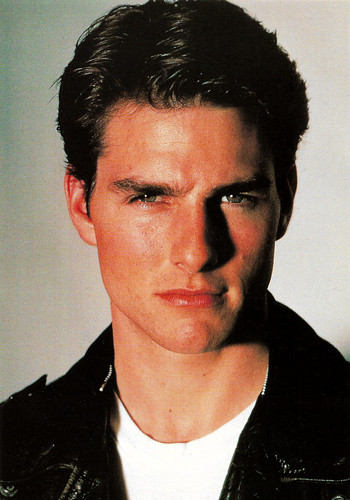
British postcard by Heroes Publishing Ltd., London, no. SPC 2894.
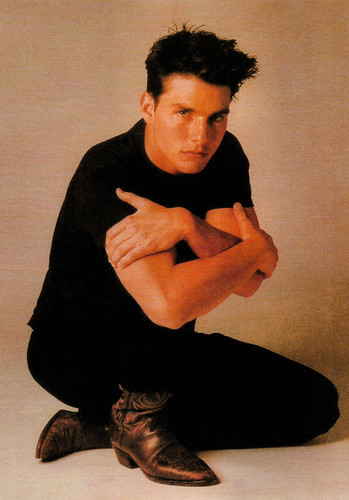
British postcard by Box Office, no. BOPC 3038. Photo: Herb Ritts, 1986.
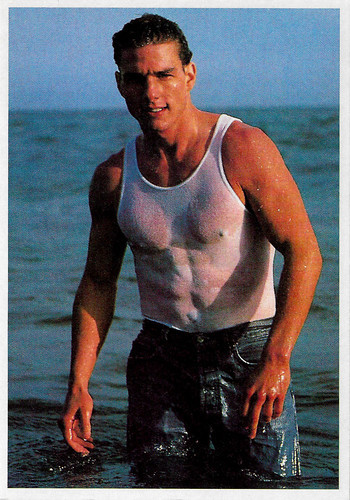
French postcard, Réf. 525. Photo: Herb Ritts.
Film-trivia infamy
Tom Cruise was born Thomas Cruise Mapother IV in 1962 in Syracuse, NY. He is the only son of Mary Lee (Pfeiffer), a special education teacher, and Thomas Cruise Mapother III, an electrical engineer. He has three sisters: Marian, Lee Anne De Vette, and Cass.
In 1974, when Cruise was 12, his parents divorced. Young Tom spent his boyhood always on the move, and by the time he was 14 he had attended 15 different schools in the U.S. and Canada. He finally settled in Glen Ridge, New Jersey, with his mother and her new husband.
Deeply religious, he enrolled in a Franciscan seminary with the ambition to join the priesthood. He dropped out after one year. At high-school, he was a wrestler until he was sidelined by a knee injury. Soon taking up acting, he found that the activity served a dual purpose: performing satiated his need for attention, while the memorisation aspect of acting helped him come to grips with his dyslexia.
Moving to New York in 1980, he studied drama at the prestigious Neighborhood Playhouse, in conjunction with the Actors Studio, New School University, New York. He signed with CAA (Creative Artists Agency) and began acting in films.
His film debut was a small part in Endless Love (Franco Zeffirelli, 1981), starring Brooke Shields. It was followed by a major supporting role as a crazed military academy student in Taps (Harold Becker, 1981), starring George C. Scott and Timothy Hutton.
In 1983, Cruise was part of the ensemble cast of The Outsiders (Francis Ford Coppola, 1983). The Hollywood press corps began touting Cruise as one of the 'Brat Pack', a group of twenty-something actors who seemed on the verge of taking over the movie industry in the early 1980s.
Cruise's first big hit was the coming-of-age comedy Risky Business (Paul Brickman, 1983), in which he entered film-trivia infamy with the scene wherein he celebrates his parents' absence by dancing around the living room in his underwear. From the outset, he exhibited an undeniable box office appeal to both male and female audiences.
Cruise played the male lead in the dark fantasy Legend (Ridley Scott, 1985) and the action film Top Gun (Tony Scott, 1986) with Kelly McGillis and Val Kilmer. Top Gun (1986) established Cruise as an action star.
However, he refused to be pigeonholed and followed it up with a solid characterisation of a fledgling pool shark in The Color of Money (Martin Scorsese, 1986), for which co-star Paul Newman earned an Academy Award. In 1988, he played the brother of an autistic savant played by Dustin Hoffman in the drama Rain Man (Barry Levinson, 1988). However, Cruise had not yet totally convinced critics he was more than a pretty face while he also starred in Cocktail (Roger Donaldson, 1988), which earned him a nomination for the Razzie Award for Worst Actor.
His chance came when he played paraplegic Vietnam vet Ron Kovic in Born on the Fourth of July (Oliver Stone, 1989). For his role, he won a Golden Globe Award and received a nomination for the Academy Award for Best Actor.
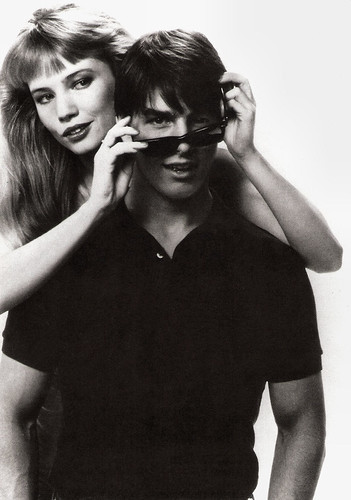
Canadian postcard by Canadian Postcard, no. A 193. Tom Cruise and Rebecca De Mornay in Risky Business (Paul Brickman, 1983).
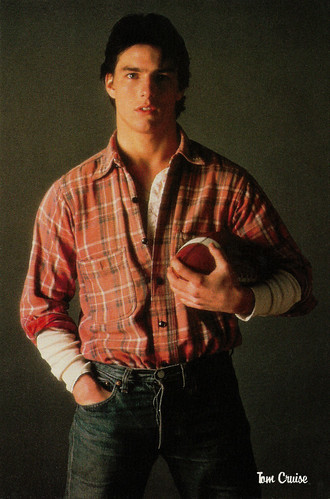
Canadian postcard by American Postcard, no. F25, 1984. Photo: Twentieth Century-Fox Film Corporation. Tom Cruise in All the Right Moves (Michael Chapman, 1983).
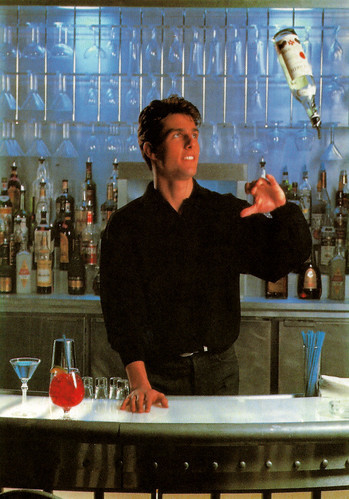
French postcard by Edition Erving, Paris, no. 743. Tom Cruise in Cocktail (Roger Donaldson, 1988).

Spanish postcard in the Collección 'Estrellas Cinematográficas' by Cacitel, no. 59, 1990. Photo: Andrea Jaffe Public Relations, Los Angeles, USA.
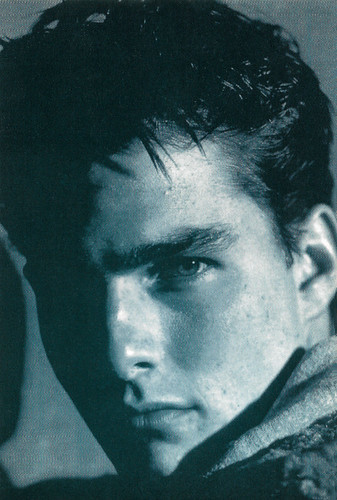
French postcard, no. C 72.
Undercutting his own leading man image
In 1990 Tom Cruise renounced his devout Catholic beliefs and embraced The Church Of Scientology claiming that Scientology teachings had cured him of dyslexia that had plagued him all of his life. He was introduced to Scientology by his ex-wife Mimi Rogers.
Though Cruise's bankability faltered a bit with the expensive disappointment Far and Away (Ron Howard, 1990) with his then-wife Nicole Kidman, A Few Good Men (Rob Reiner, 1992) brought him back into the game.
By 1994, the star was undercutting his own leading man image with the role of the slick, dastardly vampire Lestat in the long-delayed film adaptation of the Anne Rice novel Interview with the Vampire (Neil Jordan, 1994), opposite Brad Pitt and Antonio Banderas . Although the author was vehemently opposed to Cruise's casting, Rice famously reversed her decision upon seeing the actor's performance, and publicly praised Cruise's portrayal.
In 1996, Cruise scored financial success with the reboot of Mission: Impossible (Brian De Palma, 1996), but it was with his multilayered performance in Jerry Maguire (Cameron Crowe, 1996), that Cruise proved once again why he is considered a major Hollywood player. For Jerry Maguire, he won another Golden Globe and received his second Oscar nomination.
According to IMDb , Cruise is the first actor in history to star in five consecutive films that grossed $100 million in the United States: A Few Good Men (1992), the thriller The Firm (Sydney Pollack, 1993), Interview with the Vampire: The Vampire Chronicles (Neil Jordan, 1994), Mission: Impossible (Brian De Palma, 1996) and Jerry Maguire (Cameron Crowe, 1996).
1999 saw Cruise reunited onscreen with Kidman in a project of a very different sort, Eyes Wide Shut (Stanley Kubrick, 1990). Hal Erickson at AllMovie : "The film, which was the director's last, had been the subject of controversy, rumour, and speculation since it began filming. It opened to curious critics and audiences alike across the nation and was met with a violently mixed response. However, it allowed Cruise to once again take part in film history, further solidifying his position as one of Hollywood's most well-placed movers and shakers. Cruise's enviable position was again solidified later in 1999 when he earned a third Golden Globe and a nomination for the Academy Award for Best Supporting Actor for his role as a loathsome 'sexual prowess' guru in Magnolia (Paul Thomas Anderson, 1999)."

French postcard by Edycard, no. 08. Photo: Tom Cruise in Top Gun (Tony Scott, 1986).
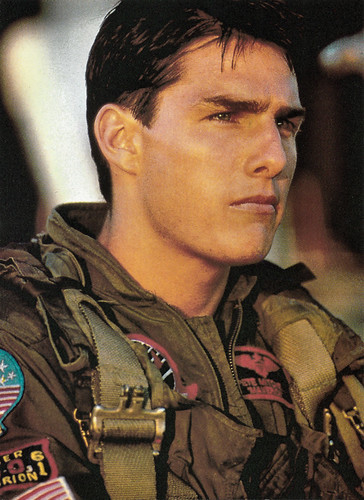
French postcard by Edycard, no. 29. Photo: Tom Cruise in Top Gun (Tony Scott, 1986).

French postcard, no. 1062. Tom Cruise in Top Gun (Tony Scott, 1986).

French postcard, no. 1063. Tom Cruise in Top Gun (Tony Scott, 1986).
A cloud of negative publicity
In 2000, Tom Cruise scored again when he returned as an international agent Ethan Hunt in Mission: Impossible II (John Woo, 2000), which proved to be one of the summer blockbusters. Like its predecessor, it was the highest-grossing film of the year and had a mixed critical reception.
He then reteamed with Jerry Maguire director Cameron Crowe for a remake of the Spanish film Abre los Ojos/Open Your Eyes (Alejandro Amenábar, 1997) titled Vanilla Sky (Cameron Crowe, 2001) with Cameron Diaz and Penelope Cruz.
Though Vanilla Sky's sometimes surreal trappings found the film receiving a mixed reception at the box office, the same could not be said for the following year's massively successful Sci-Fi chase film Minority Report (Steven Spielberg, 2001), or of the historical epic The Last Samurai (Edward Zwick, 2003).
For his next film, Cruise picked a role unlike any he'd ever played; starring as a sociopathic hitman in the psychological thriller Collateral (Michael Mann, 2004). He received major praise for his departure from the good-guy characters he'd built his career on, and for doing so convincingly.
He teamed up with Spielberg again for the second time in three years with an epic adaptation of the H.G. Wells alien invasion story War of the Worlds (Steven Spielberg, 2005). The summer blockbuster was in some ways overshadowed, however, by a cloud of negative publicity. It began, when Cruise became suddenly vocal about his beliefs in Scientology, the religion created by science fiction author L. Ron Hubbard.
Cruise publicly denounced actress Brooke Shields for taking medication to combat her postpartum depression, going so far as to call the psychological science a "Nazi science" in an Entertainment Weekly interview.
In 2005, he was interviewed by Matt Lauer for The Today Show during which time he appeared to be distractingly argumentative in his insistence that psychiatry is a "pseudoscience," and in a Der Spiegel interview, he was quoted as saying that Scientology has the only successful drug rehabilitation program in the world.
This behaviour caused a stirring of public opinion about Cruise, as did his relationship with 27-year-old actress Katie Holmes. The two announced their engagement in the spring of 2005, and Cruise's enthousiasm for his new romantic interest created more curiosity about his mental stability. He appeared on The Oprah Winfrey Show, where he jumped up and down on the couch, professing his love for the newly-Scientologist Holmes.
The actor's new public image alienated many of his viewers. As he geared up for the spring release of Mission: Impossible III (J.J. Abrams, 2006), his ability to sell a film based almost purely on his own likability was in question for the first time in 20 years. Despite this, the film was more positively received by critics than the previous films in the series and grossed nearly $400 million at the box office.
Cruise moved on to making headlines on the business front when he and corporate partner Paula Wagner in 2006 officially "took over" the United Artists studio, which was all but completely defunct. One of the first films to be produced by the new United Artists was the tense political thriller Lions for Lambs (Robert Redford, 2007), with Redford, Cruise, and Meryl Streep. The film took an earnest and unflinching look at the politics behind the Iraq war but was a commercial disappointment. This was followed by the World War II thriller Valkyrie (Bryan Singer, 2008) with Kenneth Branagh and Carice van Houten .
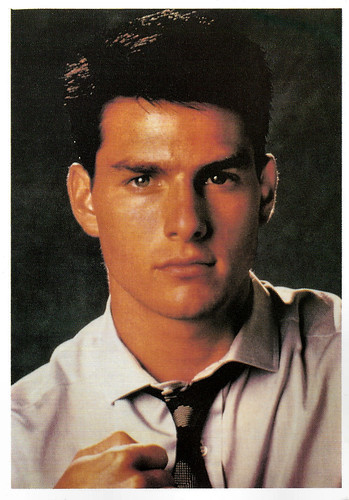
British postcard by New Line, no. 64. Photo: Transworld B.V. Entertainment.

Italian postcard by Danrose, no. 676. Photo: MGM / Shooting Star / Grazia Neri. Tom Cruise in Rain Man (Barry Levinson, 1988).

French postcard, no. C 33.
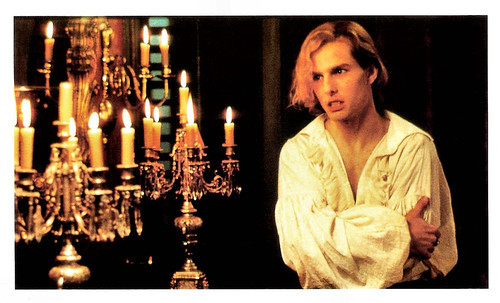
British postcard by Exclusive Collectors' Artcard. Photo: Geffen Pictures. Tom Cruise in Interview with the Vampire (Neil Jordan, 1994). Caption: The Vampire Lestat (Tom Cruise). Ageless, Immortal and Evil, he is sustained through the centuries by the blood of countless victims.
The Mission Impossible franchise
Tom Cruise would find a solid footing as the 2010s progressed, with blockbusters like Mission: Impossible - Ghost Protocol (Brad Bird, 2011) and Mission: Impossible - Rogue Nation (Christopher McQuarrie, 2015). He is known for doing many of his own stunts in these films, even exceptionally dangerous ones.
The Mission Impossible franchise earned a total of 3 billion dollars worldwide. Cruise reteamed with Cameron Diaz in the action-comedy Knight and Day (James Mangold, 2010). He starred as Jack Reacher in the film adaptation of British author Lee Child's 2005 novel One Shot (Christopher McQuarrie, 2012).
He also starred in big-budget fantasy projects like Oblivion (Joseph Kosinski, 2013) and Edge of Tomorrow (Doug Liman, 2014). Tom Cruise was married three times. His first wife was actress Mimi Rogers, with whom he was married from 1987 till their divorce in 1990.
His second marriage with Nicole Kidman from 1990 till 2001. They adopted two children Isabella Jane Cruise (1992) and Connor Antony Cruise (1995). He lived together with Vanilla Sky (2001) co-star Penélope Cruz from 2001 till 2004.
His 2006 marriage to Katie Holmes ended in divorce in 2012. They have one daughter, Surie Cruise (2006).
Recently, Cruise returned on the screen as Ethan Hunt in the sixth installment of the Mission Impossible series, Mission: Impossible – Fallout (Christopher McQuarrie, 2018). In 2020, he will also return as Pete "Maverick" Mitchell in Top Gun: Maverick (Joseph Kosinski, 2020), in which Val Kilmer will also reprise his role from the first film.
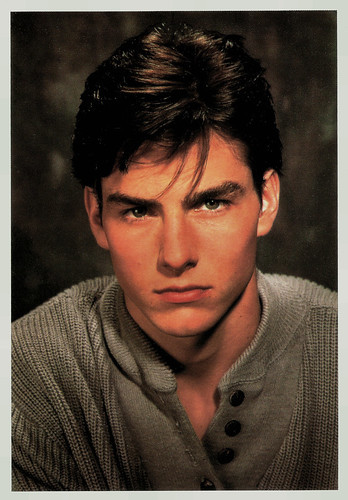
British postcard by Santoro Graphics Ltd, London, no. C243.

French postcard, no. PP 138.
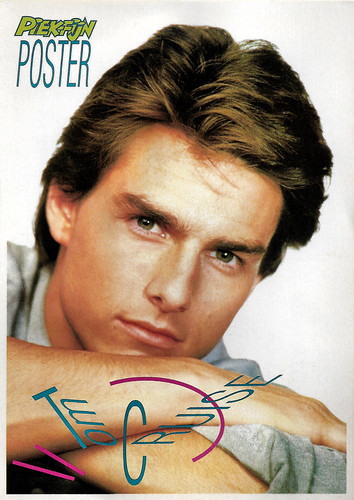
Dutch postcard by Verenigde Spaarbank, Utrecht.

British postcard by Pyramid, Leicester, no. PC 8638, 1999.
Sources: Hal Erickson (AllMovie), Wikipedia and .

Italian postcard by Danrose, no. 660. Photo: Fotex / R. Drechsler / G. Neri.Tom Cruise in Top Gun (Tony Scott, 1986).

French postcard, Réf. 542.

British postcard by Heroes Publishing Ltd., London, no. SPC 2894.

British postcard by Box Office, no. BOPC 3038. Photo: Herb Ritts, 1986.

French postcard, Réf. 525. Photo: Herb Ritts.
Film-trivia infamy
Tom Cruise was born Thomas Cruise Mapother IV in 1962 in Syracuse, NY. He is the only son of Mary Lee (Pfeiffer), a special education teacher, and Thomas Cruise Mapother III, an electrical engineer. He has three sisters: Marian, Lee Anne De Vette, and Cass.
In 1974, when Cruise was 12, his parents divorced. Young Tom spent his boyhood always on the move, and by the time he was 14 he had attended 15 different schools in the U.S. and Canada. He finally settled in Glen Ridge, New Jersey, with his mother and her new husband.
Deeply religious, he enrolled in a Franciscan seminary with the ambition to join the priesthood. He dropped out after one year. At high-school, he was a wrestler until he was sidelined by a knee injury. Soon taking up acting, he found that the activity served a dual purpose: performing satiated his need for attention, while the memorisation aspect of acting helped him come to grips with his dyslexia.
Moving to New York in 1980, he studied drama at the prestigious Neighborhood Playhouse, in conjunction with the Actors Studio, New School University, New York. He signed with CAA (Creative Artists Agency) and began acting in films.
His film debut was a small part in Endless Love (Franco Zeffirelli, 1981), starring Brooke Shields. It was followed by a major supporting role as a crazed military academy student in Taps (Harold Becker, 1981), starring George C. Scott and Timothy Hutton.
In 1983, Cruise was part of the ensemble cast of The Outsiders (Francis Ford Coppola, 1983). The Hollywood press corps began touting Cruise as one of the 'Brat Pack', a group of twenty-something actors who seemed on the verge of taking over the movie industry in the early 1980s.
Cruise's first big hit was the coming-of-age comedy Risky Business (Paul Brickman, 1983), in which he entered film-trivia infamy with the scene wherein he celebrates his parents' absence by dancing around the living room in his underwear. From the outset, he exhibited an undeniable box office appeal to both male and female audiences.
Cruise played the male lead in the dark fantasy Legend (Ridley Scott, 1985) and the action film Top Gun (Tony Scott, 1986) with Kelly McGillis and Val Kilmer. Top Gun (1986) established Cruise as an action star.
However, he refused to be pigeonholed and followed it up with a solid characterisation of a fledgling pool shark in The Color of Money (Martin Scorsese, 1986), for which co-star Paul Newman earned an Academy Award. In 1988, he played the brother of an autistic savant played by Dustin Hoffman in the drama Rain Man (Barry Levinson, 1988). However, Cruise had not yet totally convinced critics he was more than a pretty face while he also starred in Cocktail (Roger Donaldson, 1988), which earned him a nomination for the Razzie Award for Worst Actor.
His chance came when he played paraplegic Vietnam vet Ron Kovic in Born on the Fourth of July (Oliver Stone, 1989). For his role, he won a Golden Globe Award and received a nomination for the Academy Award for Best Actor.

Canadian postcard by Canadian Postcard, no. A 193. Tom Cruise and Rebecca De Mornay in Risky Business (Paul Brickman, 1983).

Canadian postcard by American Postcard, no. F25, 1984. Photo: Twentieth Century-Fox Film Corporation. Tom Cruise in All the Right Moves (Michael Chapman, 1983).

French postcard by Edition Erving, Paris, no. 743. Tom Cruise in Cocktail (Roger Donaldson, 1988).

Spanish postcard in the Collección 'Estrellas Cinematográficas' by Cacitel, no. 59, 1990. Photo: Andrea Jaffe Public Relations, Los Angeles, USA.

French postcard, no. C 72.
Undercutting his own leading man image
In 1990 Tom Cruise renounced his devout Catholic beliefs and embraced The Church Of Scientology claiming that Scientology teachings had cured him of dyslexia that had plagued him all of his life. He was introduced to Scientology by his ex-wife Mimi Rogers.
Though Cruise's bankability faltered a bit with the expensive disappointment Far and Away (Ron Howard, 1990) with his then-wife Nicole Kidman, A Few Good Men (Rob Reiner, 1992) brought him back into the game.
By 1994, the star was undercutting his own leading man image with the role of the slick, dastardly vampire Lestat in the long-delayed film adaptation of the Anne Rice novel Interview with the Vampire (Neil Jordan, 1994), opposite Brad Pitt and Antonio Banderas . Although the author was vehemently opposed to Cruise's casting, Rice famously reversed her decision upon seeing the actor's performance, and publicly praised Cruise's portrayal.
In 1996, Cruise scored financial success with the reboot of Mission: Impossible (Brian De Palma, 1996), but it was with his multilayered performance in Jerry Maguire (Cameron Crowe, 1996), that Cruise proved once again why he is considered a major Hollywood player. For Jerry Maguire, he won another Golden Globe and received his second Oscar nomination.
According to IMDb , Cruise is the first actor in history to star in five consecutive films that grossed $100 million in the United States: A Few Good Men (1992), the thriller The Firm (Sydney Pollack, 1993), Interview with the Vampire: The Vampire Chronicles (Neil Jordan, 1994), Mission: Impossible (Brian De Palma, 1996) and Jerry Maguire (Cameron Crowe, 1996).
1999 saw Cruise reunited onscreen with Kidman in a project of a very different sort, Eyes Wide Shut (Stanley Kubrick, 1990). Hal Erickson at AllMovie : "The film, which was the director's last, had been the subject of controversy, rumour, and speculation since it began filming. It opened to curious critics and audiences alike across the nation and was met with a violently mixed response. However, it allowed Cruise to once again take part in film history, further solidifying his position as one of Hollywood's most well-placed movers and shakers. Cruise's enviable position was again solidified later in 1999 when he earned a third Golden Globe and a nomination for the Academy Award for Best Supporting Actor for his role as a loathsome 'sexual prowess' guru in Magnolia (Paul Thomas Anderson, 1999)."

French postcard by Edycard, no. 08. Photo: Tom Cruise in Top Gun (Tony Scott, 1986).

French postcard by Edycard, no. 29. Photo: Tom Cruise in Top Gun (Tony Scott, 1986).

French postcard, no. 1062. Tom Cruise in Top Gun (Tony Scott, 1986).

French postcard, no. 1063. Tom Cruise in Top Gun (Tony Scott, 1986).
A cloud of negative publicity
In 2000, Tom Cruise scored again when he returned as an international agent Ethan Hunt in Mission: Impossible II (John Woo, 2000), which proved to be one of the summer blockbusters. Like its predecessor, it was the highest-grossing film of the year and had a mixed critical reception.
He then reteamed with Jerry Maguire director Cameron Crowe for a remake of the Spanish film Abre los Ojos/Open Your Eyes (Alejandro Amenábar, 1997) titled Vanilla Sky (Cameron Crowe, 2001) with Cameron Diaz and Penelope Cruz.
Though Vanilla Sky's sometimes surreal trappings found the film receiving a mixed reception at the box office, the same could not be said for the following year's massively successful Sci-Fi chase film Minority Report (Steven Spielberg, 2001), or of the historical epic The Last Samurai (Edward Zwick, 2003).
For his next film, Cruise picked a role unlike any he'd ever played; starring as a sociopathic hitman in the psychological thriller Collateral (Michael Mann, 2004). He received major praise for his departure from the good-guy characters he'd built his career on, and for doing so convincingly.
He teamed up with Spielberg again for the second time in three years with an epic adaptation of the H.G. Wells alien invasion story War of the Worlds (Steven Spielberg, 2005). The summer blockbuster was in some ways overshadowed, however, by a cloud of negative publicity. It began, when Cruise became suddenly vocal about his beliefs in Scientology, the religion created by science fiction author L. Ron Hubbard.
Cruise publicly denounced actress Brooke Shields for taking medication to combat her postpartum depression, going so far as to call the psychological science a "Nazi science" in an Entertainment Weekly interview.
In 2005, he was interviewed by Matt Lauer for The Today Show during which time he appeared to be distractingly argumentative in his insistence that psychiatry is a "pseudoscience," and in a Der Spiegel interview, he was quoted as saying that Scientology has the only successful drug rehabilitation program in the world.
This behaviour caused a stirring of public opinion about Cruise, as did his relationship with 27-year-old actress Katie Holmes. The two announced their engagement in the spring of 2005, and Cruise's enthousiasm for his new romantic interest created more curiosity about his mental stability. He appeared on The Oprah Winfrey Show, where he jumped up and down on the couch, professing his love for the newly-Scientologist Holmes.
The actor's new public image alienated many of his viewers. As he geared up for the spring release of Mission: Impossible III (J.J. Abrams, 2006), his ability to sell a film based almost purely on his own likability was in question for the first time in 20 years. Despite this, the film was more positively received by critics than the previous films in the series and grossed nearly $400 million at the box office.
Cruise moved on to making headlines on the business front when he and corporate partner Paula Wagner in 2006 officially "took over" the United Artists studio, which was all but completely defunct. One of the first films to be produced by the new United Artists was the tense political thriller Lions for Lambs (Robert Redford, 2007), with Redford, Cruise, and Meryl Streep. The film took an earnest and unflinching look at the politics behind the Iraq war but was a commercial disappointment. This was followed by the World War II thriller Valkyrie (Bryan Singer, 2008) with Kenneth Branagh and Carice van Houten .

British postcard by New Line, no. 64. Photo: Transworld B.V. Entertainment.

Italian postcard by Danrose, no. 676. Photo: MGM / Shooting Star / Grazia Neri. Tom Cruise in Rain Man (Barry Levinson, 1988).

French postcard, no. C 33.

British postcard by Exclusive Collectors' Artcard. Photo: Geffen Pictures. Tom Cruise in Interview with the Vampire (Neil Jordan, 1994). Caption: The Vampire Lestat (Tom Cruise). Ageless, Immortal and Evil, he is sustained through the centuries by the blood of countless victims.
The Mission Impossible franchise
Tom Cruise would find a solid footing as the 2010s progressed, with blockbusters like Mission: Impossible - Ghost Protocol (Brad Bird, 2011) and Mission: Impossible - Rogue Nation (Christopher McQuarrie, 2015). He is known for doing many of his own stunts in these films, even exceptionally dangerous ones.
The Mission Impossible franchise earned a total of 3 billion dollars worldwide. Cruise reteamed with Cameron Diaz in the action-comedy Knight and Day (James Mangold, 2010). He starred as Jack Reacher in the film adaptation of British author Lee Child's 2005 novel One Shot (Christopher McQuarrie, 2012).
He also starred in big-budget fantasy projects like Oblivion (Joseph Kosinski, 2013) and Edge of Tomorrow (Doug Liman, 2014). Tom Cruise was married three times. His first wife was actress Mimi Rogers, with whom he was married from 1987 till their divorce in 1990.
His second marriage with Nicole Kidman from 1990 till 2001. They adopted two children Isabella Jane Cruise (1992) and Connor Antony Cruise (1995). He lived together with Vanilla Sky (2001) co-star Penélope Cruz from 2001 till 2004.
His 2006 marriage to Katie Holmes ended in divorce in 2012. They have one daughter, Surie Cruise (2006).
Recently, Cruise returned on the screen as Ethan Hunt in the sixth installment of the Mission Impossible series, Mission: Impossible – Fallout (Christopher McQuarrie, 2018). In 2020, he will also return as Pete "Maverick" Mitchell in Top Gun: Maverick (Joseph Kosinski, 2020), in which Val Kilmer will also reprise his role from the first film.

British postcard by Santoro Graphics Ltd, London, no. C243.

French postcard, no. PP 138.

Dutch postcard by Verenigde Spaarbank, Utrecht.

British postcard by Pyramid, Leicester, no. PC 8638, 1999.
Sources: Hal Erickson (AllMovie), Wikipedia and .
Published on May 16, 2020 22:00
May 15, 2020
Found in the attic: Dutch Foto-album
A long time ago, I bought this old Dutch photo album which was in quite a bad state. I was disappointed that all the postcards had been glued into the album and that most of the stars were from Hollywood, which was not what I collected at the time. Lately, I found it in my attic and now I changed my opinion about it. The 'foto-album' gives a fine overview of the postcards that were published in the Netherlands in the late 1940s and early 1950s. The black and white cards contain glamorous Hollywood portraits and elegantly handwritten names. For this post, I scanned a selection of the cards.
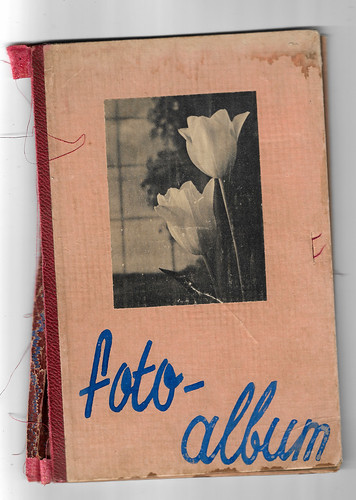
The cover of the 'Foto-album'.
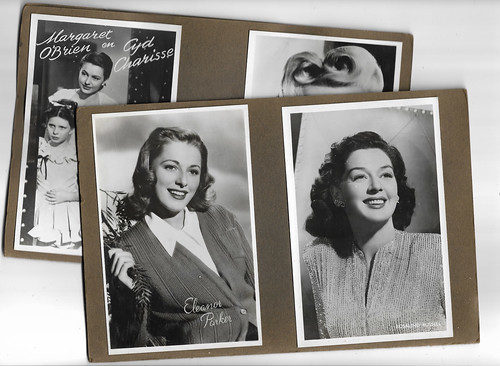
Two pages from the album.
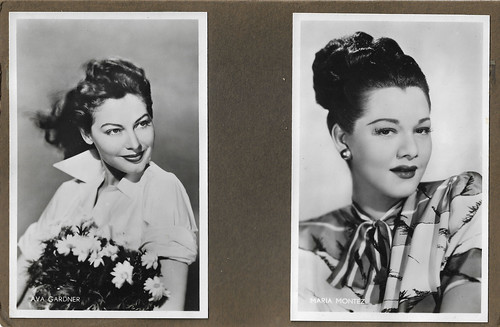
Page from the album.
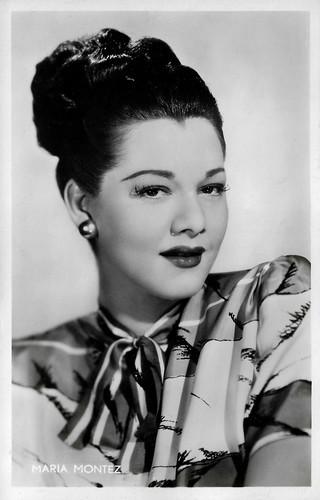
Dutch postcard.
Dominican film actress María Montez (1912-1951) gained fame and popularity as a tempestuous Latino beauty in Hollywood movies of the 1940s. In a series of exotic adventures filmed in Technicolor, she starred as Arabian princesses, jungle goddesses, and highborn gypsies, dressed in fanciful costumes and sparkling jewels. Over her career, ‘The Queen of Technicolor’ appeared in 26 films, of which five were made in Europe.
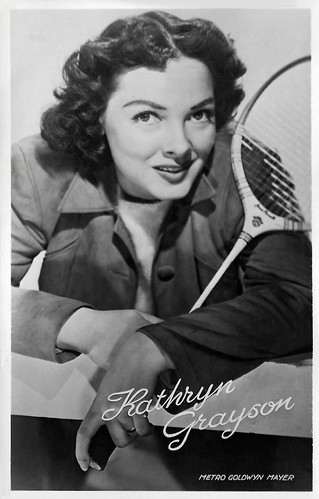
Dutch postcard. Photo: Metro Goldwyn Mayer.
American actress Kathryn Grayson (1922-2010) was a pretty, petite brunette with a heart-shaped face. During the 1940s and early 1950s, she starred in several MGM musicals with Gene Kelly and Mario Lanza. Her best-known musicals are Show Boat (1950) and Kiss Me Kate (1953).
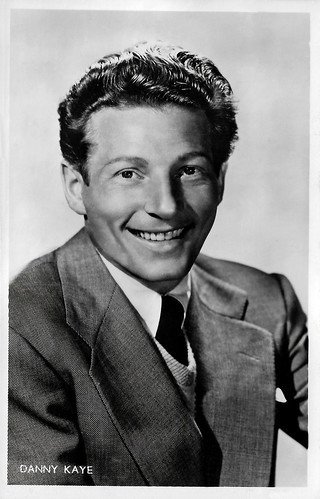
Dutch postcard.
Danny Kaye (1911-1987) was an American actor, singer, dancer, comedian, and musician. His performances featured physical comedy, idiosyncratic pantomimes, and tongue-twisting songs. In 1939, he made his Broadway debut in Straw Hat Revue, but it was the stage production of the musical Lady in the Dark in 1940 that brought him acclaim and notice from agents. Samuel Goldwyn put him in a series of Technicolor musicals, starting with Up in Arms (1944). Kaye starred in 17 movies, notably Wonder Man (1945), The Kid from Brooklyn (1946), The Secret Life of Walter Mitty (1947), The Inspector General (1949), Hans Christian Andersen (1952), White Christmas (1954) and The Court Jester (1956).
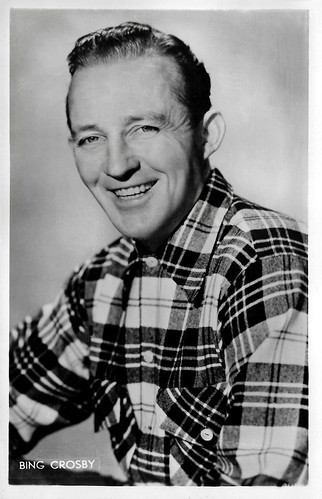
Dutch postcard.
American singer Bing Crosby (1903-1977) was a crooner whose signature song was 'White Christmas'. He often played 'happy-go-lucky fellas' in films with included the 'Road to...' comedies from 1940 to 1962, but he proved that he could act with The Country Girl (1954) opposite Grace Kelly . Crosby was a multi-media entertainer: a star on the radio, in the cinema, and in chart-topping recordings. He had 38 no. 1 singles, which surpassed Elvis Presley and The Beatles .
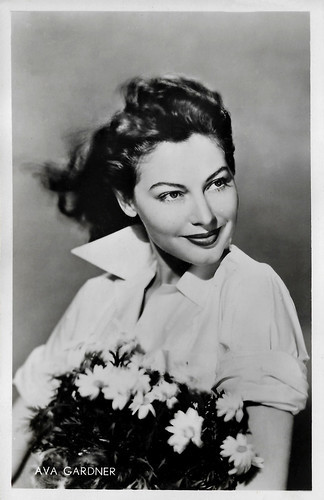
Dutch postcard.
American actress Ava Gardner (1922-1990) was signed to a contract by MGM in 1941 and appeared mainly in small roles until she drew attention with her performance in The Killers (1946). She became one of Hollywood's leading stars and was considered one of the most beautiful women of her day. She was nominated for the Academy Award for Best Actress for her work in Mogambo (1953). She appeared in several high-profile films from the 1950s to 1970s and continued to act regularly until 1986, four years before her death at the age of 67.
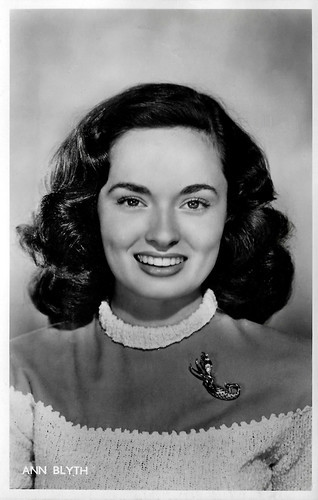
Dutch postcard.
American actress and singer Ann Blyth (1928) was often cast in Hollywood musicals, but she was also successful in dramatic roles. Her performance as Veda Pierce in Mildred Pierce (1945) was nominated for an Academy Award for Best Supporting Actress. She is one of the last surviving stars from the Golden Age of Hollywood.
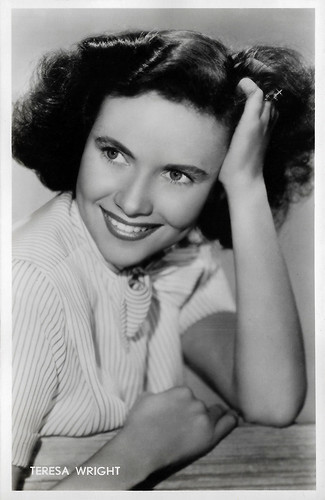
Dutch postcard, 1947.
American actress Teresa Wright (1918-2005) was nominated twice for the Oscar for Best Supporting Actress: in 1941 for her debut work in The Little Foxes, and in 1942 for Mrs. Miniver, winning for the latter. That same year, she received a nomination for the Oscar for Best Actress for her performance in The Pride of the Yankees (1942), opposite Gary Cooper . She is also known for her performances in Alfred Hitchcock's Shadow of a Doubt (1943) and William Wyler's The Best Years of Our Lives (1946).
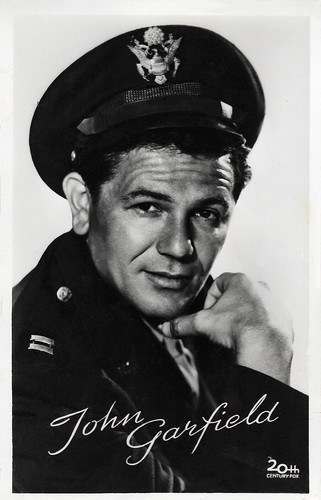
Dutch postcard. Photo: 20th Century Fox. John Garfield in Gentleman's Agreement (Elia Kazan, 1947).
American actor John Garfield (1913-1952) played brooding, rebellious, working-class characters. Called to testify before the U.S. Congressional House Committee on Un-American Activities (HUAC), he denied communist affiliation and refused to 'name names', which effectively ended his film career. The stress led to his premature death at 39 from a heart attack. Garfield is seen as a predecessor of such Method actors as Marlon Brando , Montgomery Clift, and James Dean .
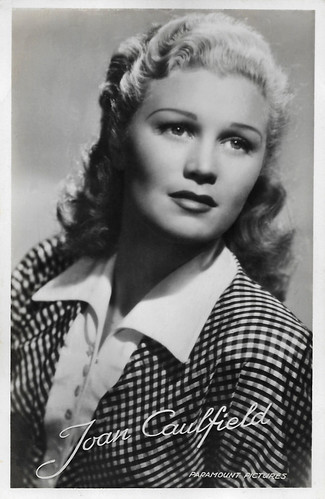
Dutch postcard. Photo: Paramount Pictures.
American actress Joan Caulfield (1922-1991) started as a fashion model. After being discovered by Broadway producers, she began a successful stage career in 1943. Paramount signed her and she starred in romantic comedies as Dear Ruth (1947) and Film Noirs like The Unsuspected (1947).
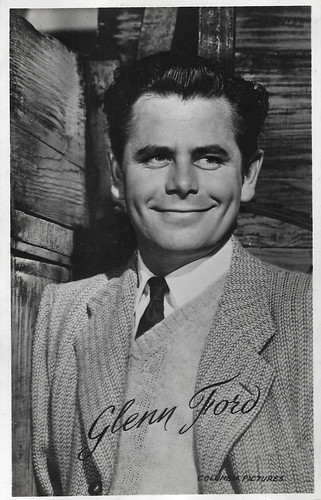
Dutch postcard. Photo: Paramount Pictures.
Glenn Ford (1916-2006) was a Canadian-American actor whose career lasted more than 50 years. Although he played different types of roles in many film genres, Ford was best known for playing ordinary men in unusual circumstances. He was one of the biggest box-office draws of the 1940s, 1950s, and 1960s. Some of his most significant roles were in the Film Noirs Gilda (1946) and The Big Heat (1953), and the high school angst film Blackboard Jungle (1955). However, it was for comedies or Westerns which he received acting laurels, including three Golden Globe Nominations for Best Actor in a Comedy, winning for Pocketful of Miracles (1961). He also played a supporting role as Clark Kent's adoptive father in Superman (1978).
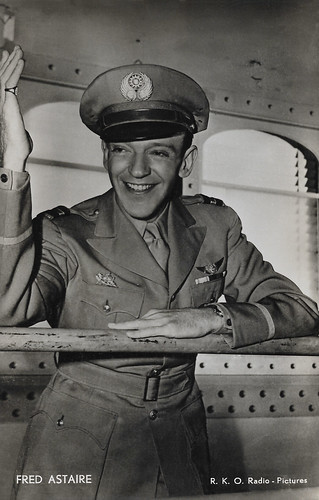
Dutch postcard. Photo: R.K.O. Radio Pictures. Fred Astaire in The Sky’s the Limit (Edward H. Griffith, 1943).
American dancer and actor Fred Astaire (1899-1987) was a unique dancer with his top hat and tails, his uncanny sense of rhythm, perfectionism, and innovation. He began his highly successful partnership with Ginger Rogers in Flying Down to Rio (1933). They danced together in 10 musicals in which he made all song and dance routines integral to the plotlines. Another innovation was that a closely tracking dolly camera filmed his dance routines in as few shots as possible.
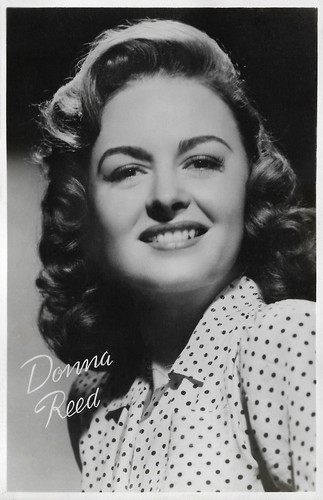
Dutch postcard.
Donna Reed (1921-1986) was an American film, television actress, and producer. Her career spanned more than 40 years, with performances in more than 40 films. She is well known for her role as Mary Hatch Bailey in Frank Capra's It's a Wonderful Life (1946). She received the Oscar for Best Supporting Actress for her role as Lorene Burke in the war drama From Here to Eternity (1953). Reed is also known as Donna Stone, a middle-class American mother, and housewife in the sitcom The Donna Reed Show (1958–1966).

Dutch postcard. Photo: Paramount.
Green-eyed and dark-haired American actress Wanda Hendrix (1928-1981) achieved stardom in her teens and played in about 20 films in the late 1940s and 1950s. Her first, brief marriage was to the most decorated soldier of World War II, Audie Murphy.
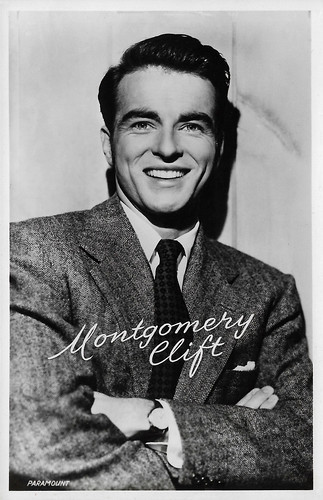
Dutch postcard.
Handsome American actor Montgomery Clift (1920-1966) was one of Hollywood's first Method actors. He starred in films like the Western Red River (1948), A Place in the Sun (1951), From Here To Eternity (1953), and Suddenly, Last Summer (1959), in which he co-starred for the third time with Elizabeth Taylor . A near-fatal auto accident in 1957 changed his looks and sent him into a drug and alcohol addiction. Clift died in 1966.
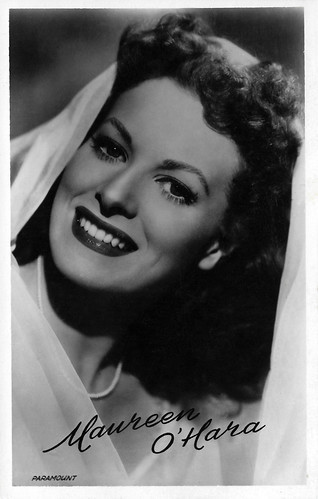
Dutch postcard. Photo: Paramount.
Irish born Maureen O’Hara (1920-2015) was one of the icons of Hollywood’s Golden Age. The feisty and fearless actress starred in John Ford’s Oscar-winning drama How Green Was My Valley (1941), set in Wales, and Ford’s Irish-set The Quiet Man (1952) opposite John Wayne . The famously red-headed actress also worked successfully with Charles Laughton at Jamaica Inn (1939) and The Hunchback of Notre Dame (1939), starred in the perennial Christmas hit Miracle on 34th Street (1947), and appeared in the Disney children’s hit The Parent Trap (1961).
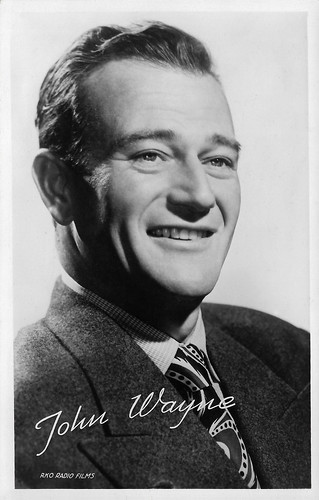
Dutch postcard. Photo: RKO Radio Films.
American actor John Wayne (1907-1979) was one of the most popular film stars of the 20th century. He received his first leading film role in The Big Trail (1930). Working with John Ford, he got his next big break in Stagecoach (1939). His career as an actor took another leap forward when he worked with director Howard Hawks in Red River (1948). Wayne won his first Academy Award in 1969. He starred in 142 films altogether and remains a popular American icon to this day.
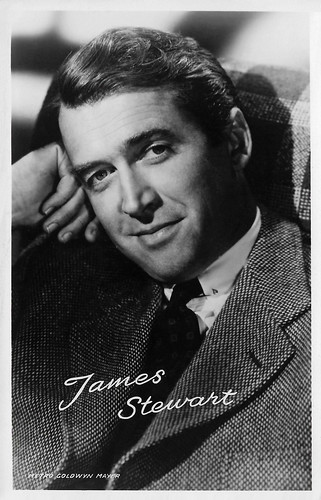
Dutch postcard. Photo: Metro Goldwyn Mayer.
American actor James Stewart (1908-1997) is among the most honored and popular stars in film history. Known for his distinctive drawl and everyman screen persona, Stewart had a film career that spanned over 55 years and 80 films.

Dutch postcard. Photo: RKO Radio Films.
Handsome, suave English-American actor Cary Grant (1904-1986) became one of Hollywood's definitive classic leading men, known for his debonair demeanour. Grant’s best-known films include Bringing Up Baby (1938), The Philadelphia Story (1940), His Girl Friday (1940), Notorious (1946), An Affair to Remember (1957), North by Northwest (1959), and Charade (1963).
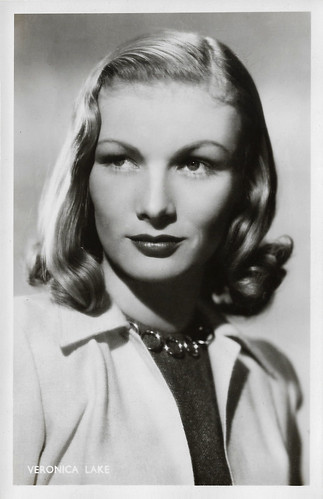
Dutch postcard.
During the 1940s, Veronica Lake (1922-1973) was Hollywood' s Peek-a-boo Girl. We love her for Preston Sturges' Sullivan's Travels (1942), Rene Clair's I Married a Witch (1942) and for her femme fatale roles opposite Alan Ladd in the Film Noirs This Gun for Hire (1942), The Glass Key (1942), and The Blue Dahlia (1946).
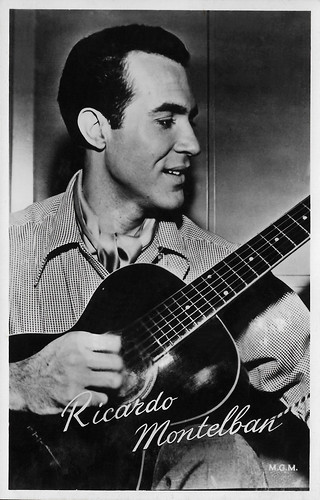
Dutch postcard. Photo: M.G.M.
Handsome Mexican actor Ricardo Montalban (1920-2009) was the epitome of elegance, charm, and grace on film, stage, and television. In the late 1940s and early 1950s, he reinvigorated the Latin Lover style in Hollywood without achieving top screen stardom. He fought to upscale the Latin image in Hollywood and this may have cost him a number of roles along the way, but he gained respect and a solid reputation and provided wider-range opportunities for Spanish-speaking actors. Montalban is probably best remembered for his starring role as the mysterious Mr. Roarke on the TV series Fantasy Island (1977–1984), with Hervé Villechaize as his partner Tatto, and as Grandfather Valentin in the Spy Kids franchise.
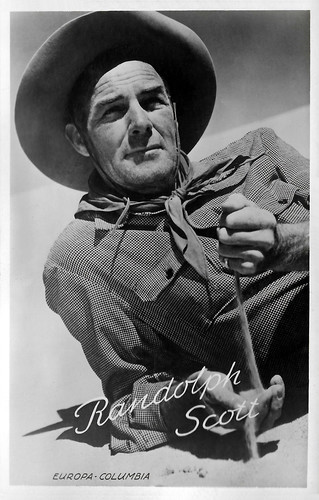
Dutch postcard. Photo: Europa - Columbia.
Randolph Scott (1898-1987) was a handsome American leading man who developed into one of Hollywood's greatest and most popular Western stars. From 1950 till 1953, he was among America's Top 10 box-office draws.
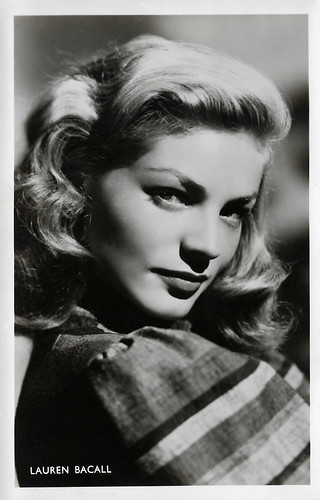
Dutch postcard.
At 19, American film actress Lauren Bacall (1924–2014) became an overnight star as 'Slim' opposite Humphrey Bogart in her memorable film debut in Howard Hawks' To Have and Have Not (1942). She became known for her distinctive husky voice and glamorous looks in film noirs as The Big Sleep (1946), Dark Passage (1947), and Key Largo (1948), and the delicious comedy How to Marry a Millionaire (1953) with Marilyn Monroe . After a 50-year career, she received a Golden Globe and her first Oscar nomination for supporting actress for her role as Barbra Streisand’s mother in The Mirror Has Two Faces (1997).
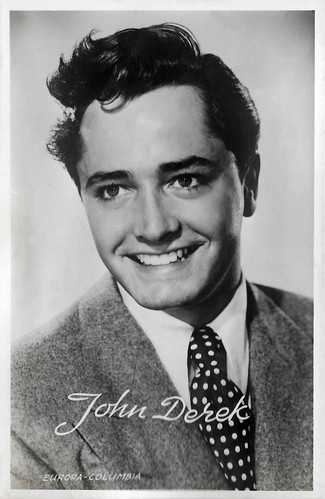
Dutch postcard. Photo: Europa - Columbia.
American actor and director John Derek (1926-1998) was known for such films as Since You Went Away (John Cromwell, 1944), All the King's Men (Robert Rossen, 1949), and Cecil B. De Mille's The Ten Commandments (1956), and for his marriages to Ursula Andress , Linda Evans, and Bo Derek.
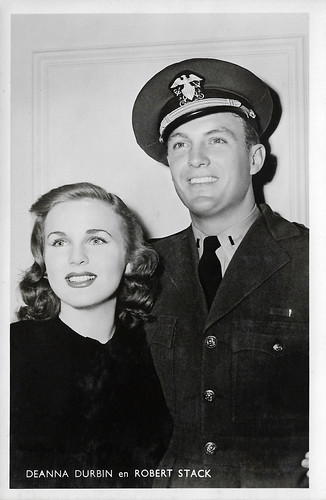
Dutch postcard. Deanna Durbin and Robert Stack in Nice Girl? (William A. Seiter, 1941).
When Deanna Durbin's (1921-2013) Three Smart Girls (Henry Koster, 1936), the first of her 21 starring vehicles, was released in 1936 it was an immediate sensation, and her films for Universal are said to have saved the studio from bankruptcy.

The cover of the 'Foto-album'.

Two pages from the album.

Page from the album.

Dutch postcard.
Dominican film actress María Montez (1912-1951) gained fame and popularity as a tempestuous Latino beauty in Hollywood movies of the 1940s. In a series of exotic adventures filmed in Technicolor, she starred as Arabian princesses, jungle goddesses, and highborn gypsies, dressed in fanciful costumes and sparkling jewels. Over her career, ‘The Queen of Technicolor’ appeared in 26 films, of which five were made in Europe.

Dutch postcard. Photo: Metro Goldwyn Mayer.
American actress Kathryn Grayson (1922-2010) was a pretty, petite brunette with a heart-shaped face. During the 1940s and early 1950s, she starred in several MGM musicals with Gene Kelly and Mario Lanza. Her best-known musicals are Show Boat (1950) and Kiss Me Kate (1953).

Dutch postcard.
Danny Kaye (1911-1987) was an American actor, singer, dancer, comedian, and musician. His performances featured physical comedy, idiosyncratic pantomimes, and tongue-twisting songs. In 1939, he made his Broadway debut in Straw Hat Revue, but it was the stage production of the musical Lady in the Dark in 1940 that brought him acclaim and notice from agents. Samuel Goldwyn put him in a series of Technicolor musicals, starting with Up in Arms (1944). Kaye starred in 17 movies, notably Wonder Man (1945), The Kid from Brooklyn (1946), The Secret Life of Walter Mitty (1947), The Inspector General (1949), Hans Christian Andersen (1952), White Christmas (1954) and The Court Jester (1956).

Dutch postcard.
American singer Bing Crosby (1903-1977) was a crooner whose signature song was 'White Christmas'. He often played 'happy-go-lucky fellas' in films with included the 'Road to...' comedies from 1940 to 1962, but he proved that he could act with The Country Girl (1954) opposite Grace Kelly . Crosby was a multi-media entertainer: a star on the radio, in the cinema, and in chart-topping recordings. He had 38 no. 1 singles, which surpassed Elvis Presley and The Beatles .

Dutch postcard.
American actress Ava Gardner (1922-1990) was signed to a contract by MGM in 1941 and appeared mainly in small roles until she drew attention with her performance in The Killers (1946). She became one of Hollywood's leading stars and was considered one of the most beautiful women of her day. She was nominated for the Academy Award for Best Actress for her work in Mogambo (1953). She appeared in several high-profile films from the 1950s to 1970s and continued to act regularly until 1986, four years before her death at the age of 67.

Dutch postcard.
American actress and singer Ann Blyth (1928) was often cast in Hollywood musicals, but she was also successful in dramatic roles. Her performance as Veda Pierce in Mildred Pierce (1945) was nominated for an Academy Award for Best Supporting Actress. She is one of the last surviving stars from the Golden Age of Hollywood.

Dutch postcard, 1947.
American actress Teresa Wright (1918-2005) was nominated twice for the Oscar for Best Supporting Actress: in 1941 for her debut work in The Little Foxes, and in 1942 for Mrs. Miniver, winning for the latter. That same year, she received a nomination for the Oscar for Best Actress for her performance in The Pride of the Yankees (1942), opposite Gary Cooper . She is also known for her performances in Alfred Hitchcock's Shadow of a Doubt (1943) and William Wyler's The Best Years of Our Lives (1946).

Dutch postcard. Photo: 20th Century Fox. John Garfield in Gentleman's Agreement (Elia Kazan, 1947).
American actor John Garfield (1913-1952) played brooding, rebellious, working-class characters. Called to testify before the U.S. Congressional House Committee on Un-American Activities (HUAC), he denied communist affiliation and refused to 'name names', which effectively ended his film career. The stress led to his premature death at 39 from a heart attack. Garfield is seen as a predecessor of such Method actors as Marlon Brando , Montgomery Clift, and James Dean .

Dutch postcard. Photo: Paramount Pictures.
American actress Joan Caulfield (1922-1991) started as a fashion model. After being discovered by Broadway producers, she began a successful stage career in 1943. Paramount signed her and she starred in romantic comedies as Dear Ruth (1947) and Film Noirs like The Unsuspected (1947).

Dutch postcard. Photo: Paramount Pictures.
Glenn Ford (1916-2006) was a Canadian-American actor whose career lasted more than 50 years. Although he played different types of roles in many film genres, Ford was best known for playing ordinary men in unusual circumstances. He was one of the biggest box-office draws of the 1940s, 1950s, and 1960s. Some of his most significant roles were in the Film Noirs Gilda (1946) and The Big Heat (1953), and the high school angst film Blackboard Jungle (1955). However, it was for comedies or Westerns which he received acting laurels, including three Golden Globe Nominations for Best Actor in a Comedy, winning for Pocketful of Miracles (1961). He also played a supporting role as Clark Kent's adoptive father in Superman (1978).

Dutch postcard. Photo: R.K.O. Radio Pictures. Fred Astaire in The Sky’s the Limit (Edward H. Griffith, 1943).
American dancer and actor Fred Astaire (1899-1987) was a unique dancer with his top hat and tails, his uncanny sense of rhythm, perfectionism, and innovation. He began his highly successful partnership with Ginger Rogers in Flying Down to Rio (1933). They danced together in 10 musicals in which he made all song and dance routines integral to the plotlines. Another innovation was that a closely tracking dolly camera filmed his dance routines in as few shots as possible.

Dutch postcard.
Donna Reed (1921-1986) was an American film, television actress, and producer. Her career spanned more than 40 years, with performances in more than 40 films. She is well known for her role as Mary Hatch Bailey in Frank Capra's It's a Wonderful Life (1946). She received the Oscar for Best Supporting Actress for her role as Lorene Burke in the war drama From Here to Eternity (1953). Reed is also known as Donna Stone, a middle-class American mother, and housewife in the sitcom The Donna Reed Show (1958–1966).

Dutch postcard. Photo: Paramount.
Green-eyed and dark-haired American actress Wanda Hendrix (1928-1981) achieved stardom in her teens and played in about 20 films in the late 1940s and 1950s. Her first, brief marriage was to the most decorated soldier of World War II, Audie Murphy.

Dutch postcard.
Handsome American actor Montgomery Clift (1920-1966) was one of Hollywood's first Method actors. He starred in films like the Western Red River (1948), A Place in the Sun (1951), From Here To Eternity (1953), and Suddenly, Last Summer (1959), in which he co-starred for the third time with Elizabeth Taylor . A near-fatal auto accident in 1957 changed his looks and sent him into a drug and alcohol addiction. Clift died in 1966.

Dutch postcard. Photo: Paramount.
Irish born Maureen O’Hara (1920-2015) was one of the icons of Hollywood’s Golden Age. The feisty and fearless actress starred in John Ford’s Oscar-winning drama How Green Was My Valley (1941), set in Wales, and Ford’s Irish-set The Quiet Man (1952) opposite John Wayne . The famously red-headed actress also worked successfully with Charles Laughton at Jamaica Inn (1939) and The Hunchback of Notre Dame (1939), starred in the perennial Christmas hit Miracle on 34th Street (1947), and appeared in the Disney children’s hit The Parent Trap (1961).

Dutch postcard. Photo: RKO Radio Films.
American actor John Wayne (1907-1979) was one of the most popular film stars of the 20th century. He received his first leading film role in The Big Trail (1930). Working with John Ford, he got his next big break in Stagecoach (1939). His career as an actor took another leap forward when he worked with director Howard Hawks in Red River (1948). Wayne won his first Academy Award in 1969. He starred in 142 films altogether and remains a popular American icon to this day.

Dutch postcard. Photo: Metro Goldwyn Mayer.
American actor James Stewart (1908-1997) is among the most honored and popular stars in film history. Known for his distinctive drawl and everyman screen persona, Stewart had a film career that spanned over 55 years and 80 films.

Dutch postcard. Photo: RKO Radio Films.
Handsome, suave English-American actor Cary Grant (1904-1986) became one of Hollywood's definitive classic leading men, known for his debonair demeanour. Grant’s best-known films include Bringing Up Baby (1938), The Philadelphia Story (1940), His Girl Friday (1940), Notorious (1946), An Affair to Remember (1957), North by Northwest (1959), and Charade (1963).

Dutch postcard.
During the 1940s, Veronica Lake (1922-1973) was Hollywood' s Peek-a-boo Girl. We love her for Preston Sturges' Sullivan's Travels (1942), Rene Clair's I Married a Witch (1942) and for her femme fatale roles opposite Alan Ladd in the Film Noirs This Gun for Hire (1942), The Glass Key (1942), and The Blue Dahlia (1946).

Dutch postcard. Photo: M.G.M.
Handsome Mexican actor Ricardo Montalban (1920-2009) was the epitome of elegance, charm, and grace on film, stage, and television. In the late 1940s and early 1950s, he reinvigorated the Latin Lover style in Hollywood without achieving top screen stardom. He fought to upscale the Latin image in Hollywood and this may have cost him a number of roles along the way, but he gained respect and a solid reputation and provided wider-range opportunities for Spanish-speaking actors. Montalban is probably best remembered for his starring role as the mysterious Mr. Roarke on the TV series Fantasy Island (1977–1984), with Hervé Villechaize as his partner Tatto, and as Grandfather Valentin in the Spy Kids franchise.

Dutch postcard. Photo: Europa - Columbia.
Randolph Scott (1898-1987) was a handsome American leading man who developed into one of Hollywood's greatest and most popular Western stars. From 1950 till 1953, he was among America's Top 10 box-office draws.

Dutch postcard.
At 19, American film actress Lauren Bacall (1924–2014) became an overnight star as 'Slim' opposite Humphrey Bogart in her memorable film debut in Howard Hawks' To Have and Have Not (1942). She became known for her distinctive husky voice and glamorous looks in film noirs as The Big Sleep (1946), Dark Passage (1947), and Key Largo (1948), and the delicious comedy How to Marry a Millionaire (1953) with Marilyn Monroe . After a 50-year career, she received a Golden Globe and her first Oscar nomination for supporting actress for her role as Barbra Streisand’s mother in The Mirror Has Two Faces (1997).

Dutch postcard. Photo: Europa - Columbia.
American actor and director John Derek (1926-1998) was known for such films as Since You Went Away (John Cromwell, 1944), All the King's Men (Robert Rossen, 1949), and Cecil B. De Mille's The Ten Commandments (1956), and for his marriages to Ursula Andress , Linda Evans, and Bo Derek.

Dutch postcard. Deanna Durbin and Robert Stack in Nice Girl? (William A. Seiter, 1941).
When Deanna Durbin's (1921-2013) Three Smart Girls (Henry Koster, 1936), the first of her 21 starring vehicles, was released in 1936 it was an immediate sensation, and her films for Universal are said to have saved the studio from bankruptcy.
Published on May 15, 2020 22:00
Paul van Yperen's Blog
- Paul van Yperen's profile
- 13 followers
Paul van Yperen isn't a Goodreads Author
(yet),
but they
do have a blog,
so here are some recent posts imported from
their feed.



